World War Ii
 From Rationalwiki
From Rationalwiki 
| It never changes War |
| A view to kill |
v - t - e
|
“”In the magazines war seemed romantic and exciting, full of heroics and vitality... I saw instead men suffering and wishing they were somewhere else.
|
| —Ernie Pyle, American war correspondent.[1] |
World War II (abbr. WWII or WW2), also known as the Second World War, the Great Patriotic War (in Russia), or just "The Sequel" was a titanic global conflict that began in 1939 and lasted until 1945. It also could arguably have begun with the conflicts between Japan and China in 1937 or as far back as 1931.[2][3][4][5][6][7][8] The war left about 85 million people dead, 45 million of whom were civilians,[9] and was also the first and (hopefully so far) only conflict which saw the use of nuclear weapons.
This massive fuckup had a multitude of causes. For one reason or another, multiple nations had fallen to fascism, an ideology which itself made war highly likely due to its irredentist nature. The relative lack of historical success in imperialism led nations like Italy and Japan to start biting chunks out of their neighbors, while Adolf Hitler and the Nazi Party seized power in Germany to begin crushing minorities. The democracies of Western Europe, haunted by the recent memory of World War One, were largely unwilling to stand up to the aggressive fascist leaders. Meanwhile the nation that had done most of the allies' dying in the First World War, Russia, had become the communist Soviet Union.
Before and during the war, most nations of the world aligned with one or the other of the war's two massive military alliances. The Axis Powers were composed of the fascists and their allies, and they sought to carve themselves new empires and destroy communism. Standing against them were the Allied Powers, which sought to stop the Axis. Among the latter were nations such as France, the British Empire, Poland, the Low Countries, and eventually the United States.
The war happened concurrently with the Holocaust, which was Nazi Germany's attempt to murder various ethnic, sexual, and ideological minorities, most significantly Europe's Jews. Imperial Japan also added some notorious chapters to the war with war crimes such as the Rape of Nanjing, the actions of Unit 731, the abuse of comfort women, and employing kamikaze suicide strikes.
The Allied victory once again reshaped the world map. The Soviet Union sliced up Eastern and Central Europe to create its club of puppet states called the Eastern Bloc. Germany, Italy, and Japan were all cut down to size. Unfortunately, the end of the war created as many problems as it solved. Tensions between the communist east and capitalist west led to the Cold War, during which the US and USSR destabilized much of the world. Mao Zedong's Chinese communists and Chiang Kai-shek's Chinese nationalists, who had cooperated against Japan, went back to killing each other in the Chinese Civil War. Korea was separated between North and South by the Soviet Union and the United States. Horrified by the Holocaust, the Allies put some Nazi war criminals on trial in Nuremberg and created Israel as a home for the Jewish people. That last bit has created some strife over the years. The old colonial empires, which had suffered greatly during the war, collapsed and left power gaps in Africa and Asia, allowing a variety of brutal dictators to seize power.
The good part? The war conclusively ended fascism as a "good idea". And it's a damn shame that some idiots didn't get the memo…
March to disaster[edit]
.jpg)
Rising tensions[edit]
Fascist takeovers[edit]
“”Few people, unless they are familiar with the history of fascism, understand that people as ordinary as you and I, and our friends and neighbors, might bring down democracy if the going got tough enough. But we are the people who, driven by fear and cuddling in our own self-righteousness, could create the wave that would lift the monsters among us to power. And once the monsters acquire the powers of the state, their evil explodes.
|
| —Bob Altemeyer, The Authoritarian Specter.[10] |
The First World War left a wake of economic devastation across parts of Europe. Italy was hit just as hard as any other nation, and it had also failed to recover much of the "historically Italian" land it had entered the war to gain.[11] In this atmosphere of bitterness and desperation, former soldier and political hack Benito Mussolini assembled a coalition of war veterans and angry teenagers to form the National Fascist Party.[12] Mussolini promised economic revitalization were he to gain power,[13] and he organized his war veterans into hit-squads called "Blackshirts" that he used to beat the shit out of anyone he didn't like.[14] Mussolini seized power by essentially showing up at Rome with a crowd of his followers and demanding it.[15] By 1922, Mussolini was prime minister of Italy.
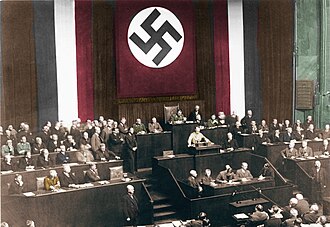
Mussolini's fascism was a hodgepodge of policies and ideas that he thought would play well.[16] His glorified turd, "The Doctrine of Fascism," was a rant against the supposed decadence of capitalism, the evils of socialism, the importance of non-materialistic lifestyle, and how nationalism was the greatest thing ever.[17] Unfortunately, fascism inspired many people around Europe, most notably a failed painter from Austria. Hitler oversaw an unsuccessful coup aimed at overthrowing Germany's collapsing republic in 1923 (the 'Beer Hall Putsch'),[18] wrote a really shitty book that blamed all of his life's problems on Jews, and blustered his way into becoming Chancellor of Germany in 1933.
While nowadays fascism (including Hitler's closely related Nazism) is usually popularly seen as mainly a German and Italian thing due to Hitler and Mussolini, fascism was actually frighteningly popular across the world in the 1920s-1930s. With the sudden success of socialism and especially Bolshevism in the aftermath of World War I, a right-wing backlash was nearly inevitable, and long-simmering antisemitism came along for the ride. France![]() and the United Kingdom had fascist movements of varying popularity during the 1930s, as did the USA with groups like the Silver Shirts and America First Committee.
and the United Kingdom had fascist movements of varying popularity during the 1930s, as did the USA with groups like the Silver Shirts and America First Committee.![]() [note 1] Countries like Portugal, Austria,
[note 1] Countries like Portugal, Austria,![]() and Spain were ruled by fascist (or nearly fascist) dictatorships during the period; even Poland flirted with antisemitism and authoritarianism in the aftermath of the May Coup.
and Spain were ruled by fascist (or nearly fascist) dictatorships during the period; even Poland flirted with antisemitism and authoritarianism in the aftermath of the May Coup.![]() Later, in the early 1940s at the height of Nazi Germany's success, Nazi-inspired groups like the Arrow Cross Party
Later, in the early 1940s at the height of Nazi Germany's success, Nazi-inspired groups like the Arrow Cross Party![]() in Hungary, the Ustaše in Croatia, and the Iron Guard
in Hungary, the Ustaše in Croatia, and the Iron Guard![]() in Romania were able to seize power and happily participated in crimes against humanity.
in Romania were able to seize power and happily participated in crimes against humanity.
[edit]
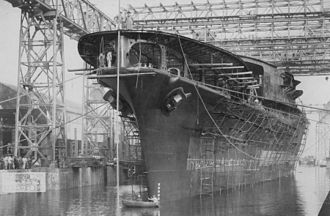
The legacy of the Great War also hung over the world's oceans, as Europe's naval powers recognized the role of the battleship arms race in escalating tensions on the Continent. In the hopes of preventing that from happening again, the USA, UK, and Japan met in the Washington Conference of 1921–22 to hammer out an international treaty limiting the tonnage and capabilities of warships.[19] The interwar governments of Italy and Japan agreed to these stipulations primarily to avoid having to hike up spending on expensive warships. Japan was also aware that further naval buildup would be especially difficult for it due to a lack of raw materials to build boats.[20]
Despite agreeing in principle to arms control, Japan found itself bitterly opposed to the agreements which actually took form. The naval treaties limited Japan further than it did the US or the UK, which the Japanese perceived as being an unfair product of Western chauvinism.[20] Japan's navy also had to cancel seven battleships under construction and scrap another ten older ships.[21]
While Japan's civilian government ultimately signed the treaty and forced it into effect, the terms were hated by the nationalist military.[22] Many officers resented the civilian government for capitulating to such a humiliating agreement. Tensions were only further inflamed when Japan ratified the 1930 London Naval Treaty, which once again limited Japan further than the US or UK.[23]
In 1930, Army officer Hashimoto Kingorō founded the Cherry Blossom Society (Sakurakai 桜会) with the goal of overthrowing the civilian government and establishing a military dictatorship over Japan.[24] In November 1930, a member of the Sakurakai shot Prime Minister Hamaguchi Osachi, opening the door for a short-lived coup attempt.[25] Hamaguchi later died of his wounds.
Later, in 1936, more radical Japanese military officers attempted a second coup attempt, murdering three top-level government officials in the process. Although this effort failed, the chaos it unleashed opened the door for military officer Tōjō Hideki to seize the office of prime minister and enshrine himself as Japan's new fascist dictator.[26]
Second Sino-Japanese War[edit]
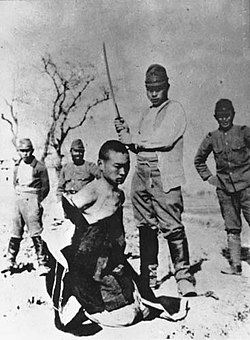
“”Many soldiers went beyond rape to disembowel women, slice off their breasts, nail them alive to walls. Fathers were forced to rape their daughters, and sons their mothers, as other family members watched. Not only did live burials, castration, the carving of organs and the roasting of people become routine, but more diabolical tortures were practiced, such as hanging people by their tongues on iron hooks or burying people to their waists and watching them torn apart by German shepherds. So sickening was the spectacle that even Nazis in the city were horrified.
|
| —Iris Chang, granddaughter of Nanjing Massacre survivors.[27] |
For East Asia, the latter 19th Century was defined by Japan's attempts to create an overseas colonial empire. The First Sino-Japanese war occurred in 1895, and it began because Japan wanted to annex the Chinese tributary state of Korea in order to prevent Westerners from colonizing it.[28] The aftermath of this war saw Japan annex Taiwan and turn Korea into a protectorate (Chōsen). Competition between Russia and Japan in the region then led to the Russo-Japanese War in 1905, and Japan once again won victory.[29]

Japan accelerated its colonialism during and after World War One. It conquered much of Germany's Pacific holdings during the war, and afterwards it sought influence in China. The latter goal was especially motivated by the fact that the fledgling Republic of China was beginning to centralize and strengthen itself, essentially setting a time limit on Japan's ambitions there.[28] In 1931, the Japanese military used an explosion in a railroad depot as an excuse to invade Manchuria, a resource-rich region in northern China.[31] After overrunning the disorganized Chinese forces in the region, Japan declared the region an "independent" state called Manchukuo, in reality controlled entirely by the Japanese Kwantung Army.[32] The Kwantung Army turned Manchukuo into a military state, mobilizing the population for forced labor and forming Unit 731 for the purpose of conducting human experimentation on primarily Chinese captives.[33]
Japanese imperialism climaxed in 1937 with the outbreak of the Second Sino-Japanese War. The Japanese manufactured a border incident between Manchukuo and the Republic of China.[34] The Chinese nationalists and Chinese communists, who had previously been locked in a civil war, set aside their differences and formed a "United Front" against Japan.[35] Although China lacked industry and supplies, it was still confident enough to refuse negotiation with the Japanese. As a result, the limited incident became a desperate war for survival. China fought alone until 1941, and Japan's war crimes exacted a horrific toll of at least 20 million deaths.[36] It is during this conflict that Japan engaged in the infamous Rape of Nanjing in which its soldiers murdered, raped, and robbed civilians, causing a death toll up to 300,000.[37][38]
The war against China was a long, drawn-out affair compared to Japan's previous victories, and it quickly began to take its toll on the Japanese economy. Japan had no allies at this point, and its domestic supplies of rubber, oil, and iron were not sufficient for a forever war in China.[28] This critical resource shortage would eventually force Japan to make some hard choices.
Second Italo-Ethiopian War[edit]
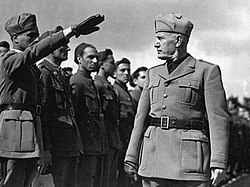
“”It is us today. It will be you tomorrow.
|
| —Haile Selassie, emperor of Ethiopia.[39] |
Italy had embarrassingly failed to conquer Ethiopia in the 1890s during the Scramble for Africa.[40] Hoping to avenge that loss and begin building his own African colonial empire, Mussolini used a border incident as pretext to declare war in 1935.[41] The League of Nations, tasked with keeping world peace after World War I, utterly failed to stop Mussolini's war in Africa just as it had failed to stop Japan's invasion of Manchuria in 1933.[42] The League's failure was largely the fault of the British and French, who had imposed sanctions at the outset of the war but suddenly caved and offered a settlement to Mussolini granting him everything he wanted.[43] Italy's war of conquest in the region saw repeated war crimes such as the use of chemical weapons and the deliberate bombing of hospitals and ambulances.[44] Italy's overwhelming technical advantages resulted in the war being a short affair that ended with Ethiopia's annexation.
Importantly, the war also created the first great wedge between Italy and the democracies of Western Europe. Mussolini perceived the initial Anglo-French opposition to his war as blatant and malicious hypocrisy as both nations had created their own African colonial empires using much the same methods as he had.[45] This is one of the factors that drove Mussolini into aligning with Hitler.
Spanish Civil War[edit]
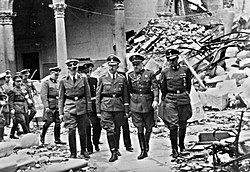
Civil war broke out in Spain between nationalist and fascist usurpers led by José Sanjurjo and Generalissimo Francisco Franco versus the legitimate socialist government led by Manuel Azaña. Franco personally adhered to Falangism, a quasi-fascist ideology that emphasized Catholic identity, totalitarianism, capitalism, and moralism.[46] Mussolini sent a huge amount of military aid to the nationalists, totaling 70,000 ground troops and 6,000 aviation personnel, along with about 720 aircraft.[47] Nazi Germany also provided military support to the nationalists but intentionally kept their involvement limited.[48]
The Comintern, Joseph Stalin's commie club, naturally sided with the Republic and provided aid through the volunteer "International Brigades".[49] The Republic was weakened by infighting. The hardcore communists saw the war as an opportunity for a revolution while the socialists and moderates only hoped to preserve republicanism.[50] Spain became a proving ground for the fascist nations and the Soviet Union to test their newest and best technologies such as planes and tanks. The Nationalists came out on top in 1939 and established a dictatorship, but they officially stayed neutral during the world war. Franco did, however, send "volunteers![]() " to assist Germany against the Soviets.[51]
" to assist Germany against the Soviets.[51]
German expansionism[edit]
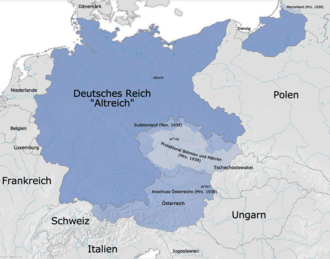
“”The era of procrastination, of half measures, of soothing and baffling expedients, of delays, is coming to its close. In its place, we are entering a period of consequences… During this very period, Germany may well reach the culminating point of her gigantic military preparations.
|
| —Winston Churchill, Speech in the House of Commons, November 12, 1936.[52] |
Lebensraum[edit]
Immediately after taking power Hitler began to rebuild Germany's armed forces in secret. In 1933, Hitler announced to German military leaders that the "conquest for Lebensraum in the East and its ruthless Germanisation" was his ultimate foreign policy objective.[53] Lebensraum, or "living space," was the idea that the German people needed to conquer vast swathes of territory in Eastern Europe in order to ensure their future growth.[54]
Lebensraum was directly inspired by the suffering that Germany endured during the Great War. The British had imposed a naval blockade against Germany, and the resulting starvation and resource shortages contributed to Germany's defeat. Hitler was determined that Germany would never again be defeated by resource shortages, and he looked to the “incalculable raw materials” in the Urals, the “rich forests” of Siberia, and the “incalculable farmlands” of the Ukraine.[54] He also added a racial element to Lebensraum by claiming that the Soviet Union was run by Jews and was therefore a just target for Nazi expansionism.[55] The realization of Hitler's plans would have resulted from the extermination of hundreds of millions of people in Eastern Europe.[56]
Military buildup[edit]

With the first steps completed in secret, Hitler made Germany's rearmament public in 1935 by announcing that he was introducing mandatory conscription with the goal of increasing Germany's standing army to 550,000 men.[58] This is the point where appeasement began, as the British consented to the creation of a German navy negotiated a limit of 35% of the UK's strength.[59] In 1936 the German army, previously having been barred from the region by the Treaty of Versailles, marched into the Rhineland on France's borders.[60]
During this time, Hitler directed Hermann Göring to devise and execute a "Four Year Plan" to refocus Germany's economic potential towards war production by establishing aluminum plants, synthetic oil refineries, and chemical plants.[61] To this end, he established a massive state-controlled industrial conglomerate called Reichswerke Hermann Göring to funnel German steel output into military production. By the end of 1941 the Reichswerke was the largest company in Europe, with a capital of 2.4 billion ℛℳ and about half a million workers.[62]
Hitler's government managed to conceal the true extent of these efforts by funding them through a deferred payment scheme using promissory notes called "Mefo bills".[63] Economic efforts were also funded with property and capital confiscated from Jews.[64]
Hitler chose to prioritize military rearmament over welfare and unemployment relief, or indeed quality of life in general.[65] Although unemployment had fallen dramatically, the cost of living rose by 25% on average, and wages were stagnant.[66]
Anschluss[edit]

“”The majority of the Austrian population welcomed Hitler… In Austria anti-Semitism was even deeper rooted than in Germany. Vienna had a Jewish population of around 11%. And as soon as the German soldiers arrived in Vienna you had an outbreak of the worst anti-Semitic pogroms you ever had seen in central Europe since the Middle Ages.
|
| — Dr Winfried Garscha, historian with the Documentation Centre of Austrian Resistance in Vienna.[67] |
Hitler's foreign policy through the 1930s was focused primarily on strengthening Germany by annexing areas populated by ethnic Germans, adding territory and manpower to his war machine. In 1938, the German army marched into Austria and incorporated it into the German Reich with no resistance. This event, called the Anschluss, was met with enthusiasm by the Austrian public, and it was confirmed by a retroactive plebiscite.[68] It was conducted under heavy scrutiny by the Germans and the results were falsified to an absurd 99.7% approval.[69] Meanwhile, the Nazis unleashed a wave of oppression and violence on Austria's Jews.[70]
Sudetenland and the Munich Conference[edit]
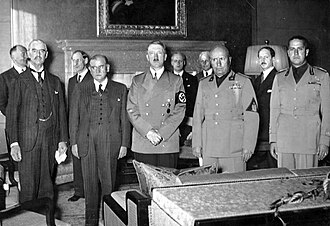
“”Czechoslovakia recedes into the darkness. She has suffered in every respect by her association with the Western democracies and with the League of Nations, of which she has always been an obedient servant… You will find that in a period of time measured only by months, Czechoslovakia will be engulfed in the Nazi régime.
|
| —Winston Churchill being right again in his "Disaster of the First Magnitude" speech.[71] |
Having swallowed Austria with no problems, Hitler then instigated the "Sudeten crisis" by kicking up a fuss about the fact that Czechoslovakia had a number of ethnic Germans living in the border areas of Bohemia-Moravia.[72] In May 1938 it became known to the international community that Hitler was drawing up plans to invade Czechoslovakia; if that happened the French and possibly the British would be pulled into another European war.[73] The British Prime Minister Neville Chamberlain considered any capitulation preferable to a repeat of the Great War. Thus, with no input from the Czechs, Chamberlain agreed that all Czech provinces with more than 50% German population would be handed off to Germany with a plebiscite to be held in the rest.[74] The Munich Agreement was celebrated by Europe, as it seemingly prevented another continental war.[75]
The loss of the Sudetenland catastrophically weakened Czechoslovakia, and in March 1939, Hitler violated the Munich agreement and sent the German army to occupy the rest of it.[76] Czechoslovakia was then carved up between Germany, which took Bohemia-Moravia, and the "Slovak Republic", a German puppet. Around the same time, Germany regained the small territory of Memel from Lithuania by threatening war.[77] This blatant betrayal of previous agreements was the final straw for the Allies, and they made a guarantee that they would fight to protect Poland's independence.[78] Hitler, for his part, had begun the same routine all over again by shouting about ethnic Germans in the city of Danzig (modern-day Gdańsk).
Final steps[edit]
Intensifying persecution in Germany[edit]
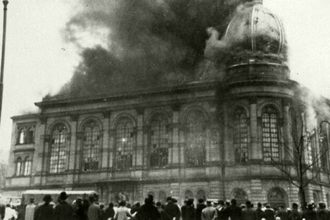
“”[W]e heard what had been going on in Berlin during the night — that Jewish shops had been smashed up and people brutally killed. Shop windows had been broken everywhere, and the words 'Jew' or 'Jewish pig' written in many places.
|
| —Ruth Winkelmann, a student at a Jewish school during the events of Kristallnacht.[79] |
The Nazi regime had tightened the screws on the German Jewish population throughout the 1930s. On the legal side were the Nuremberg Laws, a slew of legislation that stripped citizenship from Jews and made it totally legal for citizens or the government to commit any acts of violence against them.[80] For political opponents of the regime, Dachau and other concentration camps opened for the purposes of punishing people with forced labor and spartan living conditions.[81]
In 1938, the rising tide of hatred in Germany led to Kristallnacht, a period of nationwide violence against Jews, synagogues, and Jewish-owned businesses.[82] The event was so-named due to the appearance of shattered glass on the streets due to shop windows being smashed in. This was planned by the German regime, which agitated people with antisemitic propaganda and drew up instructions for local police to ensure they didn't intervene to stop the pogroms.[83] The mobs, aided by government forces, murdered 91 people and forced another 30,000 into concentration camps.[82] Nazi officers (Waffen-SS and Sturmabteilung) also took direct part in the violence.[84]
Soviet–Japanese border conflicts[edit]

Japan and the Soviet Union fought a war against each other throughout the summer of 1939 that caused about 30,000 to 50,000 casualties.[85] The conflict was instigated by Japanese officer Tsuji Masanobu with a strike across the Manchuria-Mongolia border, but the Soviets and their Mongolian puppets successfully defended against the initial strikes.[85] The angry Japanese continued to escalate the conflict, although there was never a formal declaration of war. The Soviets responded by sending in tanks along with their brilliant commander Georgy Zhukov. The subsequent course of the war taught the Japanese that an infantry army on open ground is highly vulnerable to armored vehicles and that superior morale is not a substitute for superior firepower.[86]
Although a seemingly small event, the border conflict had an outsized impact on events. Japan's humiliation at the hands of the technologically superior Soviets caused them to abandon their policy of "hokushin-ron" or "Northern Expansion Doctrine", which would have seen Japan eventually attempt to invade and annex Russia's resource-rich Siberian frontier.[87] Instead, Japan decided on "nanshin-ron", which saw them invade the Southeast Asia and the Pacific islands.[88] Further political considerations including the Molotov-Ribbentrop Pact led Japan to sign a nonaggression treaty with the Soviets in 1941 that lasted until the final days of the war.[89]
Molotov-Ribbentrop Pact (and Soviet aid to Germany)[edit]

As the final step before kicking off the festivities, Hitler sent his Foreign Minister Joachim von Ribbentrop to Russia with the goal of ensuring that Germany would not be fighting the Russians when they inevitably invaded Poland. Joseph Stalin had lost faith in the Western powers as they repeatedly failed to contain Hitler's aggression, and had been turned down on offers of an alliance by the French and British on several occasions. He also needed time to rebuild the Soviet military after he had purged it of many of its officers while also carrying out a massive campaign of modernization of equipment, and he also needed to avoid a two front war against Germany and Japan. With both leaders’ interests coinciding at the moment, the two nations signed the German-Soviet Nonaggression Pact, also commonly known as the Molotov-Ribbentrop Pact.
Publicly, the pact simply stated that neither country would go to war with the other, but privately it divided Eastern and Central Europe between the Nazis and the Soviets.[90] The two powers agreed to split Poland between them while the Soviets also gained a free hand to either bully or annex the Baltic states and Finland.
The treaty was accompanied by the first Soviet-German Trade Agreement, in which the Soviet Union would supply critical raw materials to Germany (such as oil, metals, grains, and wood) in exchange for Germany handing over machines and tools which the Soviets were incapable of building for themselves.[91][92] This agreement would be built upon in early 1940, as the Germans recognized that the flow of raw materials was at that point critical to continuing their war of aggression.[93]
With the Soviets neutralized as a threat (and now even fueling the Nazi war machine) and the Western powers seemingly unwilling to throw down on Poland's behalf, Hitler kicked off the world war just a week later.
The war[edit]
Outbreak in Europe[edit]
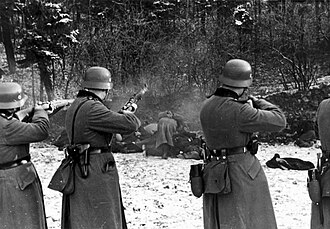
“”It is evil things that we will be fighting against — brute force, bad faith, injustice, oppression and persecution — and against them I am certain that the right will prevail.
|
| —Neville Chamberlain, Broadcast from the Cabinet Rooms at 10 Downing Street, 3 September 1939.[94] |
Blitzkrieg on Poland[edit]
“”Our strength lies in our quickness and in our brutality… I have given the command and I shall shoot everyone who utters one word of criticism, for the goal to be obtained in the war is not that of reaching certain lines but of physically demolishing the opponent. And so for the present only in the East I have put my death-head formations in place with the command relentlessly and without compassion to send into death many women and children of Polish origin and language. Only thus we can gain the living space [Lebensraum] that we need.
|
| —Adolf Hitler, in the Obersalzberg Speech, 22 August 1939.[95] |
Germany invaded Poland in September 1939 after having staged multiple false flag border incidents designed to place blame for the ensuing violence on the Poles.[96] By coordinating with their Soviet ally and their Slovakian puppet, the Germans were able to force the Poles to defend on three fronts.[97] Poland fought valiantly, but they were tremendously outnumbered and poorly-equipped. The Germans, on the other hand, employed a tactic now referred to as Blitzkrieg, or "Lightning War." This entailed deploying tanks, aircraft, and artillery against a narrow part of the line in order to cause a breakthrough and perform encirclement actions.[98] Airstrikes would prevent the enemy from resupplying or redeploying forces. This was vastly different than anything the combatants of the First World War or any interwar conflict had attempted, and Poles were caught completely by surprise.

There's a persistent myth that Polish horse cavalry charged German tanks; however this is bullshit: Polish lancers mostly used their horses for fast, cheap transportation, and the few actual cavalry charges were against infantry and all were successful.[99] There were also some notable examples of Polish skill and tenacity. The Battle of Wizna, for instance, saw 720 Polish soldiers defend a fortification for three days against 42,200 German soldiers and 350 tanks.[100]
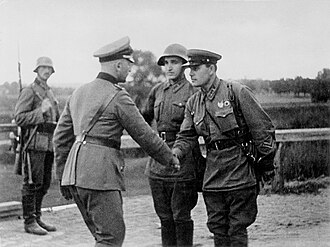
Despite declaring war in accordance with their earlier guarantees, neither the British nor the French aided the Poles against Germany. The French launched a limited invasion of Germany's western borderlands, which was unopposed due to Hitler having deployed almost all of Germany's armed forces to the east.[101] After advancing for only a few short miles, the French withdrew to focus on the defensive.
As the German military advanced into Poland, SS troops, police squads, and the army itself committed atrocities against Polish civilians. As demanded by Adolf Hitler in his Obersalzburg speech on the eve of the war,[96] the campaign took on an explicitly genocidal note, being conducted with the primary aim of killing as many Poles as possible in order to clear the land for German resettlement. Poland became Germany's testing ground for its means of mass murder. The first killing squads, or Einsatzgruppen formed during the course of the invasion, deployed to murder anyone the Germans considered a political threat.[102] And while the Luftwaffe pounded the cities, dive-bomber aircraft followed orders to attack fleeing columns of Polish refugees.[103]
On 17 September, after the Polish had largely been defeated, Joseph Stalin ordered the Red Army into Eastern Poland in accordance with his prior agreement with Hitler. Publicly, Stalin claimed the Soviet Union had simply acted to protect "Ukrainian and Belarusian minorities" amid the collapse of the Polish state.[104] Despite these claims of protection, the Red Army took about 200,000 to 250,000 Polish soldiers prisoner and conducted their own mass murders against Polish officers and government officials in order to solidify their hold over the region.[105] Soviet and German units held a joint victory parade in Brest-Litovsk before the Germans withdrew to their new border.[106]
After the defeat of Poland many Polish soldiers fled to Britain, where they continued to fight, and Polish code-breakers played a major — perhaps decisive — role in the eventual Allied victory.[107] Polish resistance continued after the fall of their government, and this resistance movement was the largest under the German Reich. The Polish Home Army at its peak numbered about 300,000 people.[108]
Poland under the jackboot[edit]
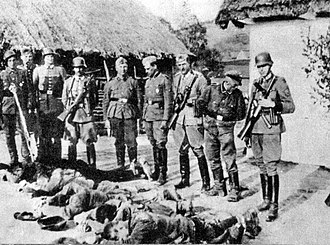
The opening stages of the Holocaust began immediately when Germany occupied Poland. German forces expelled Jews from their homes in Poland and confined them into dilapidated ghetto neighborhoods in cities that had previously been home to large Jewish populations. There, by the end of 1940, about 700,000 Jews had been forced to labor in factories and workshops as slave labor.[109] Cut off from the world, the ghettoes received barely any food, and these supplies were delivered by the SS in tiny amounts for exorbitant prices.[110] Nazi officials intentionally limited the amount of food that reached the ghettos; the average daily food intake in the Warsaw ghetto was just 184 calories.[111] Hunger was such a problem that even potato peels were a priceless commodity.

The Polish people were also subject to genocidal actions. The Wehrmacht routinely took huge numbers of hostages from the Polish populace and executed them in order to strike terror into the people.[112] This was also a punishment method. For every German killed by Polish resistance, between 75 and 100 Poles would be murdered by occupation forces, often chosen at random.[113]
Roughly half of Poland was directly annexed into the Reich, while the rest was formed into the "General Government" under the rule of Hitler's ruthless advisor Hans Frank.[114] German authorities set about "Aryanizing" the annexed regions by expelling hundreds of thousands, eventually millions of Poles, Jews, and Roma into the territory of the General Government.[114] The Aryanization policy also called for the abduction and forced reeducation of any Polish children suspected of having a good amount of German heritage (determined scientifically via "do they have blonde hair and blue eyes").[115] Poles in all occupied areas became subject to regulations meant to make clear their racial inferiority: they were required to serve Germans first in shops, tip their hats to German officials, and walk in the gutters to keep the sidewalks clear for Germans.[114]
German authorities also shut down education for Polish children. Heinrich Himmler, leader of the SS, gained a new title after the invasion of Poland, that of the Reich Commissioner for the Strengthening of Germandom. One of his first actions was to close down many schools for non-German children and greatly restrict the teaching materials of the schools that remained.[114] Schools could only teach basic counting skills, the writing of one's own name, and that it was the will of God that Poles and Jews obey the Germans.[116]
Amid this repression, Poles used trade schools (sanctioned by the German authorities as being too useful to close) to continue educating their children in secret, a practice they had learned during the era of Russian rule.[116] In the Jewish ghettoes, education was later completely banned, with any written publications at all being punished. The Jews also held informal classes in defiance of the ban inside their homes and during unsupervised hours in factories.[116] By doing so, they incurred a massive deadly risk.
The Winter War[edit]

With Poland finished and with Germany apparently having consented to it, the Soviets turned their attention towards Finland, which had been allocated to their sphere of influence by the terms of the Molotov-Ribbentrop Pact. The Soviets sent the Finns an ultimatum demanding that they move their border further back from Leningrad and lease their naval bases.[117] When the Finns refused, the Soviets attacked on 30 November, 1939.
The Soviet Union notably used a similar tactic to Nazi Germany when jumping into war with the Finns, that of claiming that the other side attacked them first. The Soviet Union accused Finland of launching an unprovoked artillery attack against the Russian village of Mainila, which the Finns vehemently denied.[118] The international community was skeptical, but the Soviets refused to allow outside investigators to verify their story.
Initial Soviet attacks were accompanied by bombing raids against Helsinki, killing 100 civilians.[119] This was done without a declaration of war and in violation of multiple non-aggression treaties. When Finland complained about this to the League of Nations, the League promptly expelled the Soviet Union from its ranks.[120] This had precisely the impact you think it did (absolutely fuck all).

The Soviet invasion force numbered over 600,000 troops along with thousands of tanks, planes, and heavy artillery pieces which conducted bombardments like the world hadn't seen since the World War I Battle of Verdun.[121] While possessing few tanks and less than half the manpower, the Finns fought from behind the heavily fortified Mannerheim Line, while the Red Army struggled due to having most of its officers purged by Stalin in the years before the war.[117] Finland, a weak, sparsely populated, and diplomatically isolated nation, fought fiercely against the invader. It was able to impose heavy costs on the Soviet Union for the invasion, far worse than anyone could have anticipated. The Finns proved adept at using their cold and rugged homeland to their advantage, mobilizing soldiers on skis to launch surprise raids.[121] The Finns were also able to attack Soviet tanks using bottles filled with petrol and pine tar, ignited with storm matches.[122] These resulting mess stuck to the target, burned long and hot, and produced black smoke that could blind armored vehicles. The Finns called them "Molotov cocktails" as a mocking nod to the Soviet foreign minister. Finnish bomb-makers also placed mines under frozen lakes which could be detonated to plunge hundreds of soldiers to a freezing watery grave.[121] When Soviet officers started refusing to send their men onto the ice, they had to travel through the forest to face entrenched Finnish snipers and machine gunners.
After making little progress in 1939, the Soviets were finally able to use their superior artillery to breach the Finnish fortifications.[123] Although they lost the war, Finland's valiant defense ensured that it was able to keep its independence after being forced to make territorial concessions. Said concessions included Viipuri, the second-largest city in Finland, which the Soviets took over and renamed to Vyborg.[124]
The Red Army, on the other hand, performed abysmally. While Finland lost approximately 25,000 soldiers, the Soviets lost a staggering estimate of 200,000.[121] In fact, the humiliating affair convinced the entire world that the Soviet Union would be a pushover if the Germans were to attack them.[125] This miscalculation had horrific consequences.
Poland under the hammer-and-sickle[edit]
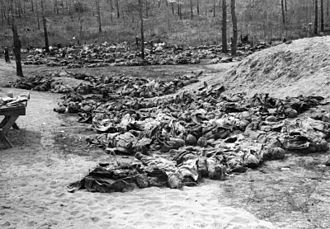
Having never declared war, the Soviet Union occupied its portion of Poland with unlawful brutality. Of the Polish soldiers the Red Army had captured, almost all officers were executed while many thousands of ordinary troops were forced into gulags.[126] The Soviets then banned all Polish political parties and executed their leaders before instituting forced collectivization.[127]
Over time, Soviet repression increased dramatically in scale and cruelty. By 1941, Soviet occupation authorities had imprisoned some 10% of Poland's adult male population.[128] Many of these prisoners were subjected to torture methods including application of boiling water or cutting off ears, noses and fingers.[129]
The most infamous chapter of the Soviet occupation came in April and May of 1940. Prison camps at Starobielsk, Kozielsk, and Ostashkow holding former Polish government officials and military servicemen reported to NKVD chief Lavrentiy Beria that they were repeatedly failing to reeducate and indoctrinate the prisoners.[130] Beria then recommended to Stalin that the prisoners then be executed en masse without charges or trials.[130] The recommendation was seconded by high-level Soviet officials like Kliment Voroshilov, Vyacheslav Molotov, and Anastas Mikoyan.
Thus began the Katyn Massacre. In order to keep the prisoners from knowing their fates, the executioners led prisoners into the cellars of buildings at night before promptly murdering them with bullets to the backs of their heads.[130] At individual murder sites the daily rate of execution was between 250 and 300 people.[131] The total number killed was almost 22,000. The victims were buried in mass graves. These horrific events would be kept secret until 1943 when the Nazis stumbled across the grave sites and decided to publicize the massacre in order to damage the Soviet Union's international image.[132]
The not-so Phoney War[edit]

Also called the Sitzkrieg ("sitting war"), the Phoney War is a term which describes the period from September 1939 to April 1940 when the Allies and the Germans just sort of stared at each other across the French border. This period was far from pointless, however. The Battle of the Atlantic had begun in earnest, pitting Hitler's U-boat navy against Allied merchant shipping, a repeat of what the Germans had attempted in the previous war. Like the Kaiser, Hitler hoped to starve the British isles of imports and force them to sue for peace. For that end, Hitler had a larger and more advanced U-boat fleet than the Kaiser had possessed, and the Kriegsmarine later envisioned the wolfpack tactic by which submarines would tail their prey until reinforcements arrived to assist in an overwhelming kill.[133]
Even worse for the Allies, the British blockade that had brought Germany to her knees in the last war was largely ineffective against Germany this time. On August 19, the German and Soviet governments had completed a trade agreement ensuring that the Soviet Union would supply raw materials like lumber, cotton, grain, and petroleum to Germany in exchange for credit to be used for purchasing technology and machine goods.[134] This agreement had served to expand upon the economic agreement which had accompanied the Molotov-Ribbentrop Pact. By April 1940, with only the first agreement in place, the British had noticed that shipping through the Black Sea had rendered the British blockade strategy useless.[135]
As an outgrowth of the naval war, Hitler invaded Denmark and Norway. Germany swiftly occupied Denmark before it was able to respond, but this was only in preparation for the more important attack on Norway.[136] Norway was deemed critical to Germany's interests for two reasons. First, it had a long coastline on the North Sea, which would give Germany access to the Atlantic to fight the British.[137] Secondly, Germany's iron imports from Sweden ran through Norway, and when the British boarded a Norwegian ship with no protest, the Germans decided that this trade route was under threat.[138]
The aftermath of the successful invasion of Norway saw Hitler put the notorious collaborator Vidkun Quisling in charge. The fall of Norway was met with consternation in the UK, as the public feared that Germany could use it as a base to attack Great Britain. Neville Chamberlain resigned in disgrace due to the failure of his appeasement policies, and Winston Churchill, who had always taken a hard line against Hitler, became Prime Minister.[139]
The Soviets, meanwhile, invaded and annexed the Baltic states — which the Molotov-Ribbentrop Pact had assigned to their sphere of influence —w ith relative ease after placing immense diplomatic pressure on their governments in order to destabilize them.[140]
The Allies' darkest hours[edit]
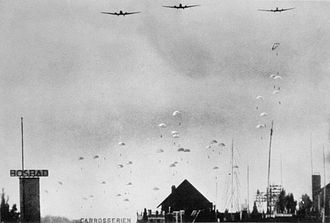
“”Hitler is striking with all the terrible destructive force at his command. His is a desperate gamble, and the stakes are nothing less than domination of the whole human race. If Hitler wins in Europe — if the strength of the British and French armies and navies is forever broken — the United States will find itself alone in a barbaric world: a world ruled by Nazis.
|
| —The Committee to Defend America by Aiding the Allies, June 1940.[141] |
Around the Maginot[edit]
As all this was going on, France sat behind its supposedly unbreakable defensive fortifications, termed the "Maginot Line."[142] Built in the aftermath of World War One, the fortifications were meant to be an improvement on the forts present at Verdun, which had so admirably resisted German attack.[142] The crucial weakness in the line was that it did not extend to the Belgian border. The French mistakenly believed that the Ardennes Forest was too dense to drive armored vehicles through, and the Belgians probably wouldn't have appreciated it if the French seemed to be using their country as a meat shield.

On 10 May, the Germans launched Fall Gelb, the invasion of the Low Countries, the goal of which was to outflank the Maginot Line. The neutral Netherlands, caught largely off-guard by the German bombers fell first. This didn't happen without quite a fight. Paratroopers, or Fallschirmjägers, descended on the Hague to capture Wilhelmina and her government but were beaten back by determined resistance.[143] However, the Dutch were outnumbered and unable to halt the invasion. While they tried blowing up the nation's bridges to slow the Germans, the Germans committed some of their many war crimes by dressing as Dutch soldiers and seizing the bridges with surprise.[143] The Luftwaffe then bombed the city of Rotterdam to strike terror into the Dutch nation (killing about 800)[144] before threatening to do the same to Utrecht; the country finally capitulated on 15 May.[143] Queen Wilhelmina fled to the UK.

Meanwhile, in a daring and ambitious move, the German army sent a group of tanks to slice through the Ardennes in southern Belgium and invade northern France, all of this being completed in three days.[145] The French and British had gone north to defend Belgium from German troops crossing from the Netherlands, thus being fatally encircled by the armored spearhead through the Ardennes.[146] About 40,000 of France's best soldiers were taken prisoner as a result.[147] The gates to northern France were thrown open, and the Allies were royally fucked.
Instead of going right into France, however, the Germans instead pushed to the English Channel, creating a huge pocket in which over 300,000 of the Allies' strongest troops were cut off from all aid and surrounded by the enemy.[148] As the pocket closed inwards due to the advances of the relentless German military, the Allies were left with fewer and fewer ports through which they could potentially escape.
Realizing that escape would have to happen immediately, the British planned Operation Dynamo, a rescue operation to evacuate its expeditionary forces from the port of Dunkirk. Under German air attacks and shelling, the British used small craft to ferry their soldiers out to Navy destroyers waiting at sea.[149] Many larger ships from the Navy also ventured towards the beaches to pick up soldiers, suffering terrible losses from German bombers. Begun on the 26 May, the operation finished on 4 June 1940, having evacuated 338,226 soldiers. Which was nice and all, but Churchill himself had to step in to give everyone a reality check. "We must," Churchill warned, "be very careful not to assign to this deliverance the attributes of a victory. Wars are not won by evacuations".[150]
The German thrust from southern Belgium, 10-16 May.
The Allies encircled on the Channel, 16-21 May.
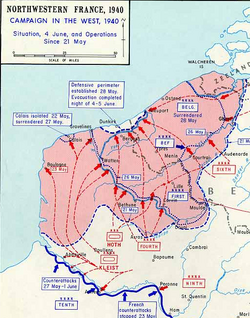
Dunkirk area from 21 May to 4 June.
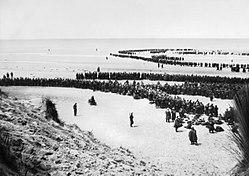
British soldiers awaiting evacuation at Dunkirk.
The Fall of France[edit]

“”This war is not over as a result of the Battle of France. This war is a worldwide war. All the mistakes, all the delays, all the suffering, do not alter the fact that there are, in the world, all the means necessary to crush our enemies one day.
|
| —Charles de Gaulle, radio broadcast, 18 June.[151] |
With the British out of the picture, the war went into France itself. The French made serious miscalculations in the inter-war period, leading to their (actually quite formidable) tanks being spread out within infantry formations,[152] and a severe lack of radio communications (command tanks, for example, were expected to relay orders via semaphore) meant that the French army simply could not act as quickly or cohesively as that of the Nazis, who widely proliferated radios among infantry, armor and aircraft. The French army was large and quite well equipped, superior in some respect to the Nazis, but it was also rendered catastrophically sluggish due to this lack of communication. The French air forces, while they did have a number of good to excellent aircraft, were absolutely tiny compared to the Luftwaffe, and so could not mount any significant resistance.

Contrary to the "cheese-eating-surrender-monkey" perception of France, the French soldiers often fought ferociously, culminating with French forces covering the British evacuation at great cost to themselves, and many of the French continued to fight on after their defeat, both in the form of the French Resistance and the Free French.
As the Germans advanced, they engaged in massacres against France's black African soldiers. The Germans hated black soldiers not only for racist reasons but also for having taken part in the occupation of the Rhineland between the wars.[153] As the French military retreated, they placed black soldiers in the unfortunate position of covering them.[153] When they surrendered, German troops shot them without a second thought. On 19 June, the SS Totenkopf Division massacred 188 surrendered black soldiers with machine guns.[154][155]
On 26 May, Benito Mussolini announced that Italy would opportunistically pounce on the weakened France by declaring war and allying itself with Nazi Germany. The enraged French Prime Minister Paul Reynaud commentated to the American ambassador, "What really distinguished, noble, and admirable people the Italians are to stab us in the back at this moment!"[156] Rather than a lightning advance in the style of Germany, Italy merely stood on its borders and contented itself with launching air raids and fighting naval actions.
Meanwhile, political crisis swept France, which culminated with Paul Reynaud resigning on 17 June and President Albert Lebrun appointing Philippe Pétain to replace him as Prime Minister of France.[157] Pétain signed the armistice with Germany shortly thereafter, surrendering much of his country to German occupation. Pétain's government subsequently became a Nazi puppet dictatorship popularly known as Vichy France. Unfortunately, those loyal to Vichy collaborated with the Germans. The French record on treatment of Jews was decidedly mixed; French Jews were protected to the extent possible, while foreign Jews were turned over to the Nazis with what has been described as "enthusiasm".[158]
Britain stands (but not alone)[edit]

“”The whole fury and might of the enemy must very soon be turned on us. Hitler knows that he will have to break us in this Island or lose the war. If we can stand up to him, all Europe may be free… But if we fail, then the whole world, including the United States, including all that we have known and cared for, will sink into the abyss of a new Dark Age…
|
| —Winston Churchill in one of his most famous speeches, 18 June.[159] |
Having largely conquered Western Europe, Hitler gave a weak "appeal to reason", essentially asking the British to concede defeat and put down their weapons.[160] Churchill naturally refused. Although the prime minister stood defiant, his situation was grim behind the scenes. Foreign Secretary Lord Halifax pointed out that Churchill's refusal to negotiate put the UK in an unwinnable situation since the Soviet Union was aiding the Germans, Italy joined the Axis, and the US was still hitting the snooze button.[161] Halifax took it upon himself to make peace overtures to the Italian ambassador Giuseppe Bastianini and then confronted Churchill with his proposal to leave the war with the empire intact.[161] During the ensuing Cabinet debates, Churchill argued that Hitler would never honor any peace, a pretty compelling point since Hitler by that point had violated multiple treaties, invaded various neutral nations, and broke the Munich agreement. Ultimately, the stubborn British bulldog had his way, and the UK remained defiant.
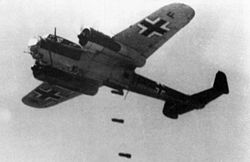
While the UK looked to be in a desperate position, it certainly wasn't standing alone. This is a fact that stands in contrast to British propaganda of the time, which sought to inspire their populace with images of a lone British Tommy standing boldly against the German horde.[162] While the UK was alone in Europe, it received extensive aid and manpower from its empire and the White Commonwealth, including what would become a massive volunteer force of 2.25 million Indian soldiers.[162] The UK recruited extensively from the black and brown-skinned men of its empire, attempting to excuse its prior treatment of these people by pointing out that the Nazis would be a far worse overlord.[162]
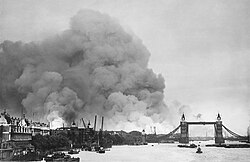
The Battle of Britain commenced in summer 1940 when the Luftwaffe began conducting air strikes on British military targets with the hope of gaining air superiority ahead of an invasion, the cobbled-together "Operation Sea Lion".[163] The British army had been forced to leave behind much of their heavy equipment at Dunkirk, and even bullets were in short supply.[164]
The Royal Navy, on the other hand, remained powerful. The UK also had strengthened its air defenses with anti-aircraft guns, searchlight teams, and decoy airfields.[164] Crucially, the British had the advantage of a coastal radar system that helped give some warning of Luftwaffe raids.[165] An influx of volunteers from conquered and neutral nations joined the ranks of the RAF. In all, 145 Poles, 88 Czechoslovaks, 29 Belgians, 13 Frenchmen, 10 Irish, 1 Austrian, and 11 United States pilots joined to fight to keep the UK standing.[166]
Seeking to destroy the Royal Air Force through attrition, the Luftwaffe mounted ceaseless attacks against British air bases, causing severe damage and forcing them to move further inland.[167] In late August, a German bomber mistakenly struck a civilian part of London, prompting the British to bomb Berlin in retaliation.[168] Enraged by the attack on Berlin, Hitler ordered the Luftwaffe to focus on hitting London and other cities. Although it caused terror among civilians, the so-called "London Blitz" was a strategic mistake on the part of the Germans. By focusing on the cities, the Luftwaffe stopped destroying the RAF's air bases and the nation's factories, allowing the British time to recover and rebuild their air force.[168] It also allowed the British to conduct retaliatory bombing raids on German cities. The Blitz failed to significantly disrupt the British war effort, but it inflicted the gruesome cost of 43,500 civilians killed.[169]
Struggle at sea[edit]

With invasion impossible and the air war turning against them, the Germans turned their attention to their blockade of the British Isles, hoping to starve the UK into surrender. This seemed to be a lot more possible in this war than the last. German submarines were much faster, much more advanced, and used much more skillfully.
By the end of 1940, they had sunk over a thousand merchant ships, consigning 6,000 sailors and nearly five million tons of merchant shipping to the depths with minimal losses to Germany.[170] The U-47 had also pulled off the shocking feat of sinking the battleship HMS Royal Oak by sneaking into the British port at Scapa Flow.[171] Admiral Karl Dönitz, leader of Germany's U-boat fleet, was primarily limited in his actions by the lack of available submarines. Hitler had largely ignored the strategic benefit of submarines, preferring instead to fund more visually impressive surface ships.
On top of this, the UK had lost the assistance of the French Navy and then had to bolster its presence in the Mediterranean due to the entry of Italy into the war. With the Royal Navy stretched so thin, there wasn't much they could do against the submarines during the early stages of the war. Churchill would later write that, "…the only thing that ever frightened me during the war was the U-boat peril".[172]
Realizing the potential for success, the Kriegsmarine also ordered its surface ships to conduct raiding operations as well. The German battlecruisers Scharnhorst and Gneisenau ventured forth to sink 22 Allied ships during the winter of 1941.[173] Converted merchant ships also served as raiders, sailing under neutral flags to preserve the element of surprise[174] (this was a war crime, but it's not like the Germans cared at this point).
The most formidable, though, was the freshly-constructed modern battleship Bismarck. The Bismarck launched its own raids and then infamously sunk the British battlecruiser HMS Hood when she sailed to intervene, albeit not without taking serious damage itself.[174] The Royal Navy, pissed off by this development, promptly hunted down and crippled the Bismarck by naval biplanes from the aircraft carrier HMS Ark Royal.[175] The Bismarck had to be scuttled and now lives on as the most overrated ship of the war.
More nations join the Axis[edit]
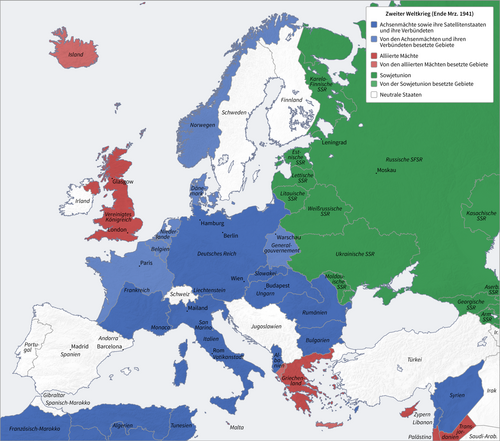
“”We have sided with the villains…
|
| —Hungarian Prime Minister Pál Teleki denounces Miklós Horthy's alliance with the Axis shortly before committing suicide.[176] |
German interests in the Balkans resulted in the quick expansion of the Axis Powers. Under the rule of former Austro-Hungarian admiral Miklós Horthy, adopted a policy of irredentism similar to Germany's Lebensraum, based on the fact that the Austro-Hungarian Empire had also been dismembered after World War One. Hitler wooed the Hungarians by giving them chunks of territory from southern Slovakia and Carpatho-Ukraine, and then the Germans arm-twisted Romania into surrendering Northern Transylvania (which had a large Hungarian population).[177] Hungary officially joined the Axis on 20 November 1940. The largely powerless Hungarian prime minister Pál Teleki vehemently opposed the alliance and believed that it would destroy Hungary, and he eventually committed suicide out of grief for failing to prevent it.[177] Teleki would, of course, eventually be proven right.
Despite being none too happy about losing territory to Hungary (and later Bulgaria), Romania also joined the Axis shortly after Hungary did. This was because the Romanians, while pissed at Hungary, were a lot more afraid of the big red communist threat sitting on their eastern border. Said communist threat had politely informed Romania on 26 June, 1940, that they wanted Bessarabia (now Moldova) to be returned to Russian rule after a couple of decades of being held by the Romanians or else the Red Army would stomp in and take it.[178] In accordance with the Molotov-Ribbentrop Pact, Hitler refused to take any phone calls from the Romanians on the matter, and the Romanians thus had no choice but to fold. The loss of so much territory caused a huge political crisis in Romania, culminating in a fascist coup led by Ion Antonescu and the Iron Guard movement, who promised to align Romania with the Axis and reclaim Bessarabia (plus interest) from the Soviet Union.[178] This was really Romania's best shot at this point, since neutrality hadn't worked for Belgium, the Allies were on the other side of the continent, and the Soviet Union were dirty fucking communists.
Romania proved to be the biggest catch for the Axis. The country was a major oil producer and had been since before the last war,[179] and having them on the Axis' side meant that they no longer needed to rely on the Soviet Union for their fuel. However, Romania was also one of the most adversely affected right out of the gate. Instead of paying for oil with goods or gold, Germany simply pumped currency into the Romanian economy, causing severe inflation.[178]
Bulgaria also joined the Axis, although they waited until March 1941 to do so. Bulgaria during the interwar years had fallen under a total royal dictatorship led by Tsar Boris III, who was predictably none too fond of the Soviet Union since monarchs and commies don't mix. On top of that, Bulgaria had also lost much land and privileges after the Great War and stood to benefit from Hitler tipping over the apple cart of interwar peace.[180] Thus, political realities made Boris' decision to join the Axis a fairly obvious one, especially since history repeated itself with the early stages of the German alliance not requiring Bulgaria to do anything really difficult (this would change).[181]
Growing Allied resistance[edit]

American aid[edit]
“”We must be the great arsenal of democracy. For us this is an emergency as serious as war itself. We must apply ourselves to our task with the same resolution, the same sense of urgency, the same spirit of patriotism and sacrifice as we would show were we at war. We have furnished the British great material support and we will furnish far more in the future… Their strength is growing. It is the strength of men and women who value their freedom more highly than they value their lives.
|
| —President Franklin D. Roosevelt, Fireside Chat, 29 December 1940.[182] |
During the early phases of the war, President Franklin Roosevelt firmly wanted to aid the UK and the Allies against German aggression. Unfortunately, his goals were harshly limited by the Neutrality Acts![]() . The US government, for instance, could not extend any credit to nations that had not fully repaid their debts from World War One, which included the UK.[183] As a result, the UK was forced to pay up-front in cash for any goods they wanted from the US and they had to assume the risk of transporting those goods on their own ships. No American sailors could risk their lives to supply another nation.
. The US government, for instance, could not extend any credit to nations that had not fully repaid their debts from World War One, which included the UK.[183] As a result, the UK was forced to pay up-front in cash for any goods they wanted from the US and they had to assume the risk of transporting those goods on their own ships. No American sailors could risk their lives to supply another nation.

There were other means of aiding the UK, however. On 2 September 1940, when the UK still feared German invasion, Roosevelt used executive authority to loan 50 old destroyers to the UK.[184] In order to make this legal, it was performed as part of a quid pro quo arrangement whereby the UK would give the US temporary ownership of its naval bases in the Western Hemisphere. As an added bonus, this meant the UK would no longer have to shoulder the burden of defending those bases. Many Republican Party Congressmen were pissed about this, and the infamous America First Committee![]() was founded just two days after the announcement of the deal.[184]
was founded just two days after the announcement of the deal.[184]
By 25 November, the up-front payment for goods stipulation had become a serious problem for the UK, as the British ambassador admitted to reporters (in essentially these exact words) that the UK was flat fucking broke at this point and couldn't afford to buy shit from the Americans anymore.[185] Churchill wasn't too happy with the frankness of the comment, but he did confirm the truth of the matter in a personal letter to Roosevelt. Shortly after, on 17 December, Roosevelt held a press conference in which he explained that the UK ordering American supplies was good for American business and proposed that this relationship continue via "lending" goods to the UK in the absence of payment.[186]
After a fierce political fight with the isolationists of the US Congress, Roosevelt managed to force the Lend-Lease Act![]() (subtitled "An Act to Promote the Defense of the United States") through Congress and placed his signature on it on 11 March 1941.[185] Roosevelt promptly established the Lend-Lease Administration and ordered vast quantities of food and war materials to be shipped to British ports. Along with the UK, China, Australia, New Zealand and various governments-in-exile were added to the list of recipients. Along with food and weapons, the US sent clothing, industrial chemicals, communications equipment, machine tools, and equipment for building roads and air strips.[185]
(subtitled "An Act to Promote the Defense of the United States") through Congress and placed his signature on it on 11 March 1941.[185] Roosevelt promptly established the Lend-Lease Administration and ordered vast quantities of food and war materials to be shipped to British ports. Along with the UK, China, Australia, New Zealand and various governments-in-exile were added to the list of recipients. Along with food and weapons, the US sent clothing, industrial chemicals, communications equipment, machine tools, and equipment for building roads and air strips.[185]
These arrangements, but most notably Lend-Lease, allowed the US to continue meeting the Allies' serious need for war supplies while keeping the US officially neutral.
Mussolini's Greek tragedy (and other misadventures)[edit]
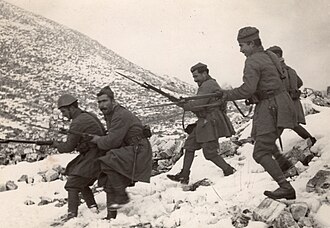
“”First they were too cowardly to take part. Now they are in a hurry so they can share the spoils.
|
| —Hitler's remarks on Italy's entry into the war.[187] |
After hastily declaring war on France, Italy immediately suffered raids from the British on their unprepared garrisons in Libya.[188] The Italian navy, the Regia Marina, also proved itself largely inadequate to face the British due to poor prewar preparation and shoddy leadership.[189] Most of its actions were either defeats or debatable victories if the German air force had helped out. One notable humiliation included the November 1940 British biplane air strike on Taranto which severely damaged three battleships, killed 700 people, and prevented Italy from contesting the Mediterranean.[190][note 2]. These failures were in spite of the fact that Italy had arguably outclassed the French navy before the war and produced the first modern fast battleships with the Littorio class.[191]
From the beginning of its involvement in the war, Mussolini's Italy was woefully outmatched by every other great power. They lacked much heavy industry, suffered shortages of most strategic goods, and their military and civilian bureaucracy was hopelessly inefficient.[192] This was demonstrated by Italy's unimpressive naval performance and the fact that the Italian invasion of France had netted all of 13 villages in the southern French Alps and caused worse casualties to them than the French.[193]
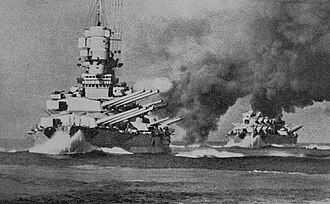
Mussolini made things worse for himself by abruptly declaring war on Greece on 28 October 1940 before his military had drafted any war plans and without bothering to inform Hitler.[193] This caught Mussolini's commanders and the Germans completely by surprise (Chief of Staff Pietro Badoglio was pissed) but ironically failed to do the same to the Greeks, as they had been preparing for this inevitable war since Mussolini had started mumbling about the Roman Empire in the 1930s.[194] Mussolini's impulsive and hasty decision was motivated by a desire to show up the Germans in military successes as well pay back Hitler for diplomatic meddling in the Balkans without asking Italy's permission.
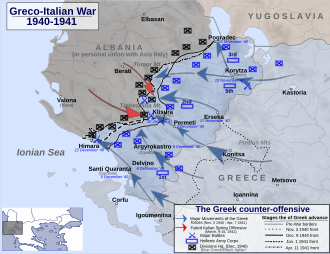
Italy based its invasion out of Albania, which it had annexed before the war.[195] Despite having numerical superiority, the Italians struggled against Mussolini's idiocy. As the disgusted Italian general Quirino Armellini noted in his diaries, "The Duce hasn’t the least idea of the differences between preparing war on flat terrain or in mountains, in summer or in winter. Still less does he worry about the fact that we lack weapons, ammunition, equipment, animals, raw materials."[193] Mussolini had also overridden Pietro Bagdolio's insistence that Italy would need at least three months to prepare the invasion and had even demobilized 600,000 troops to bring in the fall harvest.[193]
Italy had invaded during Greece's rainy season from a country that had little infrastructure to fight against a heavily fortified and mountainous country.[196] They did this with about half of the manpower Bagdolio had estimated would be necessary.[193] Mussolini had insisted, contrary to all available evidence, that Greece would collapse as rapidly as Poland or the Low Countries. Instead, Mussolini got hit with a humiliating reality check when the Greeks pushed the Italians all the way back into Albania in about a week of fighting.[193] The Italians knew they were in trouble even before this. Just a few days into the invasion, the best thing General Visconti Prasca could tell reporters was, "I am confident there is nothing to worry about."[193] (There was a lot to worry about).
The North African diversion[edit]

Italy's war in Northern Africa also began in similarly inauspicious circumstances. The Italians hoped to push out of their colony in Libya and invade Egypt, with the ultimate goal of shutting down the Suez Canal and depriving the UK of its oil imports from Iraq and Iran and its supplies from India and East Asia.[197] However, short of a fortnight after Italy entered the war, Italy's Air Marshal Italo Balbo (who had opposed the decision to go to war) got his ass blasted out of the sky by "friendly fire".[198] The Italian invasion of Egypt in September became a debacle due to a critical lack of supplies, and the British promptly punked the Italians in Operation Compass, taking over 138,000 Italian and Libyan prisoners, seizing huge stockpiles of equipment, and kicking them back to Libya.[199] Really bringing pride to Italy there, Mussolini.

After Italy got spanked in Egypt, Hitler sent General Erwin Rommel "the Desert Fox" and the Afrika Korps to bail them out. The Afrika Korps and its much mythologized leader have become even more overrated than the fucking Bismarck. Rommel was, in fact, a media creation who carefully staged photoshoots with his camera crews and ardently supported Adolf Hitler.[200] While Rommel was tactically gifted, he took no interest at all in the less glamorous science of logistics and the Afrika Korps thus suffered from supply shortages even worse than they had to.[200] This also puts to shame the myth of the awesome tank maneuvers which supposedly took place all the time in the desert; both sides spent a great deal of time in static defensive positions, anchored to their supply points.
In spring 1941, Rommel conducted his famous "drive across the desert" in which he pushed the British over 600 miles out of Libya and back to Egypt. However, he had left the fortified city of Tobruk in British hands to threaten his supply chain and ended up in the middle of the goddamn desert with nothing of use to show for it.[200] Chief of the General Staff Franz Halder at this point wrote that Rommel, "storms around all day long with formations strewn all over the place," and said that his campaign seemed to have been planned by a crazy person.[200] Indeed, Rommel's actions in the North African desert heavily featured armored thrusts to nowhere and bloodily failed attempts to seize British-held cities behind him.
On top of that, Rommel's "war without hate" was a lie. He fought fairly against the British but stood by as German forces persecuted Jews in Northern Africa and almost certainly possessed inside knowledge of the "Final Solution" without protest.[201] Rommel's staff also had contact with the Einsatzgruppen in Egypt, who were led by Walther Rauff, who had helped design the gas extermination van. The Einsatzgruppen committed atrocities in the Afrika Korps' wake and fully intended to carry out Hitler's orders to exterminate the 500,000 or more Jews of Palestine once Rommel managed to get there.[202] It is very lucky that logistical problems and Rommel's eventual defeat led to these events never occurring.
Germany sighs and goes to clean up the Balkans[edit]

In March 1941, Yugoslavia joined the Axis. This pro-Axis government was promptly toppled by a coup from the fiercely anti-Axis military.[203] Hitler hadn't wanted to make an enemy of Yugoslavia, remembering how surprisingly well Serbia managed to kick ass in World War One, but this show of defiance from Yugoslavia pissed him off enough to make him forget this fact.[204] Unfortunately, Yugoslavia was surrounded by Axis nations and fell within 11 days to a massive invasion from Germany, Hungary, Romania, and Bulgaria.[203] The Axis nations then partitioned Yugoslavia with a major emphasis on exploiting ethnic tensions to keep the fallen nation down.
6 April simultaneously saw German intervention into the Italian fuckup in Greece. Hitler initially wanted to stay out of the quagmire and let Mussolini deal with his own mistakes, but he changed his mind upon receiving reports that Mussolini was losing popularity among the Italian government and people. He feared that if Mussolini were toppled from leadership, Italy would be taken out of the war, and Germany would lose a major ally against the British.[205]
With the help of Bulgaria and with more forces coming through Yugoslavia, the Germans were able to invade Greece along a much longer front and overwhelm the Greek fortifications over three rough days of battle.[206] Athens fell on 27 April, but many Greek and Allied soldiers successfully evacuated to Crete. The subsequent German airborne assault on Crete was a disastrous victory as Greek and Allied forces kept shooting German paratroopers out of the sky.[207]
Germany had won victory on behalf of its Italian allies in Greece and secured the Balkans, but these diversions forced Germany to delay its plans of invading the Soviet Union.[208] However, most modern historians agree that delaying the invasion had no real detrimental effect on the Germans, since their failure to meet objectives would have happened regardless.[209] In fact, delaying may have helped the Germans, since Soviet intelligence had predicted the original date of the invasion, which then passed with no activity and further convinced the Soviet government to disbelieve reports of imminent German treachery.[210]
Allied invasion of Iraq[edit]

While the Allies grew stronger from American assistance and saw minor successes in North Africa, they hit another road block in May 1941. Iraq, previously little more than a British satellite providing much-needed oil to the Allies, had its government abruptly collapse amid an Axis-backed coup bringing the Golden Square movement into power.[211] The Golden Square resented the British Empire's control over Iraqi affairs and made "enemy of my enemy" overtures to the Axis. Many members of the Golden Square had also served against the British under the Ottoman Empire and were thus favorable towards their old German friends.[212] Hitler and Ribbentrop were both thrilled by this news and eagerly sought to open a new front against the British.
The British, for their part, saw this as a serious crisis but debated whether their already overstretched forces would be able to intervene in Iraq. Luckily for the British, India stepped up to the plate by sending an infantry division to land at Basra, a flanking tactic that caught the Iraqis by surprise and met with no resistance.[213] Facing a war on two fronts, the Iraqis appealed to the Axis for urgent air support and then launched a rapid and panicked infantry attack towards the Indians.[212] Complicating things even more for the Iraqis, the British garrison at Baghdad launched a surprise air offensive against the Iraqi forces near Basra.
With the Iraqis mired in the south, a British relief force from Palestine and the Arab Legion of Jordan invaded through the north and came to threaten Baghdad. A British interpreter, a Palestinian Arab whose name is sadly forgotten, sealed the deal by hopping on a captured Iraqi radio to make false reports of British tanks breaking into the capital.[212] These "ghost tanks" (since they didn't exist) sent the Golden Square into a panic and convinced them to flee the country. The Luftwaffe air wings who were sending aid Iraq also flew instead to Vichy-controlled Syria rather than risk destruction by the (again, nonexistent) British tanks. Iraq had fallen again, and the Germans thus had to double down on their plans to capture oil from another source: the Soviet Union.
Allied invasion of Iran[edit]

The British meddling in the Middle East wasn't isolated to Iraq.
At the start of the 20th century, oil was discovered in Iran. A wealthy British businessman was quick to ratify a treaty with Iran's![]() shah (king) that essentially gave that businessman largely unfettered, sole access to Iranian oil.[214] Around the start of World War I, with the British Navy switching over from coal-burning to oil-burning warships, Winston Churchill arranged for his government to buy a controlling stake in those oilfields, meaning the British government now directly controlled a rather large portion of Iran's oil production.[215][216] This would have absolutely no unintended side effects later. In the mid-1920s, the ruling Qajars were overthrown and replaced by a new dynasty; the new shah
shah (king) that essentially gave that businessman largely unfettered, sole access to Iranian oil.[214] Around the start of World War I, with the British Navy switching over from coal-burning to oil-burning warships, Winston Churchill arranged for his government to buy a controlling stake in those oilfields, meaning the British government now directly controlled a rather large portion of Iran's oil production.[215][216] This would have absolutely no unintended side effects later. In the mid-1920s, the ruling Qajars were overthrown and replaced by a new dynasty; the new shah![]() was less friendly towards the British.[217]
was less friendly towards the British.[217]
After World War II started, the British began exerting pressure on the shah to join the Allies but where he was still not overly fond of the British, he refused, and he may have even been a little sympathetic towards Hitler and Nazism.[218] After Operation Barbarossa began, suddenly the Soviets also had a reason to convince Iran to join their side - yet the shah still refused. The British, fearing that the German military would be able to capture enough of the Soviet Union to link up with Iran and thus gain access to that sweet, sweet Iranian oil, decided action needed to be taken.
Thus the British and Soviets demanded that the shah expel Germans[note 3] from his country, and he refused once again. So August 1941, the British and Soviet armies fully ignored the fact that Iran was neutral and launched a surprise invasion that easily crushed the weak and poorly-led Iranian military. The shah surrendered after only six days. The Soviets subsequently occupied a large portion of northern Iran, and the British occupied a large portion of the south.[219] The shah was removed from power and replaced by his pro-British son, Mohammad Reza Shah![]() ,[220] a change in leadership that would have major implications for the post-war world. The occupation lasted until 1946, after the war's end.
,[220] a change in leadership that would have major implications for the post-war world. The occupation lasted until 1946, after the war's end.
War without honor or humanity[edit]

Operation Barbarossa[edit]
“”We only have to kick in the door and the whole rotten structure will come crashing down.
|
| —Adolf "Life Comes At You Fast" Hitler.[221] |
On 22 June 1941, the Axis betrayed the Molotov-Ribbentrop Pact and launched Unternehmen Barbarossa, a massive invasion of the Soviet Union involving around 4.5 million soldiers.[222] Although often characterized as a mistake, Operation Barbarossa was the entire point of Hitler's expansionism in the east and his invasion of Poland. Hitler's concept of Lebensraum demanded that the Soviet Union be colonized by Germany in order to seize the "incalculable raw materials" in the Urals, the "rich forests" of Siberia, and the "incalculable farmlands" of the Ukraine.[223] Prepared in 1941 and confirmed in 1942, the Nazi "Generalplan Ost" called for, over a 10-year period, the extermination, expulsion, enslavement or Germanicisation of most or all Poles and East Slavs still living in Europe and projected the eventual expulsion and extermination of more than 50 million Slavs beyond the Ural mountains within 50 years with a small remainder to survive within Germany's borders to be used as slave labor.[224] Of course, this hideous plan for unthinkable genocide could only happen after the Soviet Union had been crushed. Thus, Operation Barbarossa.
Trusting of the Molotov-Ribbentrop Pact, the Soviet leadership and military command were taken completely by surprise. The Red Army had also been weakened by Stalin's purges. Its most visionary military theorist, Marshal Mikhail Tukhachevsky, had been executed in 1937 on false charges of treason to which he confessed under torture.[225] About 30,000 officers had been arrested, and many thousands of that number had been executed. As a result of the consequent poor leadership, the Red Army didn't have the same coordination between tanks, infantry, and air forces.[226] Red Army formations, generally lacking radios, would be caught off guard by rapid German armored thrusts and encircled.
The Red Army also started the war outnumbered by about 1 million men.[227] The Germans employed 138 divisions, and factoring in the forces of the other Axis partners (16 Finnish divisions, 15 Romanian, three Italian, two Slovakian, and a handful of Hungarian brigades), put the Axis forces well beyond what the Soviets were capable of countering at this point.[228]
However, the Red Army fought fiercely. The concept of mass Soviet surrenders and Soviet soldiers only able to fight due to the guns and threats of their commissars is a myth, just like the myth of Stalin going catatonic upon hearing the news.[229]

Rapid Axis invasion, 22 June to 25 August.

Autumn advances, 26 August to 5 December.
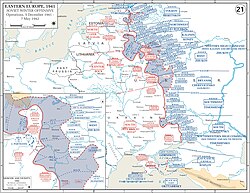
Soviet winter counteroffensive, 5 December to 7 May.

Soviet soldiers taken prisoner.
Desperate hours on the Eastern Front[edit]
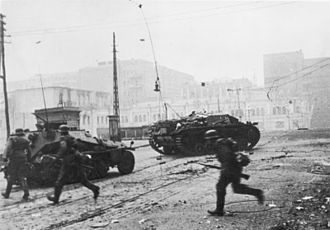
It's fairly common knowledge that the Soviet Union ate rocks during the opening weeks of the Eastern Front. One of the first major events in the invasion was the Battle of Białystok–Minsk in which the Red Army lost 420,000 men in a massive encirclement compared to just under 13,000 casualties on the Axis side.[230] Fuck. On 7 August, First Battle of Kiev saw another mega-encirclement in which the Red Army lost 600,000 soldiers compared to the Germans losing 45,000 men.[231] The focus on seizing Soviet industry in Ukraine, did, however, critically delay the German campaign to take Moscow.[232]
.jpg)
Finland had also joined the Germans in their attack due to the Soviet Union's continual attempts to infringe on their sovereignty,[233] and Finnish troops helped the Germans lay siege to the city of Leningrad, formerly St. Petersburg, the most important Soviet city in the northern part of the nation.[234] The siege was intended to starve the heavily fortified city, and in this it was successful, with most residents quickly being reduced to eating ersatz bread made with sawdust or cellulose.[235] People ate their pets, then ate leather, then ate cosmetics and wallpaper paste, and in some infamous cases, people ate dead bodies. The siege resulted in nearly 2 million deaths, or about 40% of the city's population.[236]

At the very end of September 1941, the Germans launched Operation Typhoon, the effort to take Moscow. Hitler stressed that time was essential, since he understood that the German military would be in serious shit if winter came down before they took the city. The Battle of Moscow began with another huge encirclement in which the Germans inflicted nearly a million casualties on the Soviets,[237] and the war seemed won. However, all was not as it seemed. Although hugely successful, the German advance had already run into severe problems. The Russian rainy season had come and turned the nation's roads into mud, and the Soviets had implemented a successful scorched earth policy which saw entire factories being dismantled and shipped eastward.[238] During the effort to take Moscow, the Germans struggled against the fall rains, and the Soviets were able to redeploy huge numbers of men to replace the losses they had suffered at the opening of the battle.[239] Led by the rising star Georgy Zhukov, the Red Army fought the Germans to a standstill by 6 December and began pushing them back on 12 December.[237] This was the first great ground defeat for the German war machine, but unlike in later battles, there was no lightning Soviet offensive to hammer home the advantage. Instead, the Germans fell back to lick their wounds, and by February, Hitler could honestly claim that "the danger of a panic in the 1812 sense" had been "eliminated".[237] The war would have to drag on for a long, bloody time.
Certain clueless Americans shall not be forgiven if they persist in thinking that the war began in late 1941 with the Japanese bombing of Pearl Harbor. They will also not be forgiven for thinking the US swooped in and single-handedly won the war in the time of a 14 episode miniseries, saving the world from fascism. To be blunt, Nazi Germany lost the war on the Eastern Front, suffering 80% of its war fatalities there and having to dedicate 75% of its ground forces to hold the line.[228] The world would be a much different place had the Soviet Union not stubbornly and bravely held its ground.
Unprecedented horror, unforgiveable crimes[edit]

“”The objective of this battle must be the demolition of present-day Russia and must therefore be conducted with unprecedented severity. Every military action must be guided in planning and execution by an iron resolution to exterminate the enemy remorselessly and totally.
|
| —General Erich Hoepner, Panzer Group 4:[240] |
Worst of all, since the Germans planned to commit genocide on the Slavic ethnicities, they had no problem committing a variety of hideous war crimes. On 6 June, before the invasion even started, Hitler issued the "Commissar Order", demanding the immediate summary execution of any Soviet political officers, denouncing them as representatives of "Judeo-Bolshevism".[241] The mass execution of prisoners, however, largely backfired due to the even more fanatical resistance it inspired among Red Army troops who believed that surrender would simply mean being murdered by the Germans. Even earlier, on 13 May, Hitler issued a directive stating that the war against the USSR would be unique and that no crimes committed by German troops against enemy civilians would therefore be punished.[242]
.jpg)
The Einsatzgruppen, who had proven themselves to be ruthless and efficient in committing massacres in Poland, greatly expanded their activities during this even more horrific phase of the war. They targeted Soviet officials, Roma, and above all Jews of either gender and any age. They murdered more than half a million people, the vast majority of them Jews, in the first nine months of the invasion.[243] On 29 September, they committed one of the most horrific acts of the early Holocaust by mass murdering 33,771 Jews outside of Kiev in an event known as the Babi Yar Massacre.[244] This was, distressingly, only one of a huge number of these mass shootings, which the Germans called Aktions. Used many thousands of times, the procedures for a mass shooting began with Jewish residents of an area being rounded up and forced to dig their own mass grave before the Einsatzgruppen shot them all in the backs of their necks to make them fall into the pit.[245] Alternatively, the murderers would employ what they called Sardinenpackung, or "sardine packing", in which they would make victims lie on the ground to be shot.[245] Dirt would be scattered thinly over the newly dead and the next victims were instructed to lie atop them, where they too were killed. Victims would often have to lie atop their murdered loved ones to be murdered themselves.
To fuel its war machine, Germany extensively used slave labor during the war, kidnapping an estimated 12 million Europeans.[246] Historian Ulrich Herbert of the University of Freiburg said, "Employment of foreign forced laborers was not only limited to large-scale enterprises. It was applied throughout the whole economy; from the small farm and locksmith's shop with just six workers, to the national railway system, the local authority districts, the big armament companies and also many private households."[246]
Soviet POWs were also horribly and intentionally mistreated, with around 3.5 million people dying due to death marches, massacres, and concentration camp conditions.[247] The Germans abducted millions of people from occupied Poland and the Soviet Union to serve as slaves for German industry.[248] Despite their claims of upholding racial purity, the Nazis still went ahead and created camps for their soldiers to visit enslaved Slavic women to rape.[249] So many pregnancies occurred due to rape that Germany had to create "birthing centers" to dispose of the unwanted children, in which about 90% of the handled infants died due to neglect.[250]
Atrocities during the outset of war set the stage for the death camps of the Holocaust. Before this, Hitler and his government weren't sure that the SS and other German units would be willing to commit mass murder on such a scale, but these huge massacres removed any doubts and allowed full planning for the genocide to proceed.[251]
Outbreak in the Pacific[edit]
_burning_after_the_Japanese_attack_on_Pearl_Harbor_-_NARA_195617_-_Edit.jpg)
“”In the first six to twelve months of a war with the United States and Great Britain, I will run wild and win victory upon victory. But then, if the war continues after that, I have no expectation of success.
|
| —Admiral Yamamoto Isoroku, the man who planned Pearl Harbor.[252] |
Pearl Harbor[edit]
While Hitler was stomping on Europe, Japan was reaching the limit of its ability in the ongoing war against China. Much of this was attributable to the United States growing less willing to continue selling resources to fuel the Japanese war machine in light of continued hideous Japanese war crimes. In response to tensions between the two governments, Japan itself abrogated many of its trade agreements with the US in January 1940, giving Roosevelt even broader ability to restrict the flow of militarily useful goods to Japan.[253]
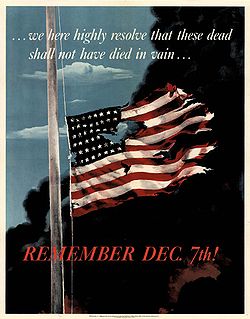
The resulting shortages of strategic goods convinced Japan to pounce on the fallen Vichy France's colonies in Indochina, which further angered the US since that move threatened a major source of rubber imports.[254] With Japan positioning its forces in Indochina in an apparent preparation for an invasion of Allied European colonies in the region, Roosevelt froze Japanese assets in the US and placed an embargo on oil exports to Japan, meaning that the Japanese war effort was going to be in deep shit unless they could find another supply of fuel for their tanks, planes and ships.[255]
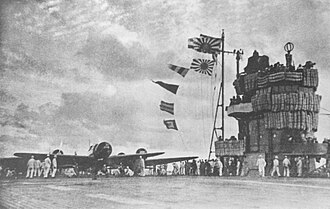
War against the Allies was inevitable at this point, so the problem for Japan was in winning it. Enter the genius Admiral Yamamoto Isoroku, who had commanded the aircraft carrier Akagi for much of his career and went on to revolutionize naval warfare with his use of carrier air power.[256] Yamamoto presented his proposal for a surprise attack on the US Pacific Fleet based at Pearl Harbor in Hawaii, which he believed would be Japan's only real shot at taking down the American behemoth (a war which he personally opposed). Were Japan to cripple the Pacific Fleet, it could launch a lightning campaign of conquest across East Asia without American interference.[256] By the time the US responded, Japan would be in a much better position in terms of resources and military assets.
The Japanese were aided by American peacetime military incompetence which was fueled by a racist underestimation of Japan's capabilities.[257] Yamamoto's attack fleet included all six of Japan's full-sized aircraft carriers: Akagi, Kaga, Soryu, Hiryu, Shokaku, and Zuikaku.[258] After sailing under strict radio silence, the carriers dispatched their planes on 7 December 1941, reaching the US fleet and breaking radio silence to give the coded message indicating a successful surprise: "Tora! Tora! Tora!"[256] Unfortunately for the Japanese, while the attack largely went off without a hitch, America's aircraft carriers were not in the harbor at the time of the attack (a fact which greatly distressed Yamamoto).[259] The Japanese force also failed to destroy US repair ships or oil reserves, ensuring a relatively quick recovery. Nonetheless, the attack killed almost 3,000 Americans, sunk four US battleships (one, the USS Arizona, could not be raised) and enraged the US public.[260]
The US Congress quickly declared war at the urging of President Roosevelt, who declared 7 December, "a date which will live in infamy".[261] Even before then Canada proved it was the USA's best friend when its cabinet resolved to declare war several hours before anyone else made it official.[262] Nazi Germany then declared war on the US, apparently believing that now was as good a time as any to leap into confrontation with the Allies' longtime background supporter.[263]
"Tora! Tora! Tora!"[edit]
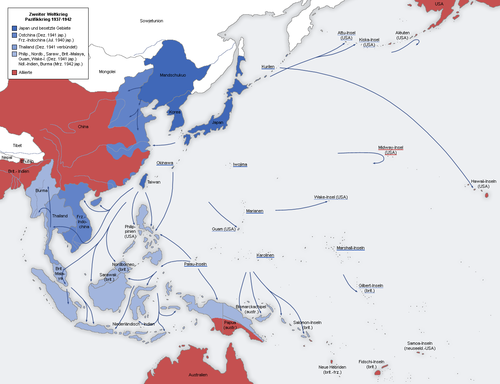
Just a day after Pearl Harbor, Japan launched its explosive campaign of violence upon the rest of the eastern Pacific. Hong Kong, the British Empire's jewel of the Far East, fell within days, as its commanders dismissed warnings of how ill-prepared they were as "unpatriotic".[264] Japanese forces raped civilian women, forced British officers to dig their own graves before execution, and bayoneted wounded men in their hospital beds.[265] On 10 December, Japan demonstrated the supremacy of naval air power by sinking the battlecruiser HMS Repulse and the modern battleship HMS Prince of Wales in two massive defeats for the Royal Navy.[266]
The Japanese onslaught also hit the US hard as well, despite the US having been warned by the huge fucking disaster at Pearl Harbor. Japanese forces overran the lightly-defended Guam on 10 December.[267] A day after Pearl Harbor, US planes in its then-territory of the Philippines were caught on the ground and destroyed by a Japanese strike.[268] The US navy was forced to withdraw by Japanese aerial attacks, and Japanese soldiers landed in the Philippines. General Douglas MacArthur, commander of US and Filipino forces, favored an aggressive attack to meet the Japanese despite being ill-prepared, and the resulting engagements were great defeats for the US.[269] MacArthur's forces had to withdraw west of the Philippine capital of Manila into the Bataan Peninsula, but MacArthur's insistence on offensive actions meant that Bataan had not been fortified as originally planned.[269] In March 1942, Bataan fell, the US and Filipino forces surrendered, and MacArthur was ordered to flee to Australia to avoid capture.[269] Japanese forces marched the roughly 64,000 Filipinos and 12,000 Americans over 60 kilometers without food or water and murdering the stragglers, killing an estimated 7,000 prisoners.[269]
Things went from bad to worse for the Allies when British colonial incompetence (they had actually predicted exactly where and when the invasion would happen and managed to lose anyway) resulted in the fall of Malaysia and Singapore (then-British Malaya and Straits Settlements) on 15 February 1942.[270] This effectively forced the British Empire out of the eastern Pacific and placed Australia at serious risk. Then, on 8 March, the Dutch East Indies (now Indonesia) capitulated to Japan, depriving the Allies of a major source of oil, aluminum, and rubber.[271] Tens of thousands of Dutchmen and Indonesians became prisoners, and the Japanese forced much of the Indonesian population into slave labor. Many Allied POWs who survived the brutality of their capture had to endure "hell ships" — overcrowded cargo vessels without air, space, light, bathroom facilities, or water — that the Japanese packed them into to be sent as slave labor for the Home Islands.[272]
Perhaps most severe was the abrupt loss of the Allied supply of rubber, a required component for automobiles, aircrafts, many warships, and tanks.[273] Unlike with other resource shortages, there was no alternative source. The regions Japan had captured accounted for 90% of the world's supply (the plantations in the Belgian Congo having long ago declined).[273] This problem could only be addressed with synthetic alternatives as well as a frantic rush to gather up as much leftover domestic civilian rubber as possible.[274]
These easy victories over the unprepared Western Allies left Japan overconfident and overextended.[275]

Japanese infantry rush into Hong Kong, December 1941.

Crewmen flee the sinking HMS Prince of Wales, December 1941.
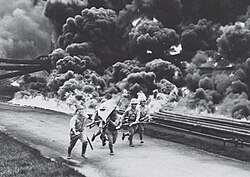
Japanese troops in a burning oil facility in Borneo, January 1942.
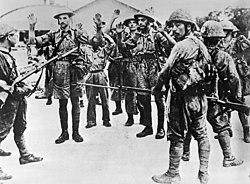
British soldiers at gunpoint in Singapore, February 1942.

US and Filipino prisoners carry their dead during the Bataan Death March, May 1942.
The giant is awake and angry[edit]
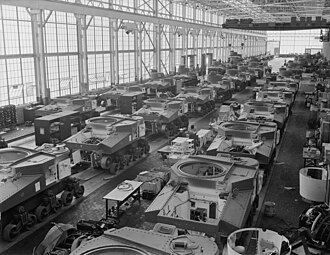
“”If you are going to try to go to war, or to prepare for war, in a capitalist country, you have got to let business make money out of the process or business won’t work.
|
| —Henry L. Stimson, US Secretary of War.[276] |
It's fairly obvious to say that the US public was very goddamn pissed off by these developments. After the sudden deaths of almost 3,000 Americans at Pearl Harbor, news kept coming in of US colonies being attacked and US prisoners being abused by the invader. Urged on by President Roosevelt, the US began to heave itself out of the Great Depression in order to kick some ass and get some revenge. Admiral Yamamoto's (contested[277]) statement that Japan had woken a "sleeping giant" was about to come true.

US war production was unique in being far less centralized than in any other nation; civilian industrialists generally controlled the mobilization agencies in order to ensure profitability for their businesses.[278] Taxation expanded dramatically as the US government widened the number of Americans required to pay; they also introduced the now-familiar paycheck withholdings.[278] Taxes could only fund part of the massive war effort, however. Thus, the government also introduced war bonds, which would return a small amount of interest in exchange for an initial investment in the government's war effort.[278] Patriotic Americans could purchase them to help the war, knowing that the bond would turn a profit later.
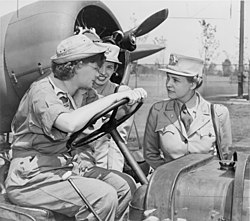
Volunteers and conscription from a furious nation also swelled the ranks of the US military to 15,100,000.[279] On 14 May, Roosevelt also authorized the creation of the Women's Auxiliary Army Corps (later dropping the "Auxiliary" to give women the same privileges in the Army as men), allowing women to serve in advanced roles like weather observers, electrical specialists, airplane and radio mechanics, financial services, driving, and record-keeping.[280] This also became a testbed for racial integration, as black women, Japanese-American women, and white women were all allowed to train together.[280]
On a much darker note, US suspicion towards Japanese-Americans resulted in a widespread public demand for them to be incarcerated until the war's conclusion. On 19 February, Roosevelt signed the Executive Order 9066, giving the War Department authority to move people out of any land they deemed a "military area".[281] This was a clear legal cover for the US military to force Japanese-Americans away from the Pacific coastline where they could potentially sabotage the war effort. But the question arose of where to put them. Montana governor Sam C. Ford refused to have any Japanese-Americans resettled in his state, claiming, "Our people cannot tell an American-born Japanese from an alien. When casualty lists start coming in… I fear for the safety of any Japanese in this state."[281] Idaho Attorney General Bert Miller was far blunter: "We want to keep this a white man’s country. All Japanese [should] be put in concentration camps for the remainder of the war."[281] In the end, this is what the US government did. Japanese-American families had a few days to gather their belongings before reporting to US authorities, who would then place them in overcrowded camps in the mountains or deserts which provided little protection against the elements.[281] No Japanese-American espionage had ever occurred or would ever occur throughout the war.
The Allies stand together![edit]

“”There's a great and a bloody fight / 'round this whole world tonight / And the battle, the bombs and shrapnel reign / Hitler told the world around he would tear our union down / But our union's gonna break them slavery chains / Our union's gonna break them slavery chains
I walked up on a mountain in the middle of the sky / Could see every farm and every town / I could see all the people in this whole wide world / That's the union that'll tear the fascists down, down, down |
| —Woody Guthrie |
Declaration by United Nations[edit]
With the entry of the Soviet Union and the United States into the struggle against the Nazi Germany, the British Commonwealth was no longer the primary geopolitical organization in opposition to the Axis. A new organization guiding international cooperation would have to form. In late December 1941, Winston Churchill and much of his staff traveled to Washington DC to meet Roosevelt and the US government in order to lay the groundwork for their future collaboration as wartime allies. US Army Chief of Staff General George Marshall and his right hand Brigadier General Dwight Eisenhower both insisted that unity of command would be essential to victory. In an unprecedented move, the US and UK agreed to form the Combined Chiefs of Staff to serve as the supreme Allied command structure.[283] Both the US and UK had four commanders each in the supreme command, and both sides reorganized their own military structures to assist collaboration. Furthermore Churchill and Roosevelt both confirmed their conviction that Nazi Germany was the greatest threat of the Axis, and Europe therefore had to be dealt with before Japan.[283]
On 1 January 1942, the grand Alliance formalized itself when the 26 nations at war with Nazi Germany signed the "Declaration by United Nations", a resolution to remain at war with the Axis until victory was assured.[284] The United Nations became the official name of the Allies. These nations naturally included the "Big Four" of the UK, USA, USSR, and China along with the various governments-in-exile which had been forced from their homelands by the Axis.
In addition to the belligerents everyone knows about, by 11 December, many nations in Latin America had declared war on the Axis in solidarity with the United States.[285] Latin American governments which didn't leap into the war did take measures like freezing Axis assets or offering use of air fields and labor to demonstrate their alignment with the US and Allied cause.
The original signatories of the Declaration by United Nations, who thus became the first of the Allies, were:[286]
- United States
- United Kingdom
- Soviet Union
- Nationalist China
- Australia
- Canada
- New Zealand
- South Africa
- Costa Rica
- Cuba
- Dominican Republic
- El Salvador
- Guatemala
- Haiti
- Honduras
- Nicaragua
- Panama
- Belgium (in-exile)
- Czechoslovakia (in-exile)
- Greece (in-exile)
- Luxembourg (in-exile)
- Netherlands (in-exile)
- Norway (in-exile)
- Poland (in-exile)
- Yugoslavia (in-exile)
- The British Raj (India)
Unlikely partners: Western aid to the Soviets[edit]
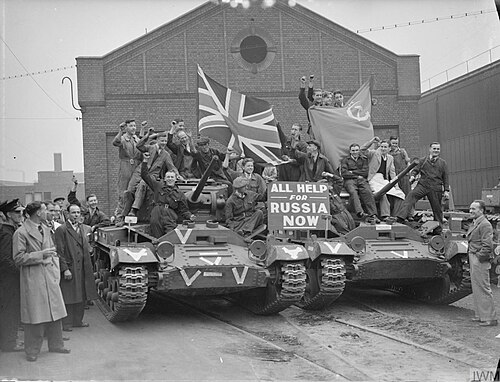
“”Britain and the USA did everything to provide us with material assistance of all kinds... It was, of course, not generosity on the part of Britain and the United States, and not that they wanted to help the peoples of the Soviet Union, not at all. They helped us to grind the manpower of the common enemy. Thus, they fought with our hands, our blood against Nazi Germany. [Stalin] directly said that if the United States had not helped us, we would not have won this war: face to face with Nazi Germany, we would not have withstood its onslaught and lost the war.
|
| —Nikita Khruschev, "Post-War Reflections."[287] |
As recently as the Winter War, the US and the USSR were on very bad terms. This was unsurprising. What was surprising at that point was how quickly Roosevelt 180° turned from denouncing the Soviets as one of the worst dictatorships in the world to blocking Congressional attempts to deny weapons to them.[288] Shared antipathy between the capitalist and communist worlds rested on a very solid base for both sides, but this enmity had to be put on hold in light of Nazi Germany's threat to everyone.
Even before Pearl Harbor, the Soviet Union was a beneficiary of the Lend-Lease Act. Throughout the war, the US provided the Soviets with more than 400,000 jeeps and trucks, 14,000 aircraft, 8,000 tractors and construction vehicles, and 13,000 battle tanks.[289] That was all well and good, but the USSR was more than capable of making its own tanks and military vehicles. However, Lend-Lease also helped cover more civilian-oriented areas of production that had been neglected by Stalin in his drive for a militarized state. These materials included medical supplies, clothing, high octane fuel, aluminum, copper, radios, locomotives and rails, and explosives. Western aid accounted for 55% of the aluminum the Soviets used during the war, along with 80% of the copper, 57% of its aviation fuel, and a full 35% of the Red Army's vehicles.[289] Lend-Lease also provided 35,000 radio sets, 1.5 million blankets, 4.5 million tons of food, and 15 million pairs of boots.[289] For its part, the UK supplied, 5,218 tanks (including 1,388 from Canada), 7,411 aircraft (including 3,129 from the US), and £120 million of raw materials, foodstuffs, machinery, industrial plant, medical supplies and hospital equipment.[290]
In the absence of Western aid, the Soviet Union would have had to scrabble within its own borders to produce these goods itself, which would have cost precious time and resources better used for fighting the Germans. A less supplied and more disorganized Red Army would have lost many more lives to the ruthless German onslaught. And - by the same token - the Germans would have then had more resources to fight the Western Allies.
China's bloody fight for freedom[edit]

Since 1937, China had struggled defiantly against the onslaught of the Empire of Japan. It stood alone until 1941, when Japan's abrupt offensives against the Allies bought it the attention of Western nations which had previously considered its plight to be of distant importance. Despite China's lack of industrial resources, its forces were able to tie down over 600,000 Japanese soldiers for the duration of the war and burn through staggering amounts of Japan's industrial output.[291] These resources and men would otherwise have been brought to bear against the Western Allies; China's contribution to the war was thus invaluable. Roosevelt recognized this in declaring China to be one of the United Nations' Big Four, although part of his motivation was to have China stand as a bulwark against the Soviet Union.[292]
After Pearl Harbor, American propaganda lionized China's resistance to Japan and decried Japanese atrocities. United China Relief, a charity founded in 1941, emphasized the newfound belief that China would someday soon become a pivotal nation whose friendship was the key to the future.[293] Soong Mei-ling, Chiang Kai-shek's American-educated wife, was crucial in reaching out to the US government and became the first Chinese person (and second woman) in history to deliver an address before the US Congress.[293]
The Chinese military also helped organize resistance in Vietnam to Japanese occupation.[294] Although they strengthened Vietnamese resistance, Chinese forces also helped set the stage for future events by refusing to cooperate with Vietnamese communists and thus inflaming tensions in the region.[295]
In order to keep China in the fight, the Allies had to supply its forces. China's industrial capacity at that point was just too small. First, the Allies used the Burma Road, a twisting path through precarious mountains that linked Burma to southern China.[296] It had been built by the tireless labor of 200,000 Chinese workers, and it became the lifeline through which the Allies would funnel weapons, resources, and food to fuel China's resistance. It was an extremely difficult drive.
Unfortunately, the Burma Road fell to a Japanese offensive action, so supplying China had to be done through "The Hump".[note 4] This was an air route that cargo planes had to fly over the Himalaya Mountains, and it was insanely fucking dangerous. The sheer edges and jagged peaks of the Himalayas generated unpredictable weather conditions, especially sudden winds which could toss planes up and down thousands of feet.[297] One portion of the path involved flying through a canyon whose exit was extremely difficult to find. The Hump claimed the lives of 1,000 men and destroyed 600 planes and played a vital role in keeping China in the war.[297]
The Holocaust[edit]
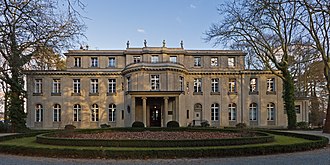
The Wannsee Conference[edit]
When Hitler declared war on the US, he did so in part because he believed that the American government was secretly controlled by Jews.[298] Shortly afterward, Hitler decided that this new Jewish-instigated crisis was too much to be tolerated, and he resolved to see Jews exterminated as a people.
On 20 January 1942, deputy head of the SS, Reinhard Heydrich, assembled a meeting of senior Reich officials at the Berlin suburb of Wannsee in order to discuss how best to transform Germany's prior massacres into a plan for industrial genocide.[299] Heydrich used the term Endlösung der Judenfrage, or "Final Solution to the Jewish Question", to describe the plan of action the conference agreed to put into action. This plan was, as Eichmann's minutes report, was:[300]
“”Under proper guidance, in the course of the final solution the Jews are to be allocated for appropriate labor in the East. Able-bodied Jews, separated according to sex, will be taken in large work columns to these areas for work on roads, in the course of which action doubtless a large portion will be eliminated by natural causes. The possible final remnant will, since it will undoubtedly consist of the most resistant portion, have to be treated accordingly, because it is the product of natural selection and would, if released, act as the seed of a new Jewish revival.
|
The death camps[edit]
_3b.jpg)
“”There are different methods of execution. People are shot by firing squads, killed by an "air hammer", and poisoned by gas in special gas chambers. Prisoners condemned to death by the Gestapo are murdered by the first two methods. The third method, the gas chamber, is employed for those who are ill or incapable of work and those who have been brought in transports especially for the purpose.
|
| —Conclusion of the Polish report on Auschwitz.[301] |
British-trained Czech agents blew Heydrich the fuck up with a grenade (and it couldn't have happened to a nicer guy) on 27 May.[302] The Germans unleashed a wave of mass killings upon the Czech population in retaliation, and the assassination failed to put a stop to Heydrich's plans. In the immediate wake of the Wannsee decision, the Nazi government immediately started constructing extermination camps and expanding existing concentration camps. The death camps started opening throughout 1942, and they used gas chambers as their primary means of mass murder. Victims arrived in trains, having been deported from other parts of Europe, and roughly 20% were selected for forced labor.[303]:219–220 The rest were sent to gas chambers disguised as communal showers, where they were locked in and gassed to death with either carbon monoxide or the pesticide Zyklon-B.
Termed Aktion Reinhard to honor the man after his death, the plan to genocide all Jews in occupied Poland commenced with the opening of three death camps: Bełżec, Sobibór, and Treblinka. In total, the Reinhard camps were able to murder approximately 1.5 million Jews, and related mass shootings resulted in another 200,000 deaths.[304] The largest and most infamous of the death camps was Auschwitz, which had begun as a prison camp for captured Poles before being expanded.[305] Approximately 1.1 million people were murdered in Auschwitz, and those not immediately selected for killing had to endure forced labor in starvation conditions or even human experimentation.[305]
The Allies, and thus the wider world, discovered the extent of Germany's horrific actions when Witold Pilecki, a member of the Polish Home Army and a goddamn hero, deliberately got himself captured and sent to Auschwitz in order to smuggle out evidence of its operations.[306] His reports reached the Polish exiled government, which compiled a report and distributed it to the other Allies.[301] These and other accounts would be confirmed as the Allies began liberating Europe from Nazi oppression, uncovering the victims and facilities of the Holocaust.
The Axis still pushes forward[edit]

The Burma bloodbath[edit]
At the outset of its war with the UK, Japan had invaded Burma through the territory of its ally Thailand in January 1942 (and boy did they invade a fuck of a lot of places in 1942, looking at it). This invasion put the British Raj, the jewel in Britain's crown, under direct threat. While this invasion sought to and succeeded in severing the Burma Road supply connection to China, it also had the aim of sparking an anti-British uprising in India.[307] Japan presented itself as a liberating force seeking to help Asians escape the shackles of the British Empire (under the Greater East Asia Co-Prosperity Sphere), and many Burmese bought the message. The first of the Burmese to do so were the "Thirty Comrades", led by a man named Thakin Aung San, and these men later formed the Burma Independence Army (BIA) to fight against the British.[308] This helped turn the Burmese front into an ethnic war, as Burma's ethnic minorities decided that the British were a superior alternative to potentially being stomped on by the majority ethnic Burmese.[308] (Look at our Burma article to see why they were probably right).
Burma proved to be a hellish place to fight in. Commonwealth forces had to contend with disease, impenetrable jungle, poor roads, Japanese air superiority, and many thousands of refugees fleeing the war.[309] The Japanese advance put them at the gates of Rangoon, at the time Burma's colonial capital. The British evacuated the city, but in so doing destroyed oil fields, vehicles, and homes in order to deny their use to Japanese forces.[310]
Australia threatened[edit]

Japan's initial series of rapid offensives throughout the eastern Pacific also targeted Australia's territories of Papua and New Guinea (now combined into Papua New Guinea). Japan began capturing territory in the region as early as January 1942, and later launched air raids against Australian cities and ships.[311] This put them right on Australia's doorstep and was part of a broader strategy by Japan to eliminate Australia as a threat by either compelling its surrender or staging an actual invasion. By invading New Guinea, the Japanese hoped to sever Australia's naval routes to the other Allies.[312] For the Allies, on the other hand, Australia and New Guinea would be vital staging points for a reconquest of the Pacific.
,_8_May_1942_(80-G-16651).jpg)
The New Guinea campaign became one of the absolute shittiest fronts of the war thanks to dense jungles, hellish heat, gruesome diseases, and fanatical Japanese fighting.[313] Indigenous peoples of New Guinea, however, bore the worst suffering by far. When Japan invaded, the Japanese viewed the indigenous people as subhuman and set about enslaving the men, stealing food, and killing anyone who resisted.[313] The Australians treated them better in that the indigenous weren't to be brutalized, but the Australians were still quite happy to force them into labor.[313] This still happened even after the Australians realized that the indigenous people would treat their men with great kindness, giving food and shelter and asking no reward. In some parts, as many as 25% of the indigenous people perished.[313]
Obsessed with holding New Guinea, the Japanese funneled a vast number of troops, ships, and warplanes into the fight. These resources were taken from other fronts, Japanese generals after the war all considered this campaign to be one of the major points that cost them the war.[314] General MacArthur, in command of the Americans, was equally fixated on New Guinea. He had vowed to return to the Philippines, and New Guinea was to be his first step. However, Japanese resistance to American offensives was tenacious and deadly. MacArthur instead opted to surround enemy strongpoints and starve them into submission in order to spare the lives of his own men.[314] This was a terrible part of the war for all sides.
Equally desperate was the struggle at sea, and things weren't looking so hot for the Allies. On 27 February, the American, British, Dutch, and Australian fleets trying to halt the invasion of the Dutch East Indies suffered a catastrophic defeat that eventually cost them most of their naval assets in the Eastern Pacific.[315] The Imperial Japanese Navy had, at this point, yet to suffer a defeat. This trend would seemingly hold true when Australian and American forces confronted the Japanese in the Coral Sea on 4 May. The Battle of the Coral Sea was the first time any of the US carriers that had escaped Pearl Harbor would have an opportunity for revenge against Japan's carriers. Informed by codebreakers who had intercepted and decoded Japanese transmissions, the USS Lexington and USS Yorktown confronted the Shokaku and Zuikaku, which had attacked Pearl Harbor. Unfortunately, this proved to be a tactical defeat for the Americans, as the Lexington exploded and sank due to torpedo attacks.[316] This was a severe blow to American morale just months after Pearl Harbor. Although believing they had suffered just a setback, the Japanese had to put both of their carriers down for repairs.
Germany's onslaught for oil[edit]
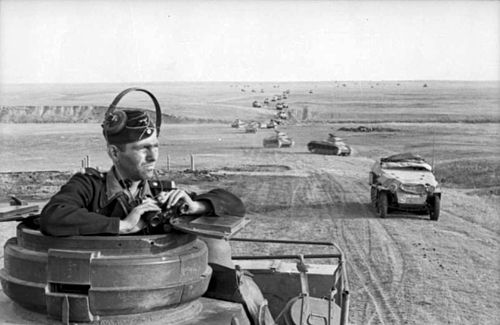
Hitler wasn't a total dumbass: he recognized after the failure at Moscow that Germany was locked in a war of attrition. Although the Battle of Moscow was a devastating defeat for Nazi Germany, it was far from decisive, and the Wehrmacht was able to hold on to its gains for most of 1942 even against the Red Army's fiercest counterattacks.[317] Hitler thus ordered an offensive called Fall Blau, or Case Blue, against eastern Ukraine and southern Russia with the goal of putting the Wehrmacht in control of Russian oil fields in the Caucasus and the Azerbaijan SSR.[318] Germany had previously fueled its war machine by importing oil from the Soviet Union and Romania. As early as the end of 1941, Romania had warned Germany that its oil output could not be increased enough to meet the Axis alliance's current demands.[319] Germany would have to restore the flow of black gold from the Soviets, and that meant taking it by force.
Launched on 28 June 1942, Fall Blau was initially very successful.[320] Assisted by German air strikes, the army overwhelmed Soviet defenses and swept towards the south despite beginning to run into serious fuel shortages. The Soviets, for their part, had been once again caught by surprise. They had captured a copy of the German plans, but Stalin believed this to be a ruse meant to draw Soviet forces away from a renewed assault on Moscow.[321] Through the month of July, the Red Army lost almost 570,000 men, a staggering amount on top of what the Germans had already inflicted during Barbarossa.[322]
Meanwhile, the Red Army further wasted itself by waging an offensive action to push German forces further away from Moscow. The city of Rzhev, still in German hands, had been placed at the end of a salient by determined Red Army counterattacks and now seemed to present an attractive target.[323] This ghastly battle, termed the "Rzhev Meat Grinder", lasted throughout 1942 and stunned all participants who saw how the ground would be absolutely covered in corpses.[324] The Soviet assault had been hasty and ill-prepared, and this blood-soaked operation failed in its objectives.
On the other hand, the Germans near the end of Fall Blau had run into some serious headaches of their own. By the end of July, German armored formations were sitting around with their dicks in their hands for days on end despite facing nothing but retreating soldiers and open steppe—entirely due to a lack of fuel needed for their machines.[322] A lack of infrastructure and a failure to prioritize between objectives also meant that German forces in the south were receiving only half of the supplies they needed.[322] The Luftwaffe were also having to spend precious time and effort delivering 200 tons of petrol every day to help keep the tanks running.[322] Even having advanced so far into enemy territory, the Germans seemed on the brink of some huge disaster. But surely that would never happen to the invincible Wehrmacht, right, Wehraboos? Right?
The Rzhev Meat Grinder, a clean-looking map which hides much blood.

Red Army gun crew mired in the mud at Rzhev.

The (seemingly) impressive progress of Fall Blau, 7 May to 18 November.
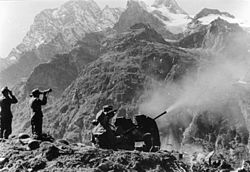
German artillery in the Caucasus, September.
Turning the tide[edit]
“”Your name is unknown, your deed is immortal.
|
| —Inscription at the Tomb of the Unknown Soldier of Moscow.[325] |
Japan's time begins to run out[edit]
_during_the_Battle_of_the_Santa_Cruz_Islands_on_26_October_1942_(80-G-30198).jpg)
As Admiral Yamamoto had predicted, Japan's dominance at sea would come to an end. In order to forestall that eventuality, the Imperial Japanese Navy decided to launch an attack on the island of Midway and use it to launch a second aerial attack on Pearl Harbor.[327] Unfortunately for them, US codebreakers had deciphered the orders for this attack, and the US Navy thus knew it was coming. All three of the remaining US fleet carriers, Yorktown, Hornet, and Enterprise, were there to confront the Japanese force. They caught the Japanese by surprise, sinking the carriers Akagi, Kaga and Soryu, all of which had perpetrated the attack on Pearl Harbor.[328] The US had finally won its vengeance for the attack. Unfortunately, the Hiryu launched planes which managed to sink the USS Yorktown, preventing this from becoming an overwhelming US victory.[327] Hiryu would herself be sunk by the Enterprise.
Japan's naval forces were devastated by the loss of four aircraft carriers, assets which their limited industrial capacity could not quickly replace. Japanese airmen and seamen rescued from the sea by US ships were interrogated for vital information about future Japanese plans. The aftermath of the battle saw the initiative shift to the Americans and gave the US Navy an advantage going into the Guadalcanal offensive campaign in the Solomon Islands.[329] Guadalcanal, which lasted for the rest of 1943, finally settled accounts in New Guinea as the US' first major offensive action in the Pacific. Being the first action of its kind the US conducted in the war, it was rife with many American fuckups. The US did not have proper resources on the beaches to move men and supplies inland and repeatedly failed to deal with the poor infrastructure and horrendous terrain of the islands.[330]
Luckily, the indigenous Solomon Islanders fought alongside US forces, providing crucial intelligence behind enemy lines and helping soldiers navigate the terrain.[331] Solomon Islanders even rescued future president John F. Kennedy, who had been stranded after his squad's patrol boat sank.[332]
Guadalcanal also caused chaos at sea when the Japanese tried to stop the US Navy from supplying the American invasion. At the Battle of the Santa Cruz Islands, the Japanese won another victory at sea by sinking the carrier USS Hornet.[333] Further operations cost Japan heavily in terms of trained pilots which they could not easily replace.
Stalingrad: Germany's first great catastrophe[edit]
.jpg)
Meanwhile, Germany was attempting to bring Fall Blau to a successful conclusion. In order to do that, they needed to capture the vital city of Stalingrad, which controlled transportation to the Caucasus oil fields and had a commanding position on the Volga River.[334] Stalingrad also bore the name of Joseph Stalin, who had defended it during the Russian Civil War. Capturing it would be a severe blow to Soviet morale and Stalin's personal prestige.
Before attacking the city, German planes bombed Stalingrad into the ground from 23 August, killing some 40,000 civilians.[335] Much of the high death toll can be attributed to Stalin's draconian order to disallow any civilians from leaving the city, as he hoped to keep the factories operational and morale high.[336] Many civilians who tried to flee were punished for desertion. When the Soviets did try evacuating people later in the battle, German planes would ruthlessly strafe riverboats carrying refugees across the Volga, clogging the riverbanks with corpses.[336]
When German ground forces moved into the ruins, they discovered the Red Army waiting. The resulting clashes demonstrated how urban warfare favored the defender, and the Germans discovered how determined the Soviets had become to save their homeland. Pavlov's House, an ordinary four-story apartment building, became an example of Soviet tenacity due to its stubborn defense by 24 soldiers throughout the entire battle.[337] The Germans had lost more men failing to take Pavlov's House than they had lost succeeding in taking all of Paris. The Soviets persisted under aerial bombardment and a shortage of supplies.[338]
During the desperate fight for the city, the Germans relied on their under-equipped Balkan and Italian allies to hold their overextended flanks.[337] While running low on supplies on stretching their lines dangerously thin, the Germans pressed forward and ultimately captured 90% of the city save for the smashed industrial district.[339]
On 19 November, the Red Army exploited these weaknesses under the leadership of Marshal Zhukov in a rapid pincer assault to smash through the German flanks and encircle the 300,000 invaders.[339] The Germans, after spending so much blood taking Stalingrad, were now trapped in its ruins. Hitler refused to allow his forces to retreat out of this encirclement, and the Germans had no choice but to surrender. Fall Blau had failed, and the German ground forces were now critically weakened.
Allied victories in North Africa[edit]

After months of struggling against Erwin Rommel across the desert, the British finally managed to fight him to a standstill in 27 July at the strategic chokepoint of El-Alamein in Egypt.[340] In the wake of the stalemate that ensued, a frustrated Churchill handed command in Egypt over to General Bernard Montgomery, who restructured the army. On 23 October, Montgomery finally attacked, smashing Rommel's exhausted forces and forced the Germans to start withdrawing west to Tunisia.[341]
On 8 November, it was the USA's time to shine. Under command of General Eisenhower, US and British forces launched Operation Torch, the invasion the Vichy-held colonies of Morocco and Algeria in order to create a springboard for an invasion of southern Europe. The Vichy government was officially neutral in the war and the loyalties of its generals were uncertain. Allied planners assumed the French would greet their forces as liberators, but they were proven wrong when French garrisons in the African colonies fought back.[342] Much of what remained of the French Navy also fought against US forces at Casablanca, and the battleship USS Massachusetts had to duel and sink the French battleship Jean Bart.[343] The landings were conducted hastily and with poor organization, a reflection of the US military's inexperience. Operation Torch ultimately cost the Allies around 480 killed while the French suffered 1,346 killed.[342] All between former allies.
Having lost his faith in the Vichy France arrangement, Hitler ordered the Wehrmacht to execute Case Anton, their plan to annul the armistice with Vichy and occupy the remainder of France.[342] After negotiations, French forces in Africa finally agreed to join the Allies.
So this should be the end of the story in Africa, right? Sadly, no. Rommel escaped to Tunisia, where he was sandwiched between Eisenhower to the west and Montgomery to the east. This was an extremely shitty situation for the Germans to be in, but Rommel displayed his tactical acumen by holding out for much of early 1943.[344] This threw a nice little wrench into Allied plans, since they couldn't safely launch any invasions from North Africa until Rommel was dealt with. He held out until 13 May.
Germany reaps the whirlwind[edit]
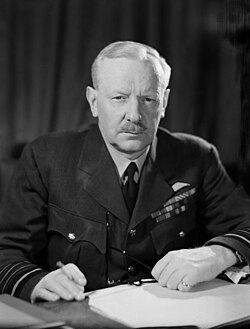
“”The Nazis entered this war under the rather childish delusion that they were going to bomb everybody else and nobody was going to bomb them. At Rotterdam, London, Warsaw, and half a hundred other places, they put that rather naive theory into operation. They sowed the wind and now they are going to reap the whirlwind.
|
| —Arthur "Bomber" Harris, RAF Bomber Command, June 1942.[345] |
In 1942, Sir Arthur "Bomber" Harris took control of the RAF Bomber Command, which had seen relatively limited success due to attempting "precision bombing" against German war infrastructure. Harris recognized that such a tactic was impossible and instead began "area bombing", the destruction of entire cities in order to shut down their factories.[346] In order to prove the efficacy of his new approach, Harris launched a massive attack by over 900 aircraft against the German rail hub and manufacturing city of Cologne.[347] The whole city was set aflame by incendiary bombs, and many thousands of German civilians perished. The raid was effective in cementing Harris' new vision for an air war. More German cities fell victim to bombing raids from both the US and the UK, now with the aim of killing and terrorizing industrial workers along with destroying assets. On 27 July, this strategy reached one of its apocalyptic peaks when British bombers induced a massive firestorm that gutted Hamburg, Germany's second-largest city, killing a number of people estimated to be up to 43,000.[348] Many who did not burn to death asphyxiated in underground bomb shelters.
Efficacy of strategic bombing was and is difficult to determine since no one can know what levels Germany's industrial output could have maintained in the absence of bombing. Allied attacks did cause great difficulties in transporting goods across Germany, and destruction of its fuel assets prevented fueling of aircraft and tanks in great enough quantities to efficiently continue air and ground warfare.[349]
By 1944, Allied bombing had increased even further in efficacy. The US notably had better long-distance fighters and could therefore reduce losses of its own bombers to German planes, and it had better bomb sights and other technologies for more precise targeting.[350] Bombers also prepared the path for D-Day by hitting coastal fortifications, destroying railways to block German reinforcements, and carpet-bombing German troops (which we're sure really sucked for the German troops).[346]

Cologne in ruins, but its iconic cathedral stands.
A US B-17 hits a German aircraft factory in Marienburg.
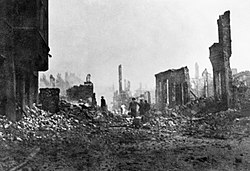
Dispossessed civilians in the ruins of Hamburg.
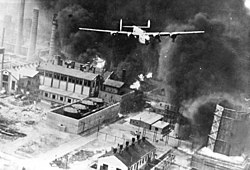
A US B-24 raid on a Romanian oil refinery.

Corpses in Dresden. Note the stroller.
Kursk: Germany is in deep shit now[edit]

“”Here they found real war, but they were not ready for it. They were used to easy victories. This deprived them of flexibility on the one hand, of tenacity on the other. For them, war was merely maneuvers.
|
| —Marshal Georgy Zhukov's assessment of the Wehrmacht.[351] |
In the wake of Stalingrad, the Red Army had pushed the Germans out of the gains they had made during Fall Blau during a huge but costly winter offensive. Unfortunately, the Germans weren't quite done yet. On 19 February 1943, the Germans rallied and counterattacked the Ukrainian city of Kharkhov, inflicting approximately 45,300 deaths on the Red Army and driving them back to the north.[352] By the time they were done, 70% of the city lay in ruins, with tens of thousands of its inhabitants killed.[353] The German thrust from Kharkhov, along with their units to the north, threatened the recently-retaken city of Kursk from two sides. The Germans, of course, decided to attack.

The German onslaught, codenamed Unternehmen Zitadelle (Operation Citadel), would threaten Kursk from two directions behind it, a simple pincer maneuver meant to encircle Soviet forces in the city. The Germans hoped this would be their great breakthrough that would put them back on the offensive. To that end, they began assembling their newest tanks, notably the famous Panthers and Tigers, in a massive buildup of force.[354] Too bad for the Germans, then, that the Soviets had almost exact knowledge of their plans. British intelligence decoded the German order of battle and sent it to the Soviets, giving them precise information on which divisions would be deployed in which areas.[355] Plus, the Red Army was very different from the unprepared force the Germans had attacked in 1941. They had learned some brutal lessons and been whipped into shape by people like Marshal Zhukov. This had been paid for with countless lives and miles of land, but the Red Army was now ready to fight the Germans and win.
Zhukov's men fortified the shit out of the Kursk salient, digging miles of anti-tank ditches, planting countless mines, and laying out barbed wire entanglements.[356] The Soviets also had thousands of tanks and more than 25,000 artillery pieces and armor-piercing guns. When the Germans attacked on 5 July, they realized very quickly that they had fucked up. What ensued was the largest tank battle in history, and the Soviet mines and cannons proved effective at trashing German tanks.[356] The Germans finally weakened, and the Soviets quickly exploited their victory to liberate much of Ukraine throughout the rest of 1943.[357] By 6 November, Kiev had been liberated after two years of Nazi terror.[358]
Soviet losses at Kursk amounted to 860,000 casualties and 1,500 tanks, while German losses were 200,000 casualties and lost 500 tanks.[354] On paper, this seems like a disaster for the Soviets, but they could replace those losses, and the Germans largely couldn't. Nazi Germany had just been fatally wounded.
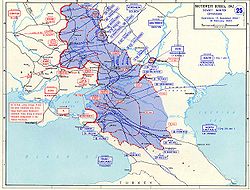
Elimination of the German southern gains, 13 December 1942 to 18 February 1943.
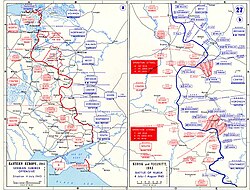
The Kursk salient threatened, 4 July to 1 August.

The Soviets exploit their victory at Kursk and retake much of Ukraine, 17 July to 1 December.
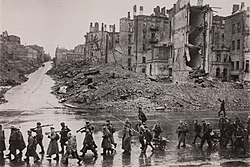
The Red Army marches through a liberated (and destroyed) Kiev.
Italy wants to get off Mr. Hitler's wild ride[edit]
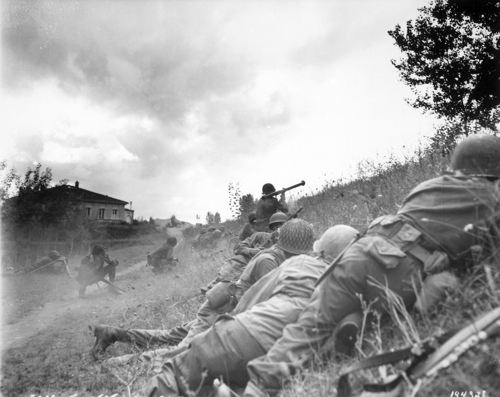
After consolidating North Africa, the Allies were free to begin the invasion of Italy. Such an undertaking had been repeatedly championed by Churchill, and he repeatedly referred to Italy as the "soft underbelly" of Axis Europe.[359] This was a quite understandable conclusion, as Italy's forces had performed less like a strong fasces and more a fistful of wet spaghetti. Plus, the Allies needed to get a foothold back in Europe to show progress in the war and take some pressure off the Soviets.
On 10 July, the Allies invaded Sicily with great success and relative ease due to duping the Axis into thinking the invasion would happen elsewhere.[360] Getting curb-stomped in Sicily led the Italian government and people into a belated realization that Mussolini had incompetently led them into a clusterfuck. On 24 July, the Grand Council of Fascism booted Mussolini out of office, and on 25 July the government had his stupid ass arrested.[361] Army Chief of Staff Pietro Bagdolio replaced him and began negotiating with the Allies.[362]

Germany figured out pretty quickly what was going on and set about occupying their former ally. Bagdolio had to flee to the south. Formerly friends of the Germans, the Italians became targets for German brutality. Their forces murdered any Italian civilians they perceived as standing in the way of their occupation, adding up to roughly 15,000 dead by the end of the war.[363] In one hideous massacre in Tuscany, SS troops forced women, children, and old men into barns and machine-gunned them, killing 560.[364]
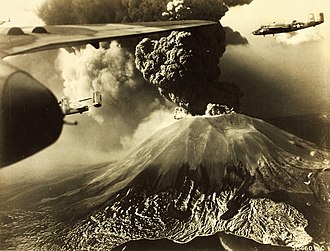
Fearing that the Italian army would switch sides, Germany ordered all Italian units stand down, disarm themselves, and await reorganization into a puppet army![]() . When many Italian soldiers resisted, the Germans resorted to murdering their old comrades en masse. The worst such atrocity was the massacre of the Acqui Division
. When many Italian soldiers resisted, the Germans resorted to murdering their old comrades en masse. The worst such atrocity was the massacre of the Acqui Division![]() , when the Italian garrison on the isle of Cephalonia
, when the Italian garrison on the isle of Cephalonia![]() resisted Germany's orders. The Italians held out doggedly for a week, but it was futile: they were outnumbered and had no hope of resupply or reinforcements, and surrendered when they ran out of ammunition. The "clean" Wehrmacht celebrated its victory by murdering 5,155 Italian prisoners, in one of the war's deadliest massacres of POWs since the Katyn Massacre
resisted Germany's orders. The Italians held out doggedly for a week, but it was futile: they were outnumbered and had no hope of resupply or reinforcements, and surrendered when they ran out of ammunition. The "clean" Wehrmacht celebrated its victory by murdering 5,155 Italian prisoners, in one of the war's deadliest massacres of POWs since the Katyn Massacre![]() .[note 5]
.[note 5]
As this was happening, the supposed Italian strongman Mussolini was freed in a (actually pretty badass) commando raid and put him in charge of a Nazi puppet government based out of northern Italy.[365] Mussolini thus stood by as Germans slaughtered his people. His response to the aforementioned massacre of POWs on Cephalonia? Blaming the Italian officers.[366] Some strong man. Some patriot. Some Italian.
To make matters worse, the Allies completely fucked up their invasion of Italy proper. On 8 September, Italy surrendered unconditionally to the Allies, and on 9 September the Allies moved in to occupy their defeated foe. Instead, they were faced with entrenched German troops who had already occupied Italy, and the initial landings in southern Italy became a bloody disaster.[367] Almost being pushed out completely, the Allies only rallied with heavy American artillery bombardments, air strikes, and covering fire from ships at sea.[367] Far from an easy occupation, the Allies were faced with a brutal slog through the Italian mountains against an enemy that knew they were coming.
Leapfrogging to Japan's doorstep[edit]
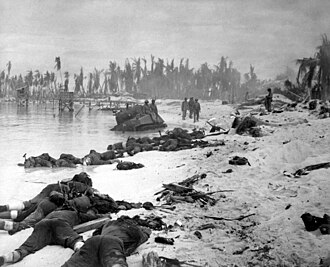
Rather than fight Japan's island garrisons head-on, Allied commanders in the Pacific decided to spare lives by bypassing many Japanese-held islands. Cut off by the Allied navies, Japanese troops on those islands would be effectively neutralized.[368] Unfortunately, not every island could be bypassed on the road to Japan, and that meant engaging in some battles that everyone knew would be deadly and miserable.
On 20 November 1943, US Marines got their first taste of how brutal amphibious landings would be when they invaded Tarawa in the Gilbert Islands (modern-day Kiribati). The Japanese had entrenched themselves and pounded US troops with artillery as they tried to come ashore in deep water.[369] After taking the island, the photos the Marines had taken were so gruesome that the US government didn't initially want to release them. The bloodbath at Tarawa was followed by more miserable battles in the Marshall Islands and then the Northern Mariana Islands and Guam.
While US forces struggled to unseat determined Japanese forces from their conquered islands, more developments made the picture even grimmer for Japan. US submarines, initially an overlooked asset, proved to be a deciding factor in the Pacific. They intercepted cargo ships carrying resources Japan desperately needed from its conquered territories, denying Japan its spoils of war and strangling its war machine. In total, US submarines destroyed 1,314 enemy ships in the Pacific, representing 55% of all Axis shipping lost and a total of 5.3 million tons of cargo.[370]
On 22 November, Roosevelt, Churchill, and Chiang met in Cairo to determine the future of the Pacific. They resolved that Taiwan and all other lands taken from China would be returned and that Korea would become a free nation.[371] All of Japan's Pacific islands would be taken from them.
Allied liberation of France[edit]
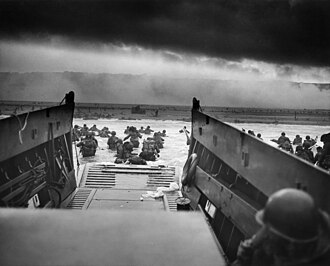
On 6 June 1944, the Western Allies invaded Normandy, the northern coast of France. This had long been the objective of Allied planning against Nazi Germany. On 19 August 1942, more than a year before, a mishandled cross-Channel attack on the occupied French city of Dieppe was a serious failure due to the lack of Allied air superiority to support the landings.[372] Allied plans for an invasion of France in 1942 had to be shelved.
Luckily, things were different in 1944. The war going sour for Germany against the Soviet Union meant that most of its air forces were deployed on the other side of the continent.[373] The Wehrmacht also had most of its battle-hardened divisions in the east as well, meaning that the Allies had a much greater chance of success. British intelligence had also successfully mislead Germany into believing that the attack on Normandy would be a feint.[374]
.jpg)
US forces attacked through a narrow window of semi-decent weather, facing German troops who had dug into the cliffsides. The fiercest fighting took place at Omaha Beach, which had been assigned to the US, but by nightfall the Allies managed to bring 175,000 troops into France.[375] In response to this unexpected threat, Hitler redeployed 168 divisions to France, taking a great deal of pressure off the Soviet Union.[373] During the invasions, British and Canadian forces suffered around 3,700 casualties, and US forces suffered about 6,600 casualties.[376] German forces lost up to 9,000 men.
After D-Day, the summer of 1944 proved to be a nerve-wracking time for the Allies, as the Germans held them in Normandy and the onset of winter would make any advances substantially more difficult.[377] The breakthrough came when Hitler decided on a counterattack, which his exhausted redeployed divisions could not successfully execute. This further burned out his divisions and allowed an Allied breakthrough on 8 August. Further complicating things, the Allied invasion of southern France on 18 August was conducted against Churchill's objections (he wanted to invade the Balkans instead).[378] Paris was only liberated on 25 August as French Resistance forces operating in the city rose up to free themselves, albeit thanks to De Gaulle's insistence that it would be a French liberation rather than an Allied one.[379] The German position in France quickly became untenable.
France's liberation had a dark side, as the civilian populace took revenge against anyone perceived to have collaborated with or given comfort to the Nazi occupiers. About 20,000 women were branded and forcibly shaved as public humiliation for allegedly sleeping with Germans,[380] but this practice itself was possibly inspired by the fact that the Nazis did the same thing to Aryan women who allegedly slept with non-Aryans.[381]
Suplex on the Eastern Front[edit]

From December 1943 until April of the next year, the Soviets fought tooth and nail to take back as much of Ukraine as they could, suffering an estimated 1.19 million casualties in the effort.[382] On 27 January, the Soviets had even liberated the northern city of Leningrad from its brutal siege.[383] The Germans were still reeling from losing much of their armored force at Kursk. Things got even better for the Red Army when D-Day forced Hitler to dispatch Germany's strategic reserve to meet the Allies in France.[373] This gave the Soviets a lot of breathing room. Enough, in fact, to allow for the preparation and execution of another huge offensive that would break Germany's back in the East.
On 22 June, the 3-year anniversary of Operation Barbarossa, the USSR launched Operation Bagration. This was to be a massive offensive against German forces occupying Belarus, but Soviet intelligence made it appear as if their efforts would instead be focused further south. Red Army forces in Belarus were reinforced and supplied under cover of night, and by day the trucks turned around and made a big show of leaving.[384] The Germans were completely surprised when the Soviets launched their attack.
Despite not appearing to be a logical place for attack, Belarus was a major weak point in the German lines. The region had seen some of the most deadly German repression, and partisan numbers had swelled up to 374,000 to fight against the hated occupier.[385] These partisans received directions from Moscow and were ready to sabotage German lines ahead of the Soviet attack. On top of that, German forces there were weak. Many were Luftwaffe airmen baffled to have been drafted to fight on the ground, demoralized Hungarian and Slovak divisions, or random ethnic Germans drafted from occupied territories who weren't well trained or well motivated.[385]
Operation Bagration dwarfed the D-Day landings, as the Soviets used 2.5 million soldiers to demolish three Axis armies and force the Germans into full retreat. By the time the Soviets liberated Minsk, the Germans had lost over 100,000 troops in just a week of fighting.[384] The Soviets had actually overestimated Germany's strength while Germany had done the opposite, and Russia thus inflicted the worst German military disaster of the entire war by causing almost half-a-million casualties among Germany's already failing Wehrmacht.[386] These victories forced Germany almost entirely out of the Soviet Union and brought the Red Army to the gates of the Axis homelands.
Overseeing this great Soviet victory was Marshal Konstantin Rokossovsky, an ethnic Pole who had spent several months in a gulag under a death sentence after being accused of spying for Poland.[387] After being released to serve as a general, Rokossovsky proved his loyalty by winning perhaps the greatest Allied victory of the war. Stalin thanked him for this by making it clear he still didn't trust Rokossovsky and minimized his victories by attributing them to Zhukov.[387]

The Ukraine-Leningrad offensive, 2 December 1943 to 30 April 1944.

Soviet soldiers celebrate after breaking the Siege of Leningrad.
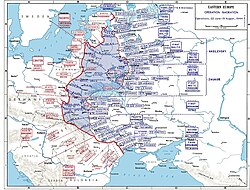
Operation Bagration, 22 June to 19 August.
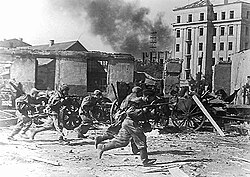
The Red Army storms Mogilev during Operation Bagration.
Entering the final act[edit]
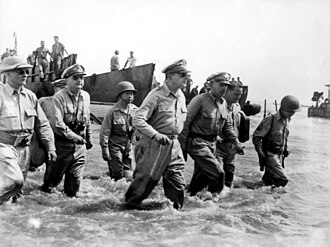
Titans clash at the Philippines[edit]
“”WHERE IS TASK FORCE THIRTY-FOUR THE WORLD WONDERS
|
| —Fleet Admiral Chester Nimitz's desperate encoded message to Admiral William Halsey Jr at Leyte Gulf.[388] |
As the US was poised to take the Mariana Islands, Japan's remaining naval forces mobilized desperately. The ensuing Battle of the Philippine Sea on 19 June was the largest carrier fight of the war, with Japan fielding the Shokaku, Zuikaku, and the newly-built Taiho against a staggering 7 US fleet carriers and a myriad of smaller light carriers.[389] The US Navy wasn't fucking around this time. The battle cost Japan two more of its carriers, with only the greatly damaged Zuikaku surviving. Worse than that, however, was the loss of three-quarters of Japan's naval air force, which Japan had neither the planes nor the pilots to replace.[390]
Having smashed the Japanese navy guarding the Philippines, the US allowed General MacArthur to have his great comeback on 20 October when he waded ashore onto the island of Leyte with the Philippine president and a camera crew to capture the moment.[391] Unfortunately, merely stepping onto the beach of the Philippines was not enough to count as a liberation. A tough-as-balls battle was ahead.
The Japanese Navy still had a powerful surface force and tried to use it again to halt the US invasion of the Philippines, beginning on October 23 the Battle of Leyte Gulf, the largest naval engagement of both the war and modern history.[392] Japan managed to partially level the playing field by baiting Admiral "Bull" Halsey's battleship-and-carrier Task Force 34 away from Nimitz's older force and the vulnerable landing ships using a force centered on their remaining carriers, nearly useless with next to no airmen, as decoys creating a desperate and costly fight for the Americans.[389] Japan ultimately lost the battle along with 26 warships, but they managed to inflict the loss of 7 ships on the Americans.[392]
In their desperation to halt the US advance at Leyte Gulf, Japan also unleashed her most terrifying weapon yet: the kamikaze. These were Japanese pilots who deliberately crashed their bomb-laden planes into American ships, and the Japanese command regarded this horrific tactic as the only way to turn the war back into their favor.[393] Kamikazes sank many US ships at Leyte Gulf and continued to do so throughout the war.
Japan's efforts managed to delay the US liberation of the Philippines until February 1945, and the fight for the city of Manila and its surroundings killed 230,000 Japanese and 10,380 Americans.[394] Pilots from the Mexican Air Force also played a major role against Japan during the liberation of the Philippines.[395]
Germany's allies jump ship[edit]

“”Today it is obvious to any sober-minded person that the German Reich has lost the war. All governments responsible for the destiny of their countries must draw the appropriate conclusions from this fact, for as a great German statesman, Bismarck, once said, 'No nation ought to sacrifice itself on the altar of an alliance.'
|
| —Miklós Horthy, October 1944.[176] |
With the Soviet Union smashing on the gates of Central Europe, it was obvious to basically anyone not in Hitler's inner circle that the war was totally fucked for the Axis. Even before this happened, Hungary had become the second major Axis partner to start looking for a way out. Hitler found out in March that Miklós Horthy wanted a negotiated peace with the Allies, and he ordered the German military to again invade a former ally on 19 March.[396] Hungary became a German puppet state, and Adolf Eichmann arrived to begin mass deporting 10,000 Hungarian Jews per day to Auschwitz.[396] During the deportations, Hungarian Jews were abruptly forced into ghettos, often made to live outside with no shelter or sanitation.[397]
On 20 August, as Bagration wound down, the Soviets launched the 2nd Jassey-Kishiniev offensive. Replicating their success at Stalingrad, the Soviets smashed through weak German flanks to encircle and destroy the reconstituted 6th Army for a second time, blasting yet another hole in the Axis lines.[398] With the country now wide open to Soviet invasion, the Romanian monarch, King Michael I, staged an abrupt coup and arrested military dictator Ion Antonescu, effectively restoring Romania's absolute monarchy.[399] The Allies, including Stalin, recognized the new change in government and agreed to a cease-fire, and the Red Army moved into the now non-resisting Romania to oust what remained of German presence. Axis front lines in the Balkans and Greece collapsed as a result of this. In exchange for its change of heart, Romania had to endure a Soviet military occupation, surrender food and oil supplies to the Soviet Union, recognize Soviet control of Moldova, and place 15 divisions under the control of the Red Army.[400]
Last came Finland, which had discovered to its woe that attacking the Red Army was much harder than defending against it. After this realization, the Finnish front had been quiet for some time until the Soviets brutally attacked on 9 June 1944. The Soviet onslaught was far different from their efforts in the Winter War; they were now well used to fighting in the snow and cracking open fortifications.[401] Finland had no choice but to make peace on 15 September, recognizing its lost territory and agreeing to further harsh terms. This wasn't the end of things, though, as the Germans were again not too keen on leaving their old ally's land. So the Finns had to make them leave, beginning the Lapland War. The furious Germans used scorched-earth tactics on Finnish soil, razing multiple cities, destroying everything but Lutheran churches, and tearing up roads and railroads behind them to make the Finnish pursuit more difficult.[402] It was one last "fuck you" from Germany in a long list of them aimed at former friends.
Knock, knock, it's the Red Army[edit]
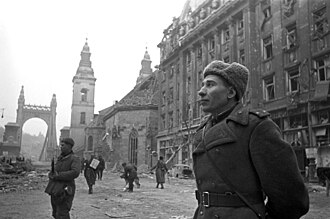
Realizing that the Nazis were at death's door, the Polish resistance rose up against the German occupiers in Warsaw on 1 September in the hopes of freeing the city ahead of the Soviet advance. For several months, Polish fighters battled against long odds and a desperate shortage of weapons and food.[403] The Red Army were rapidly closing in, so for these several months, where the fuck were they?

Once again, Poland had been backstabbed by the Soviet Union. Stalin had banded the resistance forces "a handful of criminals" and established his own puppet government to rule Poland; he ordered the Red Army to wait beyond the city to ensure that the Poles were crushed.[404] After all, if the Poles could resist the Nazis, then they could resist him. The Germans, meanwhile, were both enraged and delighted by this turn of events. Enraged by the defiance and delighted at the excuse to completely level Warsaw. Heinrich Himmler ordered that Warsaw would be erased, with all of its inhabitants murdered and every building to be blown up.[403] German forces shot anyone they saw, making no distinctions between combatants or women and children. The uprising ultimately failed, and German forces began to level Warsaw, having slaughtered over 200,000 of its citizens while the Red Army stood by.[403] When the Red Army finally entered Warsaw, they did so as an occupying force ruling over a pile of rubble. Warsaw's pre-war population of 1.3 million had dropped to just 153,000.[405]

As 1944 came to a close, the Soviet Union occupied Germany's former allies in the east. Romania had already liberated itself from the Axis but had found itself in the grip of Soviet occupation. Bulgaria, which had never joined the Axis effort on the Eastern Front, was still invaded and occupied by 9 September after the Soviets declared war on them.[181] On Christmas, the Red Army laid siege to Budapest, the capital of Hungary, which was home to the Axis' last crude oil plant and was on the path to Vienna.[406] After a brutal battle and the failure of the Germans to relieve the city, Budapest surrendered on 13 February 1945.
In January 1945, the Red Army finally liberated Auschwitz, putting to an end one of the deadliest centers of the Holocaust. Ahead of the Red Army's advance, the Germans had "evacuated" 56,000 prisoners by marching them into the winter with no food, killing around 15,000.[407] The remaining SS forces in the camp attempted to destroy its documents before being overtaken by the Soviets. Soviet soldiers were reportedly first confused and then horrified by what they found. After the liberation, the battle-hardened Red Army general Vasily Petrenko remarked,[408]
“”I who saw people dying every day was shocked by the Nazis' indescribable hatred toward the inmates who had turned into living skeletons. I read about the Nazis' treatment of Jews in various leaflets, but there was nothing about the Nazis' treatment of women, children, and old men. It was in Auschwitz that I found out about the fate of the Jews.
|
Hitler still thinks he can turn this thing around (he can't)[edit]
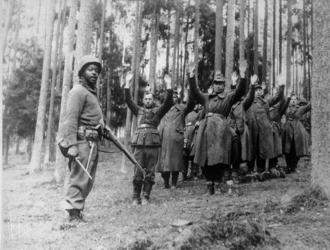
“”To the German Commander. NUTS!
|
| —Brig. General Anthony McAuliffe, 101st Airborne, in response to a demand for their surrender.[409] |
In the hopes of speeding up the end of the war, in September 1944 the Allies attempted a bold plan called "Operation Market Garden" where thousands of American, British, and Polish paratroopers would parachute behind the lines into the Netherlands to capture a series of bridges so that a large army of British tanks could use them to drive straight into the gooey caramel center of Germany. The plan failed mainly because the German defenses were much tougher than expected. Thus the British tanks were forced to move slower than planned and didn't quite get across all of the bridges ("a bridge too far"![]() ); the paratroopers, especially the British ones at Arnhem
); the paratroopers, especially the British ones at Arnhem![]() , suffered heavy casualties.[410][411] Consequently, much of the Netherlands would remain under German occupation until May 1945 (three days before Germany finally surrendered).[412]
, suffered heavy casualties.[410][411] Consequently, much of the Netherlands would remain under German occupation until May 1945 (three days before Germany finally surrendered).[412]

Denied a quick route to victory, the Allies opted to just kick in the door. The Germans, though, were still a deadly foe, and offensives against German cities like Aachen in October lasted for weeks and came with a heavy toll in lives.[413] Germany's western borders were defended by the Siegfried Line, a deep set of fortifications originally built in the event the war against France had gone sideways. It had been abandoned after the fall of France, but the Germans hastily reactivated the line when the Allies came knocking.[414] In all, it would cost the Allies some 250,000 casualties and helped prolong the war.
Then, on 16 December, Hitler ordered his last attempt to salvage the Western Front. This was to be an unimaginative repeat of the Ardennes offensive which had wiped out Belgium and France, and German commandos aided the effort by dressing in American uniforms and causing confusion.[415] The Germans managed to take the Americans by surprise and break through their lines, leading to a desperate "Battle of the Bulge". On the day of the breakthrough, SS troops captured and massacred more than 80 US and Belgian soldiers, reportedly laughing as they did so.[416] The US 101st Airborne Division spent Christmas 1944 fighting for their lives in a desperate siege of the Belgian city of Bastogne.[409] Within days, Patton's tanks were able to relieve them, and throughout January, American troops reduced the German salient.[417] Hitler had used up his last great effort, and the Germans had suffered many more casualties than the Allies at 120,000 versus 85,000.[413]
Having learned harsh lessons, the US Army by 1945 was as seasoned and professional any in Europe, and it could call upon seemingly endless artillery firepower and air support to halt German attacks and break through their lines. These advantages came to bear on 7 March 1945, when the US crossed the Rhine and entered the German industrial heartland.[418] Rather than fight the Germans head-on in their homeland, Eisenhower opted to encircle them, trapping an entire Army Group and 26 generals.[418] Also trapped was Field Marshal Walter Model, arguably Germany's most formidable. When, on 16 April, the pocket was crushed, the Germans lost the 350,000 troops who were trapped inside along with much of Germany's industry and population.[419] This was an even greater catastrophe for Nazi Germany than Stalingrad and Kursk had been.
Settling accounts[edit]
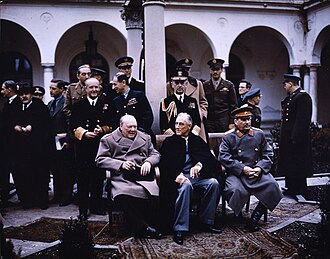
The Yalta Conference (the Cold War begins)[edit]
On 4 February 1945, Churchill, Stalin, and Roosevelt met at the Crimean city of Yalta (still devastated by Nazi occupation) to determine the fate of postwar Europe. Stalin deliberately chose Yalta to host the summit, believing correctly that viewing the destroyed city would impress the democratic leaders with the extent of the Soviet Union's sacrifice and thus give Stalin a psychological advantage in the negotiations.[420] And there would be negotiations, as the Allied leaders had different goals. Churchill wanted to ensure democratic elections in the liberated nations of Europe while Stalin wanted to create a buffer zone of Soviet-controlled puppet states to shield them from any Western invasion.[421] Roosevelt, for his part, was most interested in convincing Stalin to join the war against Japan.[422]
In the end, both sides had to lose some to get some. Stalin demanded, and got, the primary say on what happened in Eastern Europe, even in Poland on whose behalf the UK had gone to war.[420] No other agreement was realistic with Red Army troops already occupying nations. While Stalin promised to hold free elections in his occupied regions, he simply reneged on that agreement later.[423] On the other hand, Stalin lost out on his demand to make Germany pay ruinous reparations and he had to recognize France as a major shots-caller for the postwar world.[420] Perhaps most importantly, he consented to join and back the United Nations after the war and allowed the US to decide its basic structure.[420] The Soviet Union also agreed to declare war on Japan in exchange for a free hand in dealing with northern China.[424]
After the Yalta Conference concluded, Europe's fate was sealed. The Soviet Union would rule over what would become the Eastern Bloc with little Western interference, and China would become a new front in the struggle between capitalism and communism. In outlining the end of the world war, the three leaders had set the stage for the Cold War.
Victory over Germany[edit]

Even with the war decided, and the Soviet Union smashing on the gates of Berlin, Hitler and his government refused to give up. Hitler personally ordered that Germany's infrastructure be destroyed ahead of advancing armies, inflicting yet more cruelties on the German population.[425] The Nazi Party then mobilized nearly six million German men between 16 and 60 and armed them with obsolete and mothballed weapons, forming the so-called "Volkssturm" militia in accordance with Joseph Goebbels' delusional conviction that ideological fanaticism would win the day against the Red Army.[426] In desperation to halt the Soviets, the German government even started conscripting child soldiers to defend itself, largely drawn from the ranks of the Hitler Youth. Those young boys were not spared from summary execution as punishment for desertion or disobedience.[427] Hitler fled into his Führerbunker under Berlin in January, and one of his last acts was to pin medals on the Hitler Youth members defending him, some of whom were as young as 11 years old.[427] The coward spent his final days hiding behind children.
Due to the gains made in 1944, the Soviets had the honor of taking Berlin, although they were supported by aircraft from the Western Allies before being handed off to the Soviets.[428] The Soviets bombarded and ground through German defenses at the Seelow Heights, losing 30,000 men during one of the last pitched battles of the war.[429] On 30 April, the Soviets took the Königsplatz, the city square right in front of the Reichstag and then fought the Germans inside the building itself.[430]
When it became obvious that Berlin would fall (and facing a barrage of Internet memes[431]), Hitler committed suicide in a secure bunker rather than own up to his defeat, and his body was burned in a bomb crater outside the bunker. In the chaos of battle, his remains were never positively identified until 2017.[432] German resistance ended shortly after the death was announced.
Hitler, the great and infallible Führer of the Thousand-Year Reich twelve years in, went out like a little bitch.
Germany officially surrendered to the Allies on 7 May, with General Alfred Jodl signing the agreement in Reims, France.[433] And yet, even this was an event that foreshadowed the oncoming Cold War. You see, Stalin believed that the Soviet Union should be the party accepting the surrender, and that it should do so in Berlin, the capital of the Nazi empire.[434] More compellingly, the Soviets also argued that Jodl was too junior an officer to surrender all of Germany. Everyone remembered how making civilians and lower officers responsible for surrendering the German Empire in World War One helped pave the way for the stab-in-the-back legend perpetuated by the German military.[434] Doing it right meant doing it in Berlin with the highest-ranking German officer possible. Thus, the final German surrender was signed by Field Marshal Wilhelm Keitel, the supreme commander of the Wehrmacht, in Berlin with Soviet Marshal Georgy Zhukov calling the shots.[434]
Yes, the invincible Thousand-Year Reich with its Master Race and superior engineering surrendered not once but twice. Take that!
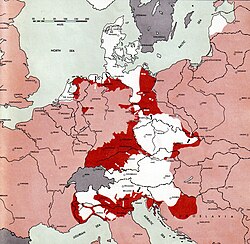
Allied advances in Germany's final days.

The cowardly Hitler greets the children shielding his bunker. This is one of the last photos of him.

The Red flag rises over the Reichstag.

Field Marshal Wilhelm Keitel signs Germany's unconditional surrender in Berlin, 8 May.
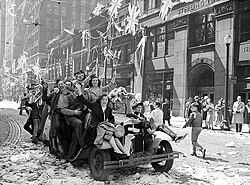
Victory celebrations in Toronto, Canada.
Japan under siege[edit]
.jpg)
“”Were it not for the Navajos, the Marines would never have taken Iwo Jima.
|
| —Maj. Howard Connor, signals officer at Iwo Jima.[435] |
The final stages of the war against Japan were the most nightmarish for all parties. On 19 February, US Marines invaded the island of Iwo Jima, home to a Japanese air base that was crucial for conducting bombing raids against Japanese cities.[436] Instead of stopping the landings, the Japanese forces focused on exacting a terrible toll on the Americans. They dug into caves and bunkers and fought for more than five weeks, and just one stronghold killed almost 850 Marines in one battle called the "Meat Grinder".[437]
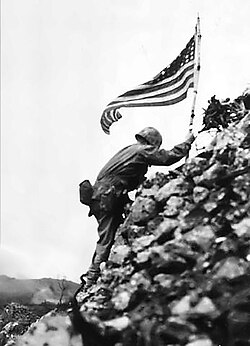
Essential to these victories were the Navajo Code Talkers, who developed an unbreakable method for encrypting messages based on their indigenous language. Since the Japanese were so good at decryption, the Navajos couldn't even write down their code; they had to do it all in their heads.[437]
Taking Iwo Jima cleared the way for heavy bombers to hit Japan without interference, and the Air Corps soon made use of that. Strategic targets were steel plans, airplane factories, electronics factories, and shipyards.[438] Still lacking precision bombing techniques, the Air Corps again decided on the ruthless method of simply bombing entire cities to destroy the factories and kill the people who worked in them. The worst event was at Tokyo, which had all of the strategic targets. US bombers carried napalm incendiaries since Japanese cities were predominantly wooden structures, and they had been stripped of defensive turrets to make way for more bombs.[437] The firebombing burned much of Tokyo to the ground, burning some 100,000 people to death and reportedly filling even the planes with the rancid smell of smoke and burning flesh.[439] Jim Marich, one of the airmen, later said, "We hated what we were doing. But we thought we had to do it. We thought that raid might cause the Japanese to surrender."[440] Some airmen objected to the mission beforehand but were overridden by their superiors.[440] Airmen Jim Marich and Ed Lawson also reported being sickened by the smell of burning flesh that permeated their aircraft, and many questioned what they were doing and whether the justification was good enough.[440] The raids, horrible as they were, did successfully reduce Tokyo's industrial output of war materials, such as air craft plants by 75%, electronics plants by 70%, ordinance plants by 30%, and shipyards by 15%.[441]
On 1 April, US Marines stormed the island of Okinawa just south of Japan, which would serve as a base for the anticipated US invasion of the Home Islands.[437] US ships off the islands suffered the worst string of kamikaze strikes of the war, sinking 39 ships and killing 4,907 seamen.[442] Fighting on the island dragged on for three months, and the Japanese defenders retreated southwards into their fortifications.[443] In other words, every step the Japanese took was one step further from their homeland. The US suffered 12,500 men killed, the Japanese suffered 110,000 fatalities, and Okinawan civilians caught in the fighting may have resulted in 150,000 killed.[444] Among the dead was Lieutenant General Simon Bolivar Buckner Jr., killed on 18 June by a sniper during the final offensive, becoming the highest-ranked American officer to die in combat during the war.[437]
With Iwo Jima and Okinawa in American hands, the war had come to Japan's doorstep. US bombers dropped thousands of mines in the waters in the waters around Japan's ports starting in April, and this quickly cut Japan's imports of food, resources, and oil by 50% by May and then 90% by the end of the war.[445] This was devastating for the import-dependent Japanese Home Islands. From June, US bombers shifted their attention to smaller Japanese cities after leveling the major ones; the goal was to destroy Japan's internal transportation infrastructure.[446]
Perhaps one of the events most symbolic of imperial Japan's downfall was the sinking of the super-battleship Yamato on 6 April![]() ; the largest battleship ever built embarked on a desperate mission to Okinawa and fell victim to US carrier-borne torpedo bombers, ending with the consideration of the battleship as the master of the seas for good and giving such role to the aircraft carrier instead.[447]
; the largest battleship ever built embarked on a desperate mission to Okinawa and fell victim to US carrier-borne torpedo bombers, ending with the consideration of the battleship as the master of the seas for good and giving such role to the aircraft carrier instead.[447]
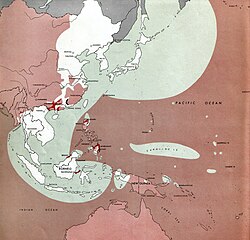
Japan's empire collapsed, 1 July 1945. Note how many islands were bypassed.
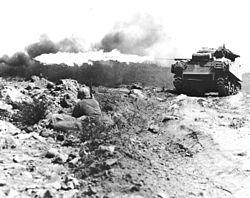
A US flamethrower tank at Iwo Jima.
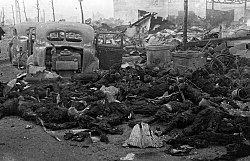
Charred corpses piled in Tokyo after the US bombing.
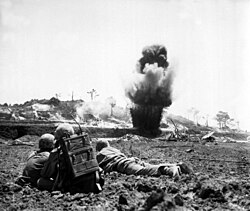
US Marines detonate charges over a Japanese-held cave at Okinawa.
_afire_after_being_hit_by_Kamikazes_off_Okinawa,_11_May_1945_(80-G-274266).jpg)
Fleet carrier USS Bunker Hill struck by kamikazes off Okinawa.
The Rising Sun finally sets[edit]
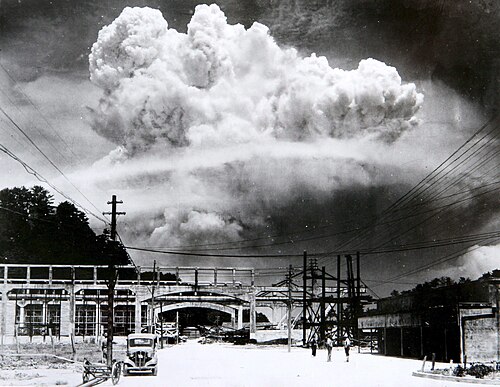
“”The war situation has developed not necessarily to Japan’s advantage...
|
| —Emperor Hirohito via radio broadcast, 15 August 1945.[448] |
Even cut off from what remained of its empire, Japan's military-controlled government refused to surrender. Japanese commander and soldier alike viewed the very concept of surrender as shameful. In 1941, Japanese leader Tōjō Hideki expressed this view by saying, "Do not live in shame as a prisoner. Die, and leave no ignominious crime behind you."[449] The Allies, on the other hand, demanded nothing less than Japan's unconditional surrender. Japanese diplomats offering to end the war on the condition that the Allies not occupy them or change their government only conjured up bad memories of German revanchism after the Treaty of Versailles.[450]
While publicly pledging to carry on the war until death, Japan's militarist government privately decided to make entreaties to the still-neutral Soviet Union in the hopes of having the communists mediate peace. To this end, former foreign minister Satō Naotake visited Moscow and pledged that Japan would surrender its conquests in exchange for peace.[451] The Soviets weren't terribly impressed by this offer, and a scathing Satō noted that this would always have been the case since Japan was only offering to give up what it had already lost. When the Japanese government failed to make any further indications of what peace terms it was willing to offer, Satō finally declared (from the safety of Moscow) that only Japan's unconditional surrender could reasonably end the war.[451] That went over with the Japanese militarists about as well as you think it did.
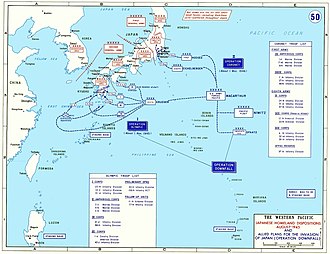
In the absence of negotiations, it seemed inevitable that matters would escalate to a full invasion of the Japanese islands. Japanese military planners (correctly) predicted that US forces would land at the southern island of Kyushu under air cover from American-held bases in Okinawa and Iwo Jima.[452] In response, the Japanese created Ketsu-Go, a plan which called for massive kamikaze attacks against the invasion force by an estimated 5,500 kamikaze planes, 1,300 suicide submarines, and several hundred piloted bombs.[452] By inflicting horrific losses, the Japanese hoped they could get the Americans to back down and accept a negotiated peace. The Japanese government also drafted civilians and armed them with makeshift weapons, making propaganda heroes of the terrified Okinawans who jumped from cliffs rather than give themselves up to the Americans.[452] With the brutal campaign for Okinawa fresh in Americans' minds, the US military reported to the new president Harry Truman (taking over for the now-deceased FDR) that Operation Downfall — the proposed invasion of Kyushu and then the greater Tokyo area — would inflict an estimated one million casualties on an already exhausted United States.[453] Truman, unsurprisingly, decided to explore other options.

Originally begun because Nazi Germany was believed to have started work on a nuclear bomb, the Manhattan Project succeeded in creating a usable fission-based nuclear weapon which was successfully tested in New Mexico on 16 July.[454] Truman consented to dropping one of these terrible bombs (named "Little Boy") on the industrial city of Hiroshima, on 6 August 1945, after warning the Japanese that refusing to surrender would have unprecedented consequences.[455] The single blast instantly killed about 66,000 people, and thousands more gradually sickened and died from what we now understand to be radiation sickness.[456] This made World War II the world's first (and so far, only) nuclear war.[457]
When Japan still didn't surrender (believing the US could only possess one bomb[450]), Truman ordered the drop of a second nuclear weapon on 9 August, an implosion-type plutonium fission bomb named "Fat Man", on Nagasaki, killing another 39,000.[456] The same day, the Soviets launched a massive invasion of Manchuria, quickly defeating the Japanese occupation force.[458] The sudden Soviet invasion (which meant no neutral mediator) and the obliteration of two large cities were a profound shock to the Japanese, especially Emperor Hirohito. The emperor made a rare personal intervention in his government, demanding that the Japan must unconditionally surrender.[450] The emperor cited three reasons behind his decision: his lack of faith in Ketsu-Go, the devastation of conventional and nuclear bombings, and his fear of a public revolt should the war not end.[459] The second nuclear bomb hitting Nagasaki so soon after Hiroshima had also evaporated Japanese doubt that the US could make more such weapons.
The next day, Japan's government informed the Allies that they were willing to surrender, only asking to be allowed to keep the emperor as a figurehead in the style of the powerless British monarchy.[460] On 15 August, Emperor Hirohito made an unprecedented radio broadcast to the Japanese people announcing that Japan would accept Allied declarations on the basis that continued struggle would result in the " collapse and obliteration of the Japanese nation".[448] The Japanese leadership came aboard the battleship USS Missouri and signed a declaration of unconditional surrender on 2 September 1945, formally ending the war.[461] The most horrible war in human history was finally over.
.jpg)
Hiroshima obliterated.
.jpg)
Soviet marines hoist their flag over Port Arthur, China.

Foreign Minister Shigemitsu Mamoru signs the instrument of surrender aboard the USS Missouri.

Emperor Hirohito stands with General MacArthur.

V-J Day: "They threw anything and kissed anybody in Times Square."
Aftermath[edit]
.jpg)
Towards the end of WW2 Soviet troops took vast swathes of Eurasia, causing it to become a superpower, this was bad news for the US. Various plans for war like "Operation Unthinkable![]() " or Warplan Pincher
" or Warplan Pincher![]() - some of which incorporated the use of nuclear weapons - were put forward, but the ideas were rejected on grounds both practical (there weren’t enough nukes yet and the USSR was a behemoth in conventional land power compared to the Western Allies) and political (the Western public didn’t think of the Soviets as an enemy yet and were unlikely to sanction aggressive war).[462] But relations didn’t get better. Initial attempts were made to work together; however, mutual distrust and Soviet aggression led to a quick breakdown of this cooperation.[463] While the US gave and lent vast sums of money to Western Europe and parts of Asia via the Marshall Plan (thus rebuilding those areas),[464] the Soviets demanded great reparations from the areas that came under their control. In the end, the two systems were so incompatible that the Cold War became the new norm.[463] Both Germany and Korea were divided along the lines drawn by the occupying Allied and Soviet forces (and leading to the Korean War), and the world settled into a long era of deep hostility and mistrust.[465]
- some of which incorporated the use of nuclear weapons - were put forward, but the ideas were rejected on grounds both practical (there weren’t enough nukes yet and the USSR was a behemoth in conventional land power compared to the Western Allies) and political (the Western public didn’t think of the Soviets as an enemy yet and were unlikely to sanction aggressive war).[462] But relations didn’t get better. Initial attempts were made to work together; however, mutual distrust and Soviet aggression led to a quick breakdown of this cooperation.[463] While the US gave and lent vast sums of money to Western Europe and parts of Asia via the Marshall Plan (thus rebuilding those areas),[464] the Soviets demanded great reparations from the areas that came under their control. In the end, the two systems were so incompatible that the Cold War became the new norm.[463] Both Germany and Korea were divided along the lines drawn by the occupying Allied and Soviet forces (and leading to the Korean War), and the world settled into a long era of deep hostility and mistrust.[465]
Revision[edit]
Even before the war was over, people and governments were intentionally distorting events. This is not a great surprise; wartime propaganda was rather common. Afterwards, various factions have continued to rewrite the history of the war to their own ends, portraying themselves or a group they support as the "good guys." For example, Holocaust denial became popular in neo-Nazi circles,[466] as are distortions of the events in China and Korea that took place in postwar Japan.[467]
More insidious were the post war attempts to portray both the Nazis and Imperial Japanese regimes as some sort of external force, descending from the skies to commit atrocities, of which the German and Japanese people knew nothing, and if they did, they would have TOTALLY opposed. The reality is, millions of German and Japanese people not only wholeheartedly supported, but actively participated in these crimes, and the widespread indoctrination carried out by both governments (in addition to the colossal logistical challenges necessary to carry out these crimes) meant that very few would have been genuinely unaware.[468] Hitler started much later, but very clearly outlined his beliefs and ambitions in countless speeches, books and slogans. Mein Kampf was a blockbuster, selling so many copies Hitler had a considerable fortune before he even came to power.[469] The Nazi party commanded considerable legitimate support in Germany, receiving tens of millions of votes in the elections before their ascension to power, and being either the first or second largest political party from 1930 onward.[470] For the Japanese, the ideas of Yamato-damashii, a racist and reactionary ideology not all that different from that of the Nazis, had been official government policy since the Meiji restoration of the late 1860s, and existed for almost a millennia before that. It had been taught to every child, in every school, for almost an entire century before the war even began.
Furthermore, it is impossible to make a clear differentiation between these regimes and "the people", as, after all, who was it in the government? Who was it shooting Jews and beheading Chinese civilians? It was, ultimately, the people of these nations. The lesson to learn is not that it was a few bad apples, but rather that given the right circumstances, average people can be enticed to commit truly monstrous crimes. These were not space aliens. There were no mind control rays. They were not ignorant of what was going on. These were normal people who were convinced to go along with, and actually physically commit the worst atrocities of our time.
See also[edit]
- Dwight D. Eisenhower
- Japanese American internment
- Nuremberg Trials
- World War I
- Korean War
- World War III
External links[edit]
- The Real War 1939-1945: A stark, unromantic description
- WWII played out in real time.
- The Fallen
- Praise the Lord and Pass the Ammunition!
Notes[edit]
- ↑ The America First Committee did attract some leftists with its anti-war message but was largely run by fascist-friendly conservatives, including noted antisemite Charles Lindbergh.
- ↑ Military planners in Japan quietly took note of this success...
- ↑ German scientists and engineers had been helping Iran develop its oil industry.
- ↑ No, get your mind out of the gutter.
- ↑ This crime was committed entirely by Wehrmacht soldiers, following the Wehrmacht's orders, with zero encouragement from the SS.
References[edit]
- ↑ Ernie Pyle quote. Your Dictionary.
- ↑ Ghuhl, Wernar (2007) Imperial Japan's World War Two Transaction Publishers pg 7
- ↑ Spencer C. Tucker (23 December 2009). A Global Chronology of Conflict: From the Ancient World to the Modern Middle East. ABC-CLIO. p. 1850. ISBN 978-1-85109-672-5
- ↑ Cheng, Chu-chueh (2010) The Margin Without Centre: Kazuo Ishiguro Peter Lang Page 116
- ↑ Stein, R. Conrad (1994) World War II in the Pacific: "Remember Pearl Harbor" Enslow Publishers Page 117
- ↑ Rollins, Peter (2008) Why We Fought: America's Wars in Film and History University Press of Kentucky Page 246
- ↑ Prelude to War (1942) US Government
- ↑ Olson, James Stuart (2001) Historical Dictionary of the Great Depression, 1929-1940 Greenwood Publishing Group pg 160
- ↑ Research Starters: Worldwide Deaths in World War II. The National WWII Museum.
- ↑ Bob Altemeyer. Wikiquote.
- ↑ Italian delegates return to Paris peace conference History Channel
- ↑ The Rise of Italian Fascism Dowell, Austin. Washington State University. SEP.01.15
- ↑ The Economy in Fascist Italy C N Trueman "The Economy In Fascist Italy" historylearningsite.co.uk. The History Learning Site, 25 May 2015
- ↑ Benito Mussolini (1883-1945) "Historic Figures", BBC
- ↑ The March on Rome C N Trueman "The March On Rome" historylearningsite.co.uk. The History Learning Site, 25 May 2015. 16 Jun 2018
- ↑ Fascism Was Not Left Or Right Pseudoerasmus 2015-05-03
- ↑ Mussolini, Doctrine of Fascism (1932) (Excerpt)
- ↑ Why Are People Talking About The Failed Nazi Coup of 1923?, HeyAlma, January 11, 2021
- ↑ Washington Naval Arms Limitation Treaty (1922). Encyclopedia.com
- ↑ 20.0 20.1 The Washington Naval Treaty. Naval History and Heritage Command.
- ↑ Naval Treaties. Michael Krepon. Arms Control Wonk.
- ↑ Evans, David & Peattie, Mark (1997), Kaigun: Strategy, Tactics and Technology in the Imperial Japanese Navy, 1887–1941, Annapolis: Naval Institute Press, ISBN 978-0-87021-192-8 p. 193–196.
- ↑ The London Naval Conference, 1930. US State Department Office of the Historian.
- ↑ Terror in Japan: The October Plot, Blood Brotherhood, & May 15 Incident – Japanese History. Matthew Legare Blog.
- ↑ The March Incident of 1931 – Japanese History. Matthew Legare Blog.
- ↑ A 1936 Coup Attempt in Japan Holds Lessons for the US. The Diplomat.
- ↑ Bearing Witness: The granddaughter of survivors of the Japanese massacre of Chinese in Nanjing chronicles the horrors. New York Times.
- ↑ 28.0 28.1 28.2 What Sparked Japan’s Aggression During World War II?. Slate.
- ↑ Russian-Japanese-War. International Encyclopedia of the First World War.
- ↑ “The Shanghai Baby” – The True Story Behind One of History’s Most Heartbreaking Photos. Military History Now.
- ↑ The Mukden Incident of 1931 and the Stimson Doctrine. US State Department Office of the Historian.
- ↑ Japanese mass violence and its victims in the “Fifteen Years’ War” (1931-45).
- ↑ Unit 731: Imperial Japan’s Biological and Chemical Warfare. UC Santa Cruz, Dangerous World.
- ↑ Marco Polo Bridge Incident. Britannica.
- ↑ THE SECOND UNITED FRONT, Alpha History
- ↑ The Second Sino-Japanese War. Alpha History.
- ↑ Nanjing Massacre, New World Encyclopedia
- ↑ Japan complains after China says 300,000 died in Nanking Massacre, Japan Times, January 14, 2015
- ↑ Haile Selassie. Wikiquote.
- ↑ 124 years ago, Ethiopian men and women defeated the Italian army in the Battle of Adwa, Quartz, March 2, 2020
- ↑ Italo-Ethiopian War. Britannica.
- ↑ 1935 SANCTIONS AGAINST ITALY: WOULD COAL AND CRUDE OIL HAVE MADE A DIFFERENCE? Ristuccia, Cristiano. Linacre College, Oxford.
- ↑ Third period (1931–36). Britannica.
- ↑ How the ICRC witnessed atrocities during Italy’s Abyssinia campaign and became embroiled in diplomatic controversy International Committee of the Red Cross
- ↑ John Whittam. Fascist Italy. Manchester, England; New York City, USA: Manchester University Press. p. 165.
- ↑ Spain’s “Semi-Fascism”. Slate.
- ↑ Neulen, Hans Werner (2000). In the skies of Europe – Air Forces allied to the Luftwaffe 1939–1945. Ramsbury, Marlborough, UK: The Crowood Press. ISBN 1-86126-799-1. p. 25.
- ↑ Zara Steiner, The Triumph of the Dark: European International History 1933–1939. (2013) pp 181–251
- ↑ Stalin and the Spanish Civil War, Kowalzy
- ↑ Spanish Civil War. Britannica.
- ↑ Payne, Stanley G. (2008). Franco and Hitler: Spain, Germany, and World War II. New Haven, CT: Yale University Press. ISBN 978-0-300-12282-4. p. 146.
- ↑ Debate on the Address. HC Deb 12 November 1936 vol 317 cc1081-155.
- ↑ Weinberg, Gerhard (1970). The Foreign Policy of Hitler's Germany Diplomatic Revolution in Europe 1933–1936. Chicago, Illinois: University of Chicago Press. ISBN 978-0-226-88509-4. p. 26-27
- ↑ 54.0 54.1 Lebensraum. US Holocaust Memorial Museum.
- ↑ Lebensraum. ThoughtCo.
- ↑ See the Wikipedia article on Generalplan Ost.
- ↑ Mackay, Ron (2003). Heinkel He 111. Crowood Aviation Series. Ramsbury, Wiltshire, UK: Crowood. ISBN 186126576X. p. 7
- ↑ Germany and rearmament. History Learning Site.
- ↑ Anglo-German Naval Agreement. Britannica.
- ↑ Remilitarization of the Rhineland. United States Holocaust Memorial Museum.
- ↑ Hermann Goering and the Four Year Plans. Weimar and Nazi Germany.
- ↑ Neumann, Klaus (2000). Shifting memories: the Nazi past in the new Germany. University of Michigan Press. ISBN 0-472-08710-X. p. 20-21
- ↑ Nazi Conspiracy and Aggression Volume 2 Chapter XVI Part 12, Yale Law School
- ↑ Shirer, William L. (1960). The Rise and Fall of the Third Reich. New York: Simon & Schuster. ISBN 978-0-671-62420-0. p. 259–260
- ↑ Carr, William (1972). Arms, Autarky and Aggression. London: Edward Arnold. ISBN 978-0-7131-5668-3. p. 23
- ↑ Shirer, William L. (1960). The Rise and Fall of the Third Reich. New York: Simon & Schuster. ISBN 978-0-671-62420-0. p. 262
- ↑ Austria struggles to come to grips with Nazi past. ABC Net.
- ↑ Anschluss. US Holocaust Memorial Museum.
- ↑ Anschluss. Britannica.
- ↑ Cesarani, David (2016). Final Solution: The Fate of the Jews 1933–1949. New York: St. Martin's Press. ISBN 978-1-250-00083-5. p. 147–150
- ↑ Disaster of the First Magnitude, 1938. America's National Churchill Museum.
- ↑ Occupation of the Sudetenland. The Holocaust Explained.
- ↑ Munich Agreement. Britannica.
- ↑ The Munich Conference. History Today.
- ↑ How Britain Hoped To Avoid War With Germany In The 1930s, IWM
- ↑ Final Steps to War: Invasion of Czechoslovakia. BBC.
- ↑ Lithuania. United States Holocaust Memorial Museum.
- ↑ What’s the context? 31 March 1939: the British guarantee to Poland. History of government.
- ↑ The girl who witnessed Kristallnacht. BBC News.
- ↑ Schluenes, Karl (1970). The Twisted Road to Auschwitz. pp. 120. ISBN 978-0252000928.
- ↑ Longerich (2012). Heinrich Himmler. Oxford: Oxford University Press. ISBN 978-0-19-959232-6. p. 155
- ↑ 82.0 82.1 Kristallnacht. United States Holocaust Memorial Museum.
- ↑ Heydrich's Instructions, November 1938 Riots of Kristallnacht.
- ↑ Secret photos of Kristallnacht show Nazi officers’ role in night of terror by Leo Sands (November 10, 2022 at 11:11 a.m. EST) The Washington Post.
- ↑ 85.0 85.1 The Forgotten Soviet-Japanese War of 1939. The Diplomat.
- ↑ The Almost War of 1938-1939: Russia and Japan's Nearly Forgotten Battle. National Interest.
- ↑ Nomonhan: Japan Against Russia, 1939, Volumes 1-2, Stanford University Press, 1990
- ↑ See the Wikipedia article on Nanshin-ron.
- ↑ Soviet-Japanese Neutrality Pact. World War II Database.
- ↑ Modern History Sourcebook: The Molotov-Ribbentrop Pact, 1939. Fordham University.
- ↑ Soviet-German Trade Agreement Of 1939. Encyclopedia.com
- ↑ Ericson, Edward E. (1999-11-30). Feeding the German Eagle. Westport, Conn: Praeger. ISBN 978-0-275-96337-8. p. 1–2
- ↑ The Chargé in the Soviet Union (Thurston) to the Secretary of State. US Department of State Office of the Historian.
- ↑ Radio Address by Neville Chamberlain, Prime Minister, September 3, 1939. Avalon Project. Yale Law School.
- ↑ Adolf Hitler: The Obersalzberg Speech. Fordham University.
- ↑ 96.0 96.1 The Gleiwitz incident: the ‘first man to die’ in the War. World War Two Today.
- ↑ Invasion Of Poland, Fall 1939. US Holocaust Memorial Museum.
- ↑ Blitzkrieg: Lightning War. United States Holocaust Memorial Museum.
- ↑ Mythbusting time!
- ↑ The Battle of Wizna – Around 800 Polish Soldiers Held Off 42,000 German Soldiers for Three Days. War History Online.
- ↑ Did You Know? The French Army Invaded Germany in 1939 To Support The Polish. War History Online.
- ↑ Browning, Christopher R. (2007). "Poland, laboratory of racial policy." The Origins of the Final Solution. U of Nebraska Press. pp. 31–34. ISBN 978-0803259799.
- ↑ Hempel, Andrew (2000). Poland in World War II: An Illustrated Military History. p. 14. ISBN 978-0-7818-0758-6.
- ↑ Piotrowski, Tadeusz (1998). Poland's Holocaust: Ethnic Strife, Collaboration With Occupying Forces and Genocide in the Second Republic, 1918–1947. Jefferson, NC: McFarland & Company. ISBN 978-0786429134. p. 295.
- ↑ Soviet invasion of Poland 1939 – the beginning of one of the darkest scenarios in Polish history. British Poles.
- ↑ Raack, Richard (1995). Stalin's Drive to the West, 1938–1945. Stanford University Press. p. 58. ISBN 978-0804724159.
- ↑ Forgotten heroes of the Enigma story. Nature.
- ↑ Honouring 'silent and unseen' fighters who led Polish resistance. The Guardian.
- ↑ Gruner, Wolf (2006), Jewish Forced Labor Under the Nazis: Economic Needs and Racial Aims, 1938–1944, Cambridge University Press, pp. 249–250, ISBN 978-0521838757
- ↑ The Ghettos of Poland. The Danish Center for Holocaust and Genocide Studies.
- ↑ Roland, Charles G. (1992). "Scenes of Hunger and Starvation". Courage Under Siege: Disease, Starvation and Death in the Warsaw Ghetto. New York: Oxford University Press. pp. 99–104. ISBN 978-0-19-506285-4.
- ↑ Marek Jan Chodakiewicz (2004). Between Nazis and Soviets: Occupation Politics in Poland, 1939–1947. Lexington Books. pp. 92, 105, 118, and 325. ISBN 0739104845.
- ↑ Rudolph J. Rummel (1992). Democide: Nazi genocide and mass murder. Transaction Publishers. p. 32. ISBN 9781412821476.
- ↑ 114.0 114.1 114.2 114.3 Dividing Poland and Its People. Facing History and Ourselves.
- ↑ Forgotten victims: Polish children abducted during World War II still seeking truth. Deutsche Welle.
- ↑ 116.0 116.1 116.2 Underground Education in WWII. Odd Salon.
- ↑ 117.0 117.1 The Winter War. ThoughtCo.
- ↑ The Road to War – The Shelling of Mainila. Finland at War.
- ↑ Jowett, Philip; Snodgrass, Brent (2006). Finland at War 1939–45. Osprey. ISBN 978-1-84176-969-1. p. 6
- ↑ Expulsion of the USSR from the League of Nations. "Seventeen Moments in Soviet History". McAlester College.
- ↑ 121.0 121.1 121.2 121.3 Lessons from the Winter War: Frozen Grit and Fabian Defense. War on the Rocks.
- ↑ Weapons of War – Molotov Cocktail. Finland at War.
- ↑ Russo-Finnish War. Britannica.
- ↑ Finnish army takes Soviet-controlled Vyborg. Ocean City Today.
- ↑ How Finland Lost World War II to the Soviets, But Won Peace. National Interest.
- ↑ Marek Jan Chodakiewicz (2004). Between Nazis and Soviets: Occupation Politics in Poland, 1939-1947. Lexington Books. ISBN 0-7391-0484-5.
- ↑ Davies, Norman (1996). Europe: A History. Oxford: Oxford University Press. ISBN 0-19-820171-0. p. 1001–1003
- ↑ Gottfried Schramm; Jan T. Gross; Manfred Zeidler; et al. (1997). Bernd Wegner (ed.). From Peace to War: Germany, Soviet Russia and the World, 1939-1941. Berghahn Books. pp. 47–79. ISBN 1-57181-882-0.
- ↑ Paul, Allen. Katyn: Stalin's Massacre and the Seeds of Polish Resurrection. Naval Institute Press, 1996. ISBN 1-55750-670-1 p. 155
- ↑ 130.0 130.1 130.2 The Katyn Massacre – Mechanisms of Genocide. The Warsaw Institute.
- ↑ The Katyn Massacre: Its Chronology, Scale, Victims And Unpunished Perpetrators. Polish History.
- ↑ The Katyn lie. Its rise and duration. Institute of National Remembrance.
- ↑ U-576: Life and Death On a World War II German U-boat. National Oceanic and Atmospheric Administration.
- ↑ Foreign Office Memorandum W IV 3296. Avalon Project. Yale Law School.
- ↑ Imlay, Talbot C. (2003). Facing the Second World War. Oxford ; New York: Oxford University Press, USA. ISBN 0-19-926122-9. OCLC 51668424. page 122
- ↑ German Invasion of Denmark. Daily Scandinavian.
- ↑ The Nazi Invasion of Norway – Hitler Tests the West. War History Online.
- ↑ Invasion of Denmark and Norway. World War Two Database.
- ↑ How did Winston Churchill become Prime Minister of the United Kingdom in World War Two? Daily History.
- ↑ Annexation of the Baltic States. WW2 Database.
- ↑ STOP HITLER NOW! The Negro Must Help. Online Archive of California.
- ↑ 142.0 142.1 The Maginot Line: France's Defensive Failure in World War II. ThoughtCo.
- ↑ 143.0 143.1 143.2 The German invasion of the Netherlands. Anne Frank House.
- ↑ The Bombing of Rotterdam. Bandgrens Rotterdam.
- ↑ Germans invade the Low Countries. WW2history.com
- ↑ Why did France lose to Germany in 1940? France24.
- ↑ Bond, Brian. Britain, France and Belgium, 1939–1940. London: Brassey's, 1990. ISBN 0-08-037700-9 p. 115.
- ↑ Invasion of France. The Holocaust Explained.
- ↑ Operation Dynamo. English Heritage.
- ↑ We shall fight on the beaches The Guardian.
- ↑ Appeal of June 18. World War II Database.
- ↑ French Tank Doctrine. Weapons and Warfare.
- ↑ 153.0 153.1 Murdered Warriors: The Chasselay Massacre, June 1940. National World War II Museum.
- ↑ Scheck, Raffael (2006). Hitler's African Victims. The German Army Massacres of Black French soldiers in 1940. Cambridge, UK: Cambridge University Press. pp. 124–126 & 154–157. ISBN 978-0-521-85799-4.
- ↑ The Nazi massacre of African soldiers in French army, 80 years on. France24.
- ↑ Mussolini's French Invasion. Warfare History Network.
- ↑ Albert Lebrun. World at War.
- ↑ The Vichy Policy on Jewish Deportation. BBC.
- ↑ Their Finest Hour. International Churchill Society.
- ↑ Hitler makes a Peace offer to Britain. World War II Today.
- ↑ 161.0 161.1 The Inside Story of the Week That Saved the World. Inside Hook.
- ↑ 162.0 162.1 162.2 Lost empire: it’s a myth that Britain stood alone against Hitler. The Guardian.
- ↑ Operation Sealion. Royal Air Force Museum.
- ↑ 164.0 164.1 British Defences. Royal Air Force Museum.
- ↑ RADAR - The Battle Winner? Royal Air Force Museum.
- ↑ Battle of the Nations. RAF Museum.
- ↑ The Battle of Britain Phase Three. Royal Air Force Museum.
- ↑ 168.0 168.1 This “Accident” May Have Changed the Course of WWII. War History Online.
- ↑ The Blitz Around Britain. Imperial War Museums.
- ↑ Battle of the Atlantic. The History Place.
- ↑ Sinking of HMS Royal Oak. Scapa Flow Historic Wreck Site.
- ↑ Costello, John; Hughes, Terry (1977). The Battle of the Atlantic. London: Collins. OCLC 464381083. p. 5.
- ↑ Operation Berlin. World War II Database.
- ↑ 174.0 174.1 Operation Rheinübung and the sinking of the Bismarck. Traces of War.
- ↑ Bismarck: why was the WW2 German battleship so feared? Plus 9 things you didn’t know about its only mission. History Extra.
- ↑ 176.0 176.1 How World War II shaped modern Hungary. EuroNews.
- ↑ 177.0 177.1 On this Day, in 1940: Hungary signed the Tripartite Pact and joined the Axis. Kafkadesk.
- ↑ 178.0 178.1 178.2 Romania: World War II. Country Studies.
- ↑ Romania's Age Of Oil. Radio Free Europe.
- ↑ Bulgaria. United States Holocaust Memorial Museum.
- ↑ 181.0 181.1 Bulgaria: World War II. Country Studies.
- ↑ Fireside Chat, December 29, 1940.
- ↑ Brinkley, Alan (2012). American history: connecting with the past (14th ed.). Boston: McGraw-Hill Higher Education. p. 715. ISBN 9780073406954. OCLC 707486718.
- ↑ 184.0 184.1 TWE Remembers: The Destroyers-for-Bases Deal. Council on Foreign Relations.
- ↑ 185.0 185.1 185.2 The Lend-Lease Program, 1941-1945. FDR Presidential Library and Museum.
- ↑ Franklin Roosevelt's Press Conference: December 17, 1940.
- ↑ Hitler on the Italian declaration of war on France and Great Britain, June 10th, 1940.-Martin Gilber, the Second World war pg. 90. Your Dictionary.
- ↑ World War II: The North African Campaign The Atlantic
- ↑ https://naval-encyclopedia.com/ww2/regia-marina.php Regia Marina in WW2. Naval Encyclopedia.
- ↑ Forgotten Fights: Strike on Taranto, November 1940. National World War II Museum.
- ↑ What Happened to Italy’s Navy in World War II? National Interest.
- ↑ Italian Forces and Industry in Early World War 2 (1939-1940) Military History Visualized
- ↑ 193.0 193.1 193.2 193.3 193.4 193.5 193.6 Greek Tragedy: Mussolini's Disastrous Campaign in Greece. History Net.
- ↑ OXI Day: Why Italy Attacked Greece. Greek Reporter.
- ↑ Italian Invasion Albanian Studies
- ↑ A Slippery Road: Mussolini’s Disastrous Invasion of Greece. War History Online.
- ↑ The struggle for North Africa, 1940-43. National Army Museum.
- ↑ The Flight of the Fascist. The Chicago Reader.
- ↑ World War II: Operation Compass. ThoughtCo.
- ↑ 200.0 200.1 200.2 200.3 Drive to Nowhere: The Myth of the Afrika Korps, 1941-43. National World War II Museum.
- ↑ Erwin Rommel. United States Holocaust Memorial Museum.
- ↑ Holocaust in the Middle East. History Extra.
- ↑ 203.0 203.1 Axis invasion of Yugoslavia. US Holocaust Memorial Museum.
- ↑ Tomasevich, Jozo (2001). War and Revolution in Yugoslavia, 1941–1945: Occupation and Collaboration. Stanford, California: Stanford University Press. ISBN 978-0-8047-3615-2. p. 47
- ↑ Weinberg, Gerhard (2005). A World At Arms. Cambridge: Cambridge University Press. ISBN 978-0-521-61826-7. p. 213.
- ↑ April 1941: Operation Marita and the Greek “Maginot Line” that cost the Germans dearly. World War II Wrecks.
- ↑ War in the Balkans, 1941-45. National Army Museum.
- ↑ World War II: Battle of Greece. ThoughtCo.
- ↑ Beevor, Antony (2012). The Second World War. New York: Back Bay Books. ISBN 978-0-316-02374-0.p. 158.
- ↑ Glantz, David M. (2003). Before Stalingrad : Barbarossa - Hitler's Invasion of Russia 1941. Stroud: Tempus. ISBN 978-0-7524-2692-1. p. 27.
- ↑ Lyman, Robert (2006). Iraq 1941: The Battles for Basra, Habbaniya, Fallujah and Baghdad. Campaign. Oxford: Osprey. ISBN 1-84176-991-6. p. 12
- ↑ 212.0 212.1 212.2 The (forgotten) Iraq war. History Net.
- ↑ Jackson, Ashley (2006). The British Empire and the Second World War. London: Hambledon Continuum. ISBN 1-85285-417-0. p. 148
- ↑ First oil – 1901-1908, BP
- ↑ Early history – 1909-1924, BP
- ↑ British government buys Anglo-Persian Oil Company, RTE/Boston College
- ↑ IRAN DURING WORLD WAR II, Holocaust Encyclopedia
- ↑ IRAN DURING WORLD WAR II, Holocaust Encyclopedia
- ↑ ‘An inexperienced and incompetent chauffeur’: the Anglo-Soviet invasion of Iran, The British Library
- ↑ Reza Shah Pahlavi, Encyclopedia Britannica
- ↑ Hardesty, Von (2012). Red Phoenix Rising: The Soviet Air Force in World War II. University Press of Kansas. ISBN 978-0700618286. p. 6.
- ↑ World War II: Operation Barbarossa. The Atlantic.
- ↑ Lebensraum. US Holocaust Memorial Museum.
- ↑ Operation Generalplan Ost. Codenames: Operations of World War Two.
- ↑ Rethinking Stalin’s Purge of the Red Army, 1937-38. University Press of Kansas Blog.
- ↑ Why Were The Soviets Ineffective in 1941? (ft. Potential History) | Animated History. Youtube.
- ↑ Glantz, David (1998). Stumbling Colossus: The Red Army on the Eve of World War. University Press of Kansas. ISBN 978-0700617890. p. 10–11
- ↑ 228.0 228.1 Operation Barbarossa: The Biggest of All Time. National World War II Museum.
- ↑ Operation Barbarossa: 9 popular myths busted. History Extra.
- ↑ Liedtke, Gregory (2016). Enduring the Whirlwind: The German Army and the Russo-German War 1941-1943. Helion and Company. ISBN 978-1910777756. p. 127–128.
- ↑ Kiev: The Largest Encirclement In The History Of Warfare. War History Online.
- ↑ World War II: Battle of Moscow. ThoughtCo.
- ↑ The Continuation War. Country Studies.
- ↑ 872 Days In Hell: 38 Chilling Photos Of The Siege Of Leningrad. All That's Interesting.
- ↑ ‘An unprecedented humanitarian catastrophe’: The siege of Leningrad, 80 years on. France24.
- ↑ ‘Only skeletons, not people’: diaries shed new light on siege of Leningrad. The Guardian.
- ↑ 237.0 237.1 237.2 The 1941 battle of Moscow: how successful was Operation Typhoon? History Extra.
- ↑ Why Did Operation Barbarossa Fail? HistoryHit.
- ↑ Battle of Moscow. World War II Database.
- ↑ Förster, Jürgen (1998). "Complicity or Entanglement? The Wehrmacht, the War and the Holocaust". In Berenbaum, Michael; Peck, Abraham (eds.). The Holocaust and History The Known, the Unknown, the Disputed and the Reexamined. Bloomington: Indiana University Press. pp. 266–283. ISBN 978-0-253-33374-2. p. 500–01.
- ↑ Commissar Order. United States Holocaust Memorial Museum.
- ↑ Fuehrer Decree, 13 May 1941, on Regulation of Conduct of Troops in District "Barbarossa" and Handling of Opposition.
- ↑ Einsatzgruppen. United States Holocaust Memorial Museum.
- ↑ Mass Shootings at Babyn Yar (Babi Yar). United States Holocaust Memorial Museum.
- ↑ 245.0 245.1 Mass Shootings of Jews During the Holocaust. United States Holocaust Memorial Museum.
- ↑ 246.0 246.1 Final Compensation Pending for Former Nazi Forced Laborers. Deutsche Welle.
- ↑ Nazi Persecution of Soviet Prisoners of War. United States Holocaust Memorial Museum.
- ↑ Alexander von Plato, Almut Leh, Christoph Thonfeld (2010). Hitler's Slaves: Life Stories of Forced Labourers in Nazi-Occupied Europe. Berghahn Books. ISBN 1845459903.
- ↑ Sexual slaves of the Third Reich. Wprost 24. Archived.
- ↑ Lynn H. Nicholas, Cruel World: The Children of Europe in the Nazi Web. p. 400, ISBN 0-679-77663-X.
- ↑ The First Moments of Hitler’s Final Solution. Smithsonian Magazine.
- ↑ “I Have No Expectation of Success”: The War in the Pacific before and after Midway. Providence Magazine.
- ↑ Japan, China, the United States and the Road to Pearl Harbor, 1937–41. US State Department Office of the Historian.
- ↑ Japanese Occupation of Vietnam. Alpha History.
- ↑ The Path to Pearl Harbor. National World War II Museum.
- ↑ 256.0 256.1 256.2 From the Nisshin to the Musashi: The Military Career of Admiral Yamamoto Isoroku. Veteran Life.
- ↑ How Racism, Arrogance, and Incompetence Led to Pearl Harbor. National Geographic.
- ↑ Japanese Forces at Pearl Harbor. Naval History and Heritage Command.
- ↑ Pearl Harbor Attack, 7 December 1941 Carrier Locations. Naval History and Heritage Command.
- ↑ Pearl Harbor Remembrance Day 2017: What happened on that fateful day 76 years ago?. USA Today.
- ↑ FDR’s “Day of Infamy” Speech: Crafting a Call to Arms. National Archives. Winter 2001, Vol. 33, No. 4.
- ↑ December 7th, 1941: Canada First to Declare War. Richard M. Langworth.
- ↑ "One of the most puzzling decisions of WW2": Ian Kershaw on why Hitler declared war on America. History Extra.
- ↑ Terry, Copp (2001). "The Defence of Hong Kong: December 1941". Canadian Military History. 10 (4): 3–5, 7. ISSN 1195-8472.
- ↑ Battle of Hong Kong. World War II Database.
- ↑ 80 years ago, Japanese planes ended the battleship era for good. Business Insider.
- ↑ Battles of Guam: From Defeat to Victory. US Department of Defense.
- ↑ The Empire Of Japan & The Invasion Of The Philippines In WW2. War History Online.
- ↑ 269.0 269.1 269.2 269.3 The Battle of Bataan and the Bataan Death March. The Strategy Bridge.
- ↑ Singapore, February 1942: the worst disaster and largest capitulation in British history. The Past.
- ↑ Japan occupies the Dutch East Indies. Anne Frank House.
- ↑ The Japanese “Hell Ships” of World War II. Naval History and Heritage Command.
- ↑ 273.0 273.1 The Rush For Rubber. Legion: Canada's Military History Magazine.
- ↑ U.S. Synthetic Rubber Program. American Chemical Society.
- ↑ Perez, Louis G. (1998). The History of Japan. Westport, CT: Greenwood Publishing Group. ISBN 978-0-313-30296-1. p. 145.
- ↑ The World War II Home Front. Gilder Lehman Institute AP US History Study Guide.
- ↑ Safire, William (2008). Safire's Political Dictionary. Oxford University Press. p. 666. ISBN 978-0195343342.
- ↑ 278.0 278.1 278.2 The American Economy during World War II. Economic History Association.
- ↑ United States: Japan, Pearl Harbor and War. Country Studies.
- ↑ 280.0 280.1 Creation of the Women's Army Corps. US Army.
- ↑ 281.0 281.1 281.2 281.3 Japanese American Incarceration. National World War II Museum.
- ↑ "Tear the Fascists Down". YouTube.
- ↑ 283.0 283.1 First Washington Conference: ARCADIA. National World War II Museum.
- ↑ A Joint Declaration.
- ↑ Latin America and the War. CQ Researcher.
- ↑ Preparatory Years: UN Charter History. United Nations.
- ↑ "Post War Reflections". (In Russian, machine-translated).
- ↑ U.S.-Soviet Alliance, 1941–1945. US State Department Office of the Historian.
- ↑ 289.0 289.1 289.2 'We Would Have Lost': Did U.S. Lend-Lease Aid Tip The Balance In Soviet Fight Against Nazi Germany? Radio Free Europe.
- ↑ Russia (British Empire War Assistance). HC Deb 16 April 1946 vol 421 cc2513-9
- ↑ Forgotten ally? China’s unsung role in World War II. CNN.
- ↑ Westad, Odd (2003). Decisive Encounters: The Chinese Civil War, 1946–1950. Stanford University Press. p. 305. ISBN 978-0-8047-4484-3.
- ↑ 293.0 293.1 When the US and China Were Allies. The Diplomat.
- ↑ William J. Duiker (1976). The rise of nationalism in Vietnam, 1900–1941. Cornell University Press. p. 272. ISBN 0-8014-0951-9
- ↑ Oscar Chapuis (2000). The last emperors of Vietnam: from Tự Đức to Bảo Đại. Greenwood Publishing Group. p. 106. ISBN 0-313-31170-6.
- ↑ Thie historic Burma Road was built during World War II. Dangerous Roads.
- ↑ 297.0 297.1 6 brutal facts about 'flying the hump' — the deadly World War II air route over the unforgiving Himalayas. Business Insider.
- ↑ Dwork, Deborah; van Pelt, Robert Jan (2003). Holocaust: A History. New York: W. W. Norton. ISBN 0-393-05188-9. p. 279
- ↑ Wannsee Conference and the "Final Solution". United States Holocaust Memorial Museum.
- ↑ Wannsee Protocol page 6.
- ↑ 301.0 301.1 Fleming, Michael (Spring 2014a). "Allied Knowledge of Auschwitz: A (Further) Challenge to the 'Elusiveness' Narrative". Holocaust and Genocide Studies. 28 (1): 31–57. doi:10.1093/hgs/dcu014. S2CID 143736579.
- ↑ Assassination of Reinhard Heydrich. United States Holocaust Memorial Museum.
- ↑ Auschwitz, 1940–1945. Central Issues in the History of the Camp. Volume III: Mass Murder, edited by Danuta Czech et al. (2000). Auschwitz-Birkenau State Museum. ISBN 978-8385047872.
- ↑ Operation Reinhard. United States Holocaust Memorial Museum.
- ↑ 305.0 305.1 Auschwitz. United States Holocaust Memorial Museum.
- ↑ Meet The Man Who Sneaked Into Auschwitz. NPR.
- ↑ The Burma Campaign 1941 - 1945. BBC.
- ↑ 308.0 308.1 Burma and World War II. Cultural Survival.
- ↑ Listen To 8 People Describe The War In Burma In Their Own Words. Imperial War Museums.
- ↑ The Fall of Rangoon. Pacific Atrocities Education.
- ↑ Australia under attack 1940-1945. Australian Government Department of Veterans' Affairs.
- ↑ The Japanese Planned To Compel Australia's Surrender In 1942. The Pacific War.
- ↑ 313.0 313.1 313.2 313.3 Angels and Victims: The People of New Guinea in World War II. National World War II Museum.
- ↑ 314.0 314.1 “No One Returns Alive”. American Heritage.
- ↑ World War II and the Battle of the Java Sea. ThoughtCo.
- ↑ The Battle of Coral Sea: A Retrospective. National World War II Museum.
- ↑ "The Soviet-German War 1941–45 Myths and Realities: A Survey Essay". David M. Glantz.
- ↑ Blue, Operation (Fall Blau) (June-November 1942). The Daily Chronicles of World War II.
- ↑ Operation Fall Blau – Prelude to Stalingrad – June 28, 1942. Real History Online.
- ↑ Hayward, Joel (2001). Stopped at Stalingrad: The Luftwaffe and Hitler's Defeat in the East, 1942–1943. Lawrence, KS: University Press of Kansas. ISBN 0-7006-1146-0. p. 135.
- ↑ Bellamy, Chris (2007). Absolute War: Soviet Russia in the Second World War. London: Pan Books. ISBN 978-0-330-48808-2. p. 498.
- ↑ 322.0 322.1 322.2 322.3 July and August of 1942: Why Operation Blue Began to Falter. Globe At War.
- ↑ The Rzhev 'Meat Grinder'. World War II Today.
- ↑ Meat Grinder on the Eastern Front – Rzhev. War History Online.
- ↑ Tomb of the Unknown Soldier. Traces of War.
- ↑ Enterprise (CV-6). Naval History and Heritage Command.
- ↑ 327.0 327.1 The Battle of Midway. National World War II Museum.
- ↑ Battle of Midway: 80 Years Since We Turned the Tide of WWII. Veteran Life.
- ↑ The Importance Of The Battle Of Midway. War on the Rocks.
- ↑ The Solomon Islands Campaign: Guadalcanal. National World War II Museum.
- ↑ Solomon Islands: WWII Legacy Unresolved 80 Years After Guadalcanal Campaign. United States Institute of Peace.
- ↑ The Solomon Islanders who saved JFK. BBC News.
- ↑ Solving the Mysteries of Santa Cruz. US Naval Institute.
- ↑ World War II: The Battle of Stalingrad. Jewish Virtual Library.
- ↑ 80 years ago, the Soviets began defending Stalingrad against Germany. NPR.
- ↑ 336.0 336.1 Unsung Witnesses of the Battle of Stalingrad. National World War II Museum.
- ↑ 337.0 337.1 3 reasons why the Red Army won the Battle of Stalingrad. Russia Beyond.
- ↑ The fires of hell at Stalingrad by those who were there. Russia Beyond.
- ↑ 339.0 339.1 ‘They would have preferred hell’: The Battle of Stalingrad, 80 years on. France24.
- ↑ World War II: First Battle of El Alamein. ThoughtCo.
- ↑ Second Battle of El Alamein. BBC.
- ↑ 342.0 342.1 342.2 Operation Torch: Allied Invasion of North Africa. ThoughtCo.
- ↑ Operation Torch : The Naval Battle Of Casablanca, 8–10 November 1942. Rebellion Research.
- ↑ Tunisia Campaign. US Holocaust Memorial Museum.
- ↑ The “Whirlwind” of Bomber Harris. Air and Space Forces Magazine.
- ↑ 346.0 346.1 RAF Bomber Command During The Second World War. Imperial War Museums.
- ↑ Bombing of Cologne. Spartacus Educational.
- ↑ Operation Gomorrah: Firestorm created 'Germany's Nagasaki'. BBC News.
- ↑ Targeting the city: Debates and silences about the aerial bombing of World War II. International Review of the Red Cross.
- ↑ Firestorms: The Bombing of Civilians in World War II. Constitutional Rights Foundation.
- ↑ Georgy Zhukov. Wikiquote.
- ↑ Third Battle of Kharkhov. ThoughtCo.
- ↑ Third Battle of Kharkov. World War II Database.
- ↑ 354.0 354.1 Battle of Kursk. World War II Database.
- ↑ Golden Eggs: The Secret War, 1940-1945 Part Ii: Intelligence And The Eastern Front. International Churchill Society.
- ↑ 356.0 356.1 Kursk, 1943: the biggest tank battle in history? History Extra.
- ↑ The battle that made the Nazis' withdrawal from the USSR inevitable (PHOTOS). Russia Beyond.
- ↑ The Story Of Liberation Of The City Of Kyiv From The Nazi Troops. Eurasian Times.
- ↑ Were “Soft Underbelly” and “Fortress Europe” Churchill Phrases? The Churchill Project.
- ↑ Operation Husky: The Allied Invasion of Sicily. National World War II Museum.
- ↑ The rise & fall of Benito Mussolini. Egypt Today.
- ↑ Pietro Badoglio. World War II Database.
- ↑ Hidden archive exposes WWII slaughters. CNN.
- ↑ 10 former Nazis convicted of Tuscan massacre. The Guardian.
- ↑ ‘Scarface’ – The Elite Nazi Commando Who Hitler Sent To Rescue Mussolini War History Online
- ↑ Farrell, Nicholas (2004). Mussolini: A New Life. Sterling Publishing Company, Inc. pp. 423–428. ISBN 1-84212-123-5.423-428&rft.pub=Sterling+Publishing+Company,+Inc.&rft.date=2004&rft.isbn=1-84212-123-5&rft.aulast=Farrell&rft.aufirst=Nicholas&rft_id=https://books.google.com/books?id=aSlIzmsxU8oC&dq=%22Massacre+of+the+Acqui+Division%22&pg=PA427&rfr_id=info:sid/rationalwiki.org:World+War+II" class="Z3988">
- ↑ 367.0 367.1 The US Invasion of Italy. National World War II Museum.
- ↑ Pacific Island Hopping in World War II. ThoughtCo.
- ↑ Photo Finish: The Battle of Tarawa. National World War II Museum.
- ↑ Submarine Warfare Played Major Role in World War II Victory. US Department of Defense.
- ↑ Cairo Conference. World War II Database.
- ↑ [veterans.gc.ca/eng/remembrance/wars-and-conflicts/second-world-war/battle-of-dieppe The Dieppe Raid]. Government of Canada.
- ↑ 373.0 373.1 373.2 How the USSR aided D-Day. Russia Beyond.
- ↑ Operation Bodyguard. Codenames: Operations of World War II.
- ↑ D-Day: The Allies Invade Europe. National World War II Museum.
- ↑ D-Day. United States Holocaust Memorial Museum.
- ↑ Summer Stalemate in Normandy. Globe at War.
- ↑ Forgotten Fights: Operation Dragoon and the Decline of the Anglo-American Alliance. National World War II Museum.
- ↑ 75 years on, Paris celebrates its liberation from Nazis. France24.
- ↑ When Liberation Meant Demonization: France’s “Ugly Carnivals”. All That's Interesting.
- ↑ When Liberation Meant Demonization: France’s “Ugly Carnivals”. All That's Interesting.
- ↑ Soviet Dnieper–Carpathian Offensive: Casualties and losses. Stabswache de Euros - Close the Sky.
- ↑ Glantz, David M. (2002). The Battle for Leningrad 1941–1944. Kansas University Press. ISBN 0700612084. p. 366.
- ↑ 384.0 384.1 Operation Bagration: The Most Underrated Offensive In Modern History. Piper, Grant. Medium.
- ↑ 385.0 385.1 Operation Bagration: Soviet Offensive of 1944. History Net.
- ↑ Operation Bagration: The Shocking Story of How Russia Crushed Nazi Germany. National Interest.
- ↑ 387.0 387.1 Konstantin Rokossovsky. World War II Database.
- ↑ Where Is Task Force Thirty-Four? By Captain Andrew Hamilton, USNR. US Naval Institute.
- ↑ 389.0 389.1 Battle of the Phillipine Sea. Combined Fleet.
- ↑ Battle of the Philippine Sea. National Parks Service.
- ↑ MacArthur’s July 5, 1945 Communique’ “The entire Philippine Islands are now liberated…”. National World War II Museum.
- ↑ 392.0 392.1 WWII Battle Helped Secure Philippines 75 Years Ago. US Department of Defense.
- ↑ Oct 25, 1944 CE: First Kamikaze Strikes. National Geographic.
- ↑ U.S. Forces Began Main Battle For Philippines 75 Years Ago. US Department of Defense.
- ↑ World War II: Mexican Air Force Helped Liberate The Philippines. History Net.
- ↑ 396.0 396.1 On this Day, in 1944: Nazi Germany invaded Hungary. Kafkadesk.
- ↑ Hungary After the German Occupation. United States Holocaust Memorial.
- ↑ Jassy-Kishinev Offensive and Romania's Surrender
- ↑ World War II -- 60 Years After: Former Romanian Monarch Remembers Decision To Switch Sides. Readio Free Europe.
- ↑ Romania: Armistice Negotiations and Soviet Occupation. Country Studies.
- ↑ How Finland Lost World War II to the Soviets, But Won Peace. The National Interest.
- ↑ The Lapland War: A Fight For Finland To Leave The War. War History Online.
- ↑ 403.0 403.1 403.2 Warsaw Rising: Hope and Betrayal. History Net.
- ↑ Warsaw 44 – an uprising betrayed. Socialist Worker.
- ↑ How the Red Army Captured Warsaw. History Hit.
- ↑ World War II: Siege of Budapest. History Net.
- ↑ What Happened After the Liberation of Auschwitz. Smithsonian Magazine.
- ↑ Stone, Dan (2015). The Liberation of the Camps: The End of the Holocaust and Its Aftermath. New Haven: Yale University Press. ISBN 978-0-300-21603-5. p. 46.
- ↑ 409.0 409.1 Why the Siege of Bastogne was the defining moment for the 101st Airborne. We Are the Mighty.
- ↑ OPERATION MARKET GARDEN, U.S. Army Airborne and Special Operations Museum
- ↑ Why did Operation Market Garden fail?, Imperial War Museum
- ↑ U.S. Contribution to the Liberation of the Netherlands, U.S. Embassy and Consulate in the Netherlands
- ↑ 413.0 413.1 Victory in Europe. National Army Museum.
- ↑ Hitler’s Fortified Siegfried Line Was Massive And Included 22,000 Bunkers And Pillboxes. War History Online.
- ↑ Operation Greif: When German Commandos Were Trained To Act American And Wreak Total Havoc Behind Enemy Lines. All That's Interesting.
- ↑ The Malmedy Massacre. United States Holocaust Memorial Museum.
- ↑ The Battle of the Bulge. US Army.
- ↑ 418.0 418.1 Death in the West: The Battle of the Ruhr Pocket. National World War II Museum.
- ↑ Fall of the Ruhr. World War II Database.
- ↑ 420.0 420.1 420.2 420.3 The Yalta Conference Was More Than a Victors’ Feast. Carnegie Europe.
- ↑ Russia, the Soviet Union and the United States. An Interpretative History by John Lewis Gaddis (1990) McGraw-Hill. ISBN 9780075572589. p 156.
- ↑ World War II: Yalta Conference by Kennedy Hickman (March 04, 2019) ThoughtCo.
- ↑ Yalta Conference: World War II Encyclopaedia Brittanica.
- ↑ Marching To Victory: The Yalta Conference. Truman Library Institute.
- ↑ Bullock, Alan (1962) [1952]. Hitler: A Study in Tyranny. London: Penguin Books. ISBN 978-0-14-013564-0. p. 774–775
- ↑ Weapons of Last Resort – The Arms and Equipment of Hitler’s ‘Volkssturm’. Military History Now.
- ↑ 427.0 427.1 Child Soldiers in WWII. The Ultimate History Project.
- ↑ World War II: Battle of Berlin. ThoughtCo.
- ↑ World War II: The Battle of the Seelow Heights. ThoughtCo.
- ↑ War Curiosities: A Fight To The Death In The Reichstag.
- ↑ Hitler finds out about the Downfall Parodies
- ↑ Hitler’s Teeth Confirm He Died in 1945, Smithsonian
- ↑ This Date In History: Germany Surrenders To The Allies On May 7, 1945, ending the European war.(PHOTOS). Huffington Post.
- ↑ 434.0 434.1 434.2 Why Germany surrendered twice in World War II. National Geographic.
- ↑ The Battle for Iwo Jima. National World War II Museum.
- ↑ 437.0 437.1 437.2 437.3 437.4 Iwo Jima and Okinawa: Death at Japan’s Doorstep. National World War II Museum.
- ↑ Japanese Homeland: Firebombing. Texas A&M University Corpus Christi.
- ↑ When Tokyo Burned. Foreign Policy.
- ↑ 440.0 440.1 440.2 ‘We Hated What We Were Doing’: Veterans Recall Firebombing Japan. New York Times.
- ↑ United States Strategic Bombing Survey Summary Report (Pacific War). 1 July 1946
- ↑ Kamikazes at the Battle of Okinawa. History News Network.
- ↑ Appleman, Roy; Burns, James; Gugeler, Russel; Stevens, John (1948). Okinawa: The Last Battle. United States Army Center of Military History. ISBN 1-4102-2206-3.
- ↑ Battle of Okinawa. National World War II Museum.
- ↑ Operation Starvation. History Net.
- ↑ Kerr, E. Bartlett (1991). Flames Over Tokyo: The U.S. Army Air Force's Incendiary Campaign Against Japan 1944–1945. New York City: Donald I. Fine Inc. ISBN 1-55611-301-3. p. 258–260
- ↑ WWII sinking of battleship Yamato a symbol of Japan's mad war. The Mainichi.
- ↑ 448.0 448.1 448.2 The Jewel Voice Broadcast. Atomic Heritage Foundation.
- ↑ Japan: No Surrender in World War Two. BBC History.
- ↑ 450.0 450.1 450.2 "To Bear the Unbearable": Japan's Surrender, Part I. National World War II Museum.
- ↑ 451.0 451.1 "Pretty Little Phrases": Japanese Diplomacy in 1945. National World War II Museum.
- ↑ 452.0 452.1 452.2 Victory in the Pacific: Japan's Plan. PBS.
- ↑ Operation Downfall: A U.S. Invasion of Japan Would Have Been Awful. National Interest.
- ↑ The Manhattan Project: The race to build the atomic bomb, Bulletin of the Atomic Scientists
- ↑ The Japanese Surrender in 1945 is Still Poorly Understood, History News Network
- ↑ 456.0 456.1 The Proposed Invasion of Japan. Imperial War Museums.
- ↑ Five Days in August: How World War II Became a Nuclear War, Michael Gordon, January 2007
- ↑ Soviet Invasion of Manchuria: Catching Japan Unawares, Warfare History Network
- ↑ "To Bear the Unbearable": Japan's Surrender, Part II. National World War II Museum.
- ↑ JAPAN SURRENDERS (August 10-15, 1945), U.S. Department of Energy
- ↑ Full Circle: The Japanese Surrender in Tokyo Bay, September 2, 1945, The National WWII Museum, September 2, 2020
- ↑ From 1945-49 the US and UK planned to bomb Russia into the Stone Age, Canadian Dimension, October 9, 2016
- ↑ 463.0 463.1 Who Was Responsible For The Start Of The Cold War?
- ↑ Marshall Plan (1948), National Archives
- ↑ The Unification Cases of Germany and Korea: A Dangerous Comparison (Part 1 of 2), 38North, November 3, 2016
- ↑ COMBATING HOLOCAUST DENIAL: ORIGINS OF HOLOCAUST DENIAL, Holocaust Encyclopedia
- ↑ Different Wartime Memories Keep Japan and South Korea Apart, United States Institute of Peace, August 24, 2022
- ↑ 75 years later, why did Germans follow the Nazis into Holocaust, Illinois News Bureau, August 26, 2014
- ↑ How Rich Was Hitler and Who Gets His Mein Kampf Royalties Today?, Celebrate Net Worth
- ↑ The Nazi Party, History of Western Civilization II
Categories: [Asian history] [European history] [Fascism] [History] [Holocaust] [Nazism] [Shōwa Statism] [United States history] [War crimes] [Crimes against humanity] [History of communism] [Totalitarianism] [World War II]
↧ Download as ZWI file | Last modified: 11/08/2025 02:03:36 | 173 views
☰ Source: https://rationalwiki.org/wiki/World_War_II | License: CC BY-SA 3.0
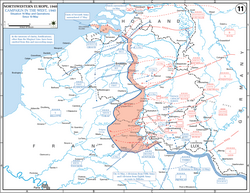
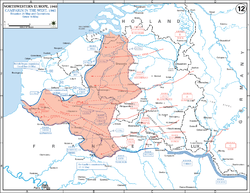
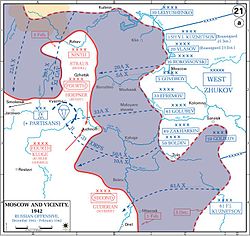
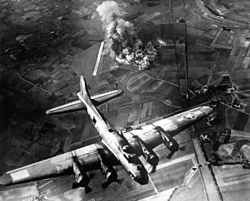
 KSF
KSF